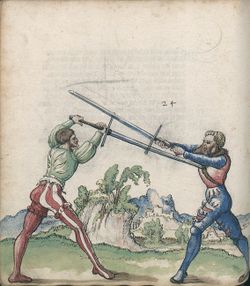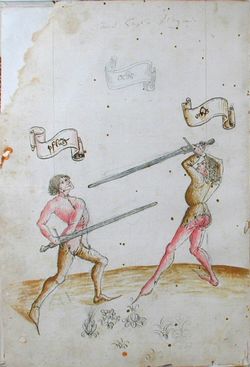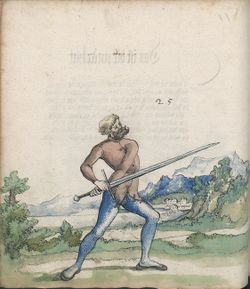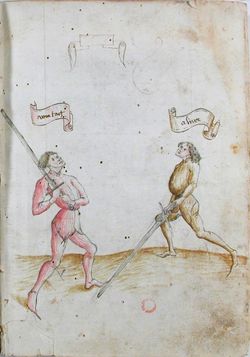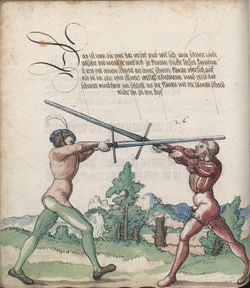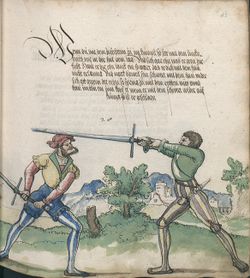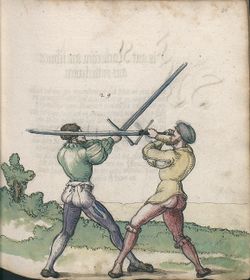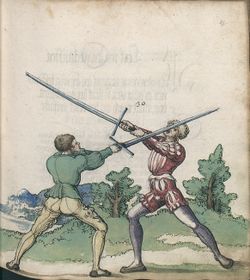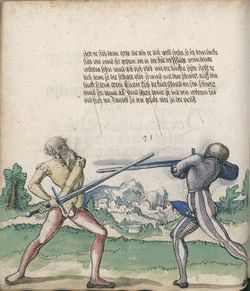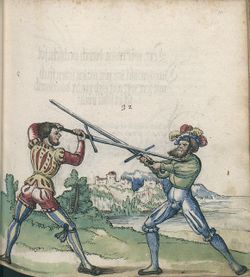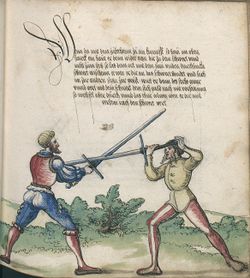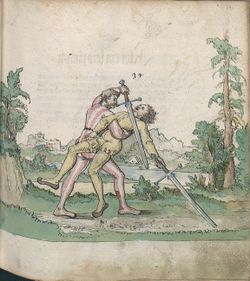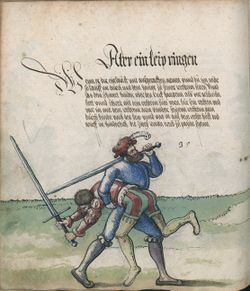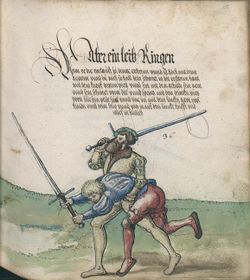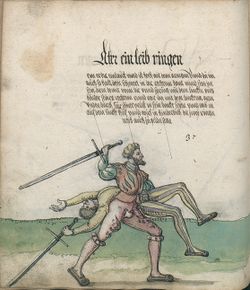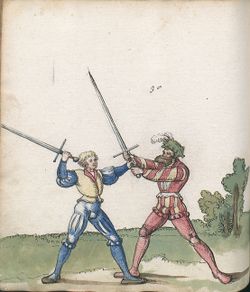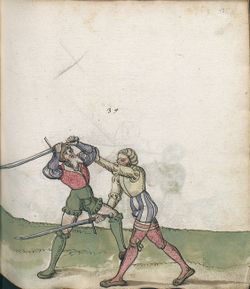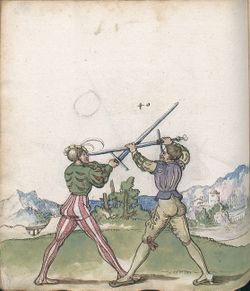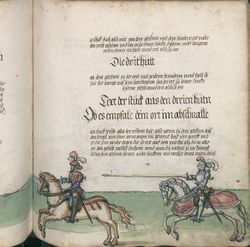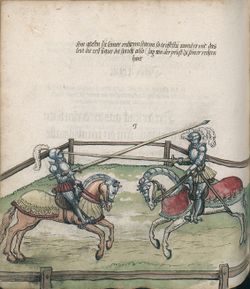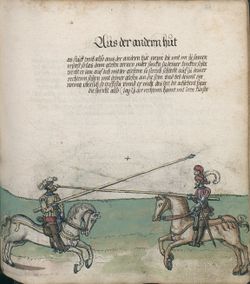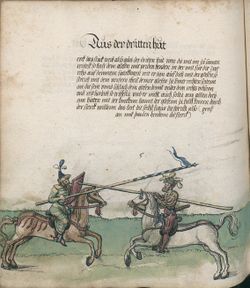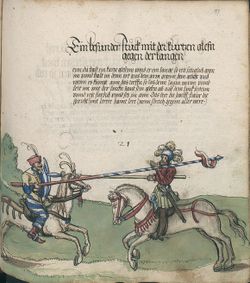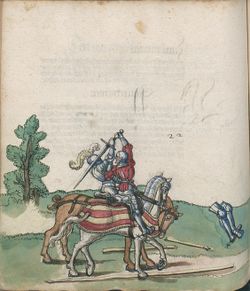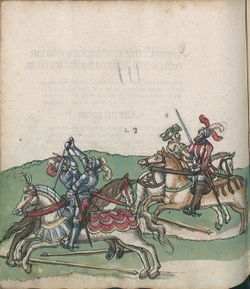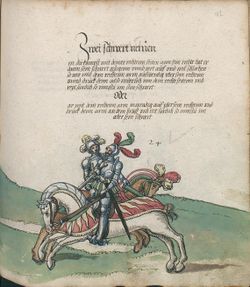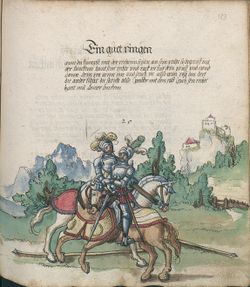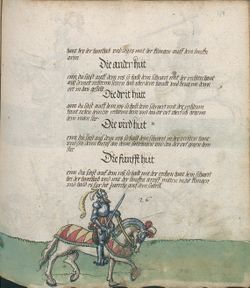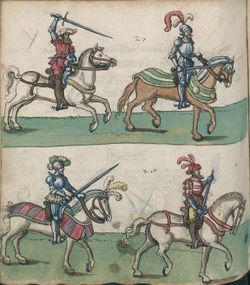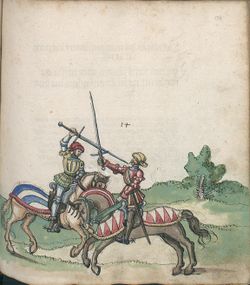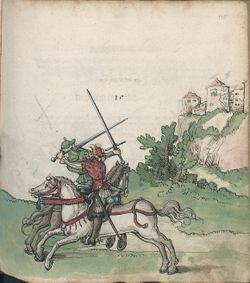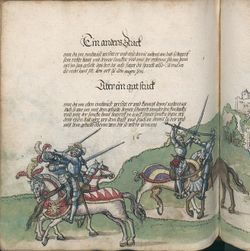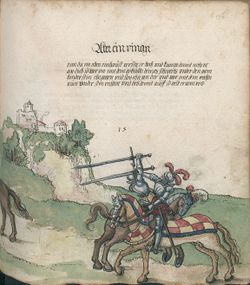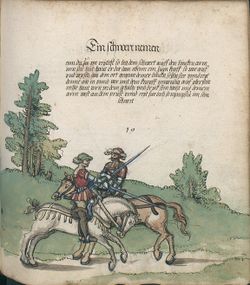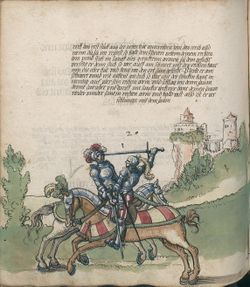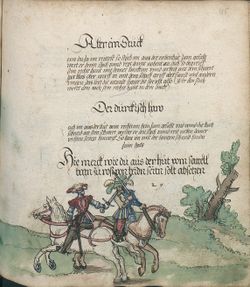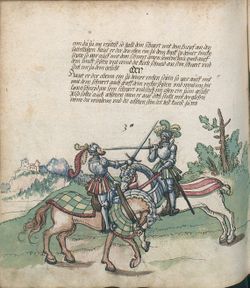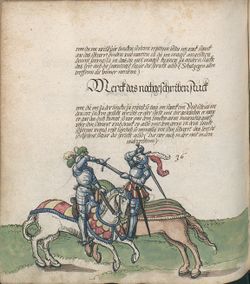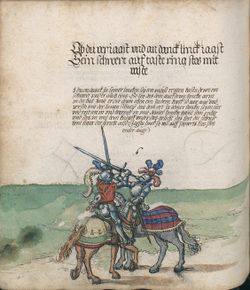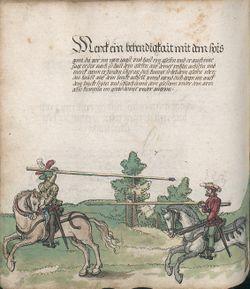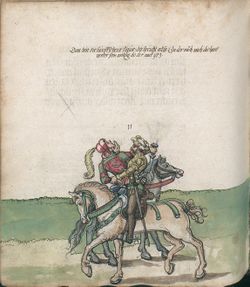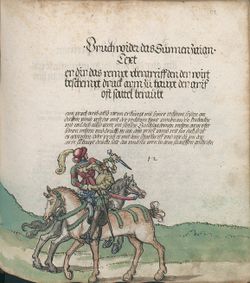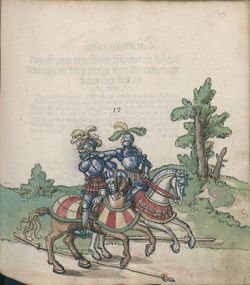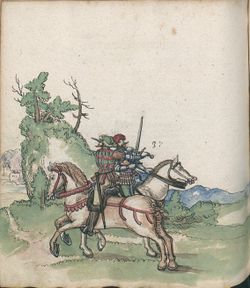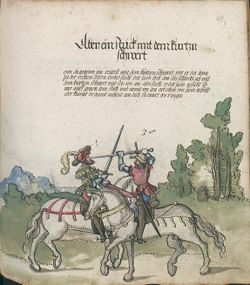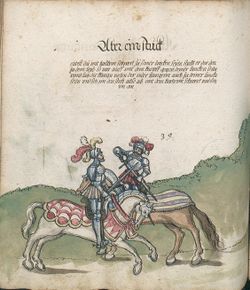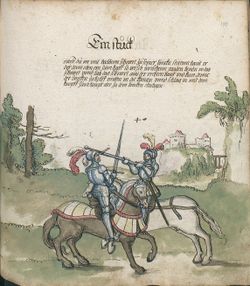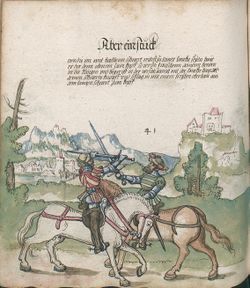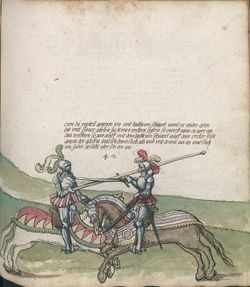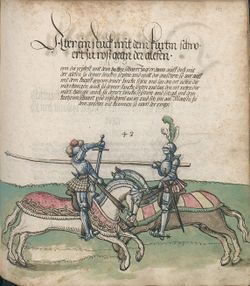|
|
You are not currently logged in. Are you accessing the unsecure (http) portal? Click here to switch to the secure portal. |
Difference between revisions of "Pseudo-Peter von Danzig"
| Line 1,377: | Line 1,377: | ||
<p>When he has bound on your sword, if he then stands against you in the bind and waits to see if you yourself will draw off from the sword, then do as if you will Pull, but remain on his sword, and Pull your sword on you as far as half the blade, and stab in quickly again into the face or the breast. If you do not hit him correctly with the stab, then work with the Doubling or otherwise with other techniques which are best.</p> | <p>When he has bound on your sword, if he then stands against you in the bind and waits to see if you yourself will draw off from the sword, then do as if you will Pull, but remain on his sword, and Pull your sword on you as far as half the blade, and stab in quickly again into the face or the breast. If you do not hit him correctly with the stab, then work with the Doubling or otherwise with other techniques which are best.</p> | ||
| {{section|Page:Cod.44.A.8 032r.jpg|2|lbl=-}} | | {{section|Page:Cod.44.A.8 032r.jpg|2|lbl=-}} | ||
| − | | | + | | <p><br/></p> |
| + | |||
| + | {{section|Page:MS KK5126 112r.jpg|2|lbl=-}} | ||
| | | | ||
| | | | ||
| Line 1,392: | Line 1,394: | ||
{{section|Page:Cod.44.A.8 032v.jpg|1|lbl=32v}} | {{section|Page:Cod.44.A.8 032v.jpg|1|lbl=32v}} | ||
| − | | | + | | {{section|Page:MS KK5126 112r.jpg|3|lbl=-}} |
| | | | ||
| | | | ||
| Line 1,402: | Line 1,404: | ||
<p>Mark, when he runs into you and drives high up with the arms and will overwhelm you above with strength, then drive also up with the arms, and hold your sword by the pommel over your head with your left hand and let the blade hang down behind over your back, and Run with your head through your arm against his right side, and spring with your right foot behind his right, and with the spring then drive in with your right arm against his left side in front, well around his body, and grasp him thus on your right hip and throw him before you backwards on his head.</p> | <p>Mark, when he runs into you and drives high up with the arms and will overwhelm you above with strength, then drive also up with the arms, and hold your sword by the pommel over your head with your left hand and let the blade hang down behind over your back, and Run with your head through your arm against his right side, and spring with your right foot behind his right, and with the spring then drive in with your right arm against his left side in front, well around his body, and grasp him thus on your right hip and throw him before you backwards on his head.</p> | ||
| {{section|Page:Cod.44.A.8 032v.jpg|2|lbl=-}} | | {{section|Page:Cod.44.A.8 032v.jpg|2|lbl=-}} | ||
| − | | | + | | {{section|Page:MS KK5126 112r.jpg|4|lbl=-}} |
| | | | ||
| {{section|Page:Cod.I.6.2º.2 67v.jpg|1|lbl=67v}} | | {{section|Page:Cod.I.6.2º.2 67v.jpg|1|lbl=67v}} | ||
| Line 1,413: | Line 1,415: | ||
| | | | ||
{{section|Page:Cod.44.A.8 032v.jpg|3|lbl=-|p=1}} {{section|Page:Cod.44.A.8 033r.jpg|1|lbl=33r|p=1}} | {{section|Page:Cod.44.A.8 032v.jpg|3|lbl=-|p=1}} {{section|Page:Cod.44.A.8 033r.jpg|1|lbl=33r|p=1}} | ||
| − | | | + | | <p><br/></p> |
| + | |||
| + | {{section|Page:MS KK5126 112r.jpg|5|lbl=-}} | ||
| | | | ||
| {{section|Page:Cod.I.6.2º.2 68v.jpg|1|lbl=68v}} | | {{section|Page:Cod.I.6.2º.2 68v.jpg|1|lbl=68v}} | ||
| Line 1,444: | Line 1,448: | ||
| | | | ||
{{section|Page:Cod.44.A.8 033r.jpg|4|lbl=-|p=1}} {{section|Page:Cod.44.A.8 033v.jpg|1|lbl=33v|p=1}} | {{section|Page:Cod.44.A.8 033r.jpg|4|lbl=-|p=1}} {{section|Page:Cod.44.A.8 033v.jpg|1|lbl=33v|p=1}} | ||
| − | | | + | | {{section|Page:MS KK5126 112r.jpg|6|lbl=-}} |
| | | | ||
| | | | ||
| Line 1,454: | Line 1,458: | ||
<p>If you will not strike, then spring with the right foot behind his left and drive in with the right arm in front or behind his neck and throw him thus over your right knee.</p> | <p>If you will not strike, then spring with the right foot behind his left and drive in with the right arm in front or behind his neck and throw him thus over your right knee.</p> | ||
| {{section|Page:Cod.44.A.8 033v.jpg|2|lbl=-}} | | {{section|Page:Cod.44.A.8 033v.jpg|2|lbl=-}} | ||
| − | | | + | | {{section|Page:MS KK5126 112r.jpg|7|lbl=-}} |
| | | | ||
| | | | ||
| Line 1,464: | Line 1,468: | ||
<p>Mark, when he runs into you with the sword and is low with the hands, then let your left hand drive from the sword, and drive in with the right with the pommel out over his right hand and press therewith down, and grip him with the left hand by his right elbow, and spring with the left foot before his right and thrust him over thus.</p> | <p>Mark, when he runs into you with the sword and is low with the hands, then let your left hand drive from the sword, and drive in with the right with the pommel out over his right hand and press therewith down, and grip him with the left hand by his right elbow, and spring with the left foot before his right and thrust him over thus.</p> | ||
| {{section|Page:Cod.44.A.8 033v.jpg|3|lbl=-}} | | {{section|Page:Cod.44.A.8 033v.jpg|3|lbl=-}} | ||
| − | | | + | | <p><br/></p> |
| + | |||
| + | {{section|Page:MS KK5126 112r.jpg|8|lbl=-|p=1}} {{section|Page:MS KK5126 112v.jpg|1|lbl=112v|p=1}} | ||
| | | | ||
| | | | ||
| Line 1,474: | Line 1,480: | ||
<p>Mark, when he runs into you with the sword, then let your sword fall and invert your right hand and grip his right outwardly therewith, and with the left grasp him by the right elbow, and spring with the left foot before his right, and thrust his right arm over your left with the right hand, and heave him over you therewith. Thus may you break his arm or throw him over the left leg before you if you want.</p> | <p>Mark, when he runs into you with the sword, then let your sword fall and invert your right hand and grip his right outwardly therewith, and with the left grasp him by the right elbow, and spring with the left foot before his right, and thrust his right arm over your left with the right hand, and heave him over you therewith. Thus may you break his arm or throw him over the left leg before you if you want.</p> | ||
| {{section|Page:Cod.44.A.8 033v.jpg|4|lbl=-}} | | {{section|Page:Cod.44.A.8 033v.jpg|4|lbl=-}} | ||
| − | | | + | | <p><br/></p> |
| + | |||
| + | {{section|Page:MS KK5126 112v.jpg|2|lbl=-}} | ||
| + | |||
| + | {{section|Page:MS KK5126 112v.jpg|3|lbl=-}} | ||
| | | | ||
| | | | ||
| Line 1,486: | Line 1,496: | ||
{{section|Page:Cod.44.A.8 034r.jpg|1|lbl=34r}} | {{section|Page:Cod.44.A.8 034r.jpg|1|lbl=34r}} | ||
| − | | | + | | <p><br/></p> |
| + | |||
| + | {{section|Page:MS KK5126 112v.jpg|4|lbl=-}} | ||
| | | | ||
| | | | ||
| Line 1,496: | Line 1,508: | ||
<p>Mark, when he parries or otherwise binds on your sword, then grip both swords in the middle with the left hand on the blades, and hold them both fast together, and with the right hand drive with the pommel below through in front over both his hands, and press therewith upwards on your right side. Then you remain with both swords.</p> | <p>Mark, when he parries or otherwise binds on your sword, then grip both swords in the middle with the left hand on the blades, and hold them both fast together, and with the right hand drive with the pommel below through in front over both his hands, and press therewith upwards on your right side. Then you remain with both swords.</p> | ||
| {{section|Page:Cod.44.A.8 034r.jpg|2|lbl=-}} | | {{section|Page:Cod.44.A.8 034r.jpg|2|lbl=-}} | ||
| − | | | + | | {{section|Page:MS KK5126 112v.jpg|6|lbl=-}} |
| | | | ||
| | | | ||
| Line 1,509: | Line 1,521: | ||
| | | | ||
{{section|Page:Cod.44.A.8 034r.jpg|3|lbl=-|p=1}} {{section|Page:Cod.44.A.8 034v.jpg|1|lbl=34v|p=1}} | {{section|Page:Cod.44.A.8 034r.jpg|3|lbl=-|p=1}} {{section|Page:Cod.44.A.8 034v.jpg|1|lbl=34v|p=1}} | ||
| − | | | + | | {{section|Page:MS KK5126 112v.jpg|5|lbl=-}} |
| | | | ||
| | | | ||
| Line 1,519: | Line 1,531: | ||
<p>When you fence-to him with Under-hewing, or lie in the guard Fool, if he then falls with the sword on yours nearby the hilt before you therewith come up, so that his point goes out to your right side, then drive up nimbly with the pommel over his sword and strike with the long edge to his head. Or if he binds on your sword so that his point goes out to your left side, then drive with the pommel over his sword and strike in with the short edge to his head. That is called the Snapping.</p> | <p>When you fence-to him with Under-hewing, or lie in the guard Fool, if he then falls with the sword on yours nearby the hilt before you therewith come up, so that his point goes out to your right side, then drive up nimbly with the pommel over his sword and strike with the long edge to his head. Or if he binds on your sword so that his point goes out to your left side, then drive with the pommel over his sword and strike in with the short edge to his head. That is called the Snapping.</p> | ||
| {{section|Page:Cod.44.A.8 034v.jpg|2|lbl=-}} | | {{section|Page:Cod.44.A.8 034v.jpg|2|lbl=-}} | ||
| − | | | + | | <p><br/></p> |
| + | |||
| + | {{section|Page:MS KK5126 112v.jpg|7|lbl=-}} | ||
| | | | ||
| | | | ||
| Line 1,532: | Line 1,546: | ||
| | | | ||
{{section|Page:Cod.44.A.8 034v.jpg|3|lbl=-|p=1}} {{section|Page:Cod.44.A.8 035r.jpg|1|lbl=35r|p=1}} | {{section|Page:Cod.44.A.8 034v.jpg|3|lbl=-|p=1}} {{section|Page:Cod.44.A.8 035r.jpg|1|lbl=35r|p=1}} | ||
| − | | | + | | {{section|Page:MS KK5126 112v.jpg|8|lbl=-}} |
| | | | ||
| | | | ||
| Line 1,542: | Line 1,556: | ||
<p>When he binds you on your sword to your left side and strikes therewith quickly again around with the left foot on your right side, then fall in with the long edge above over both arms and press with the slice from you. You shall always drive that to both sides when he strikes around from the parrying, or hews from the sword.</p> | <p>When he binds you on your sword to your left side and strikes therewith quickly again around with the left foot on your right side, then fall in with the long edge above over both arms and press with the slice from you. You shall always drive that to both sides when he strikes around from the parrying, or hews from the sword.</p> | ||
| {{section|Page:Cod.44.A.8 035r.jpg|2|lbl=-}} | | {{section|Page:Cod.44.A.8 035r.jpg|2|lbl=-}} | ||
| − | | | + | | {{section|Page:MS KK5126 112v.jpg|9|lbl=-}} |
| | | | ||
| | | | ||
| Line 1,552: | Line 1,566: | ||
<p>That the two Under-slices pertain to driving against the fencers that like to run in with outstretched arms, that drive thus: when he binds on your sword and drives high up with the arms and runs into you on your left side, then invert your sword so that your thumb comes below, and fall in with the long edge under the pommel in his arm and press upward with the slice.</p> | <p>That the two Under-slices pertain to driving against the fencers that like to run in with outstretched arms, that drive thus: when he binds on your sword and drives high up with the arms and runs into you on your left side, then invert your sword so that your thumb comes below, and fall in with the long edge under the pommel in his arm and press upward with the slice.</p> | ||
| {{section|Page:Cod.44.A.8 035r.jpg|3|lbl=-}} | | {{section|Page:Cod.44.A.8 035r.jpg|3|lbl=-}} | ||
| − | | | + | | <p><br/></p> |
| + | |||
| + | {{section|Page:MS KK5126 112v.jpg|10|lbl=-|p=1}} {{section|Page:MS KK5126 113r.jpg|1|lbl=113r|p=1}} | ||
| | | | ||
| | | | ||
| Line 1,560: | Line 1,576: | ||
| <p>[133] {{red|b=1|Or}} if he runs with out-stretched arms to your right side, then invert your sword so that your thumb comes below and fall in with the short edge under his pommel in the arms and press upwards with the slice. Those are the Four Slices.</p> | | <p>[133] {{red|b=1|Or}} if he runs with out-stretched arms to your right side, then invert your sword so that your thumb comes below and fall in with the short edge under his pommel in the arms and press upwards with the slice. Those are the Four Slices.</p> | ||
| {{section|Page:Cod.44.A.8 035r.jpg|4|lbl=-}} | | {{section|Page:Cod.44.A.8 035r.jpg|4|lbl=-}} | ||
| − | | | + | | {{section|Page:MS KK5126 113r.jpg|2|lbl=-}} |
| | | | ||
| | | | ||
| Line 1,574: | Line 1,590: | ||
{{section|Page:Cod.44.A.8 035v.jpg|1|lbl=35v}} | {{section|Page:Cod.44.A.8 035v.jpg|1|lbl=35v}} | ||
| − | | | + | | {{section|Page:MS KK5126 113r.jpg|3|lbl=-}} |
| | | | ||
| | | | ||
| Line 1,582: | Line 1,598: | ||
| <p>[135] {{red|b=1|Or,}} if he runs in with up-stretched arms to your right side, then turn your sword against his arms under the pommel with the short edge and press fast upwards, and step therewith on his left side and let the pommel go through below and turn your sword with the long edge over his arm and press from you with the slice.</p> | | <p>[135] {{red|b=1|Or,}} if he runs in with up-stretched arms to your right side, then turn your sword against his arms under the pommel with the short edge and press fast upwards, and step therewith on his left side and let the pommel go through below and turn your sword with the long edge over his arm and press from you with the slice.</p> | ||
| {{section|Page:Cod.44.A.8 035v.jpg|2|lbl=-}} | | {{section|Page:Cod.44.A.8 035v.jpg|2|lbl=-}} | ||
| − | | | + | | {{section|Page:MS KK5126 113r.jpg|4|lbl=-}} |
| | | | ||
| | | | ||
| Line 1,596: | Line 1,612: | ||
{{section|Page:Cod.44.A.8 036r.jpg|1|lbl=-}} | {{section|Page:Cod.44.A.8 036r.jpg|1|lbl=-}} | ||
| − | | | + | | {{section|Page:MS KK5126 113r.jpg|5|lbl=-}} |
| | | | ||
| | | | ||
| Line 1,604: | Line 1,620: | ||
| <p>[137] Also you shall therefrom drive the four Windings, and from each Winding feature a hew, a stab, and a slice, and otherwise also drive all driving as from the two upper hangings.</p> | | <p>[137] Also you shall therefrom drive the four Windings, and from each Winding feature a hew, a stab, and a slice, and otherwise also drive all driving as from the two upper hangings.</p> | ||
| {{section|Page:Cod.44.A.8 036r.jpg|2|lbl=-}} | | {{section|Page:Cod.44.A.8 036r.jpg|2|lbl=-}} | ||
| − | | | + | | {{section|Page:MS KK5126 113r.jpg|6|lbl=-}} |
| | | | ||
| | | | ||
| Line 1,617: | Line 1,633: | ||
| | | | ||
{{section|Page:Cod.44.A.8 036r.jpg|3|lbl=-|p=1}} {{section|Page:Cod.44.A.8 036v.jpg|1|lbl=36v|p=1}} | {{section|Page:Cod.44.A.8 036r.jpg|3|lbl=-|p=1}} {{section|Page:Cod.44.A.8 036v.jpg|1|lbl=36v|p=1}} | ||
| − | | | + | | {{section|Page:MS KK5126 113r.jpg|7|lbl=-}} |
| | | | ||
| | | | ||
| Line 1,627: | Line 1,643: | ||
<p>When you go to him with the pre-fencing with whatever hew you then come on him, whether it be a Under or an Over-hew, then let the long point always shoot in to the face or the breast with the hew. Therewith you force him so that he must parry you, or bind on the sword, and when he thus has bound on, then remain strongly with the long edge on the sword and stand freely and see his business; what he further against you will fence. If he pulls off backwards from the sword, then follow after him with the point to the opening. Or, if he strikes around from the sword to the other side, then bind after his hew strongly above to his head. Or, if he will not draw off from the sword or strike around, then work with the Doubling or otherwise with other techniques thereafter as you find him soft or hard on the sword.</p> | <p>When you go to him with the pre-fencing with whatever hew you then come on him, whether it be a Under or an Over-hew, then let the long point always shoot in to the face or the breast with the hew. Therewith you force him so that he must parry you, or bind on the sword, and when he thus has bound on, then remain strongly with the long edge on the sword and stand freely and see his business; what he further against you will fence. If he pulls off backwards from the sword, then follow after him with the point to the opening. Or, if he strikes around from the sword to the other side, then bind after his hew strongly above to his head. Or, if he will not draw off from the sword or strike around, then work with the Doubling or otherwise with other techniques thereafter as you find him soft or hard on the sword.</p> | ||
| {{section|Page:Cod.44.A.8 036v.jpg|2|lbl=-}} | | {{section|Page:Cod.44.A.8 036v.jpg|2|lbl=-}} | ||
| − | | | + | | {{section|Page:MS KK5126 113r.jpg|9|lbl=-}} |
| + | |||
| + | {{section|Page:MS KK5126 113v.jpg|1|lbl=113v}} | ||
| | | | ||
| | | | ||
| Line 1,637: | Line 1,655: | ||
<p>And is also called the Speaking-Window. Mark, when you just about come to him with the pre-fencing, then set the left foot before and hold the long point with the arms against his face or his breast before you bind him on the sword, and stand freely and see what he will fence against you. If he then hews long above in to the head, then drive up and Wind against his hew with the sword in the Ox, and stab into his face. Or if he hews to your sword and not to your body, then Change through and stab in to the other side. If he runs in and is high with the arms, then drive the Under-slice. Or if he runs in through with wrestling and is low with the arms, then drive the arm wrestling. Thus you may drive all techniques from the Long Point. If he is low with the arms, then await the arm wrestling. Thus you may drive all techniques from the Long Point.</p> | <p>And is also called the Speaking-Window. Mark, when you just about come to him with the pre-fencing, then set the left foot before and hold the long point with the arms against his face or his breast before you bind him on the sword, and stand freely and see what he will fence against you. If he then hews long above in to the head, then drive up and Wind against his hew with the sword in the Ox, and stab into his face. Or if he hews to your sword and not to your body, then Change through and stab in to the other side. If he runs in and is high with the arms, then drive the Under-slice. Or if he runs in through with wrestling and is low with the arms, then drive the arm wrestling. Thus you may drive all techniques from the Long Point. If he is low with the arms, then await the arm wrestling. Thus you may drive all techniques from the Long Point.</p> | ||
| {{section|Page:Cod.44.A.8 036v.jpg|3|lbl=-|p=1}} {{section|Page:Cod.44.A.8 037r.jpg|1|lbl=37r|p=1}} | | {{section|Page:Cod.44.A.8 036v.jpg|3|lbl=-|p=1}} {{section|Page:Cod.44.A.8 037r.jpg|1|lbl=37r|p=1}} | ||
| − | | | + | | {{section|Page:MS KK5126 113r.jpg|8|lbl=113r}} |
| | | | ||
| | | | ||
| Line 1,650: | Line 1,668: | ||
| | | | ||
{{section|Page:Cod.44.A.8 037r.jpg|2|lbl=-|p=1}} {{section|Page:Cod.44.A.8 037v.jpg|1|lbl=37v|p=1}} | {{section|Page:Cod.44.A.8 037r.jpg|2|lbl=-|p=1}} {{section|Page:Cod.44.A.8 037v.jpg|1|lbl=37v|p=1}} | ||
| − | | | + | | {{section|Page:MS KK5126 113v.jpg|2|lbl=113v}} |
| | | | ||
| | | | ||
| Line 1,660: | Line 1,678: | ||
<p>These are the first two Windings from the Ox on the right side alone, drive them thus: When you come to him with the pre-fencing, then stand with the left foot before and hold your sword on your right side before your head in the Ox. If he then hews from above on his right side, then Wind on your left side against his hew with the short edge on his sword, yet still in the Ox, and stab above into the face. This is one Winding.</p> | <p>These are the first two Windings from the Ox on the right side alone, drive them thus: When you come to him with the pre-fencing, then stand with the left foot before and hold your sword on your right side before your head in the Ox. If he then hews from above on his right side, then Wind on your left side against his hew with the short edge on his sword, yet still in the Ox, and stab above into the face. This is one Winding.</p> | ||
| {{section|Page:Cod.44.A.8 037v.jpg|2|lbl=-}} | | {{section|Page:Cod.44.A.8 037v.jpg|2|lbl=-}} | ||
| − | | | + | | {{section|Page:MS KK5126 113v.jpg|3|lbl=-}} |
| | | | ||
| | | | ||
| Line 1,671: | Line 1,689: | ||
| | | | ||
{{section|Page:Cod.44.A.8 037v.jpg|3|lbl=-|p=1}} {{section|Page:Cod.44.A.8 038r.jpg|1|lbl=38r|p=1}} | {{section|Page:Cod.44.A.8 037v.jpg|3|lbl=-|p=1}} {{section|Page:Cod.44.A.8 038r.jpg|1|lbl=38r|p=1}} | ||
| − | | | + | | <p><br/></p> |
| + | |||
| + | {{section|Page:MS KK5126 113v.jpg|4|lbl=-}} | ||
| | | | ||
| | | | ||
| Line 1,681: | Line 1,701: | ||
<p>When you come to him with the pre-fencing, then stand on your left side in the Ox, and if he hews then above in from his left side, then Wind against his hew on your right side with the long edge on his sword and stab above in to the face. That is one Winding.</p> | <p>When you come to him with the pre-fencing, then stand on your left side in the Ox, and if he hews then above in from his left side, then Wind against his hew on your right side with the long edge on his sword and stab above in to the face. That is one Winding.</p> | ||
| {{section|Page:Cod.44.A.8 038r.jpg|2|lbl=-}} | | {{section|Page:Cod.44.A.8 038r.jpg|2|lbl=-}} | ||
| − | | | + | | {{section|Page:MS KK5126 113v.jpg|5|lbl=-}} |
| | | | ||
| | | | ||
| Line 1,691: | Line 1,711: | ||
<p>If he parries the stab and presses your sword to the side, then remain on the sword and Wind on your left side yet in the Ox with the long edge on his sword, and stab in above to the face. These are the four Windings from the upper two hangers on the left and on the right side.</p> | <p>If he parries the stab and presses your sword to the side, then remain on the sword and Wind on your left side yet in the Ox with the long edge on his sword, and stab in above to the face. These are the four Windings from the upper two hangers on the left and on the right side.</p> | ||
| {{section|Page:Cod.44.A.8 038r.jpg|3|lbl=-}} | | {{section|Page:Cod.44.A.8 038r.jpg|3|lbl=-}} | ||
| − | | | + | | <p><br/></p> |
| + | |||
| + | {{section|Page:MS KK5126 113v.jpg|6|lbl=-|p=1}} {{section|Page:MS KK5126 114r.jpg|1|lbl=114r|p=1}} | ||
| | | | ||
| | | | ||
| Line 1,702: | Line 1,724: | ||
| | | | ||
{{section|Page:Cod.44.A.8 038r.jpg|4|lbl=-|p=1}} {{section|Page:Cod.44.A.8 038v.jpg|1|lbl=38v|p=1}} | {{section|Page:Cod.44.A.8 038r.jpg|4|lbl=-|p=1}} {{section|Page:Cod.44.A.8 038v.jpg|1|lbl=38v|p=1}} | ||
| − | | | + | | {{section|Page:MS KK5126 114r.jpg|2|lbl=-}} |
| | | | ||
| | | | ||
| Line 1,711: | Line 1,733: | ||
<p>That you may not rightly drive the Eight Windings except with stepping from both sides, and that you prove not more than the two drivings well before, which are when he binds on your sword, he is but Soft or Hard in his driving. When you have found that first, then Wind and work to the Four Openings as described before states. Also know that all fencers that Wind on the sword and cannot Feel on the sword, they become struck by the Winding. Therefore be diligent so that you well mark the Feeling and the word Meanwhile, when from these two things go all the Art of Fencing.</p> | <p>That you may not rightly drive the Eight Windings except with stepping from both sides, and that you prove not more than the two drivings well before, which are when he binds on your sword, he is but Soft or Hard in his driving. When you have found that first, then Wind and work to the Four Openings as described before states. Also know that all fencers that Wind on the sword and cannot Feel on the sword, they become struck by the Winding. Therefore be diligent so that you well mark the Feeling and the word Meanwhile, when from these two things go all the Art of Fencing.</p> | ||
| − | | {{section|Page:Cod.44.A.8 038v.jpg|2|lbl=38v|p= | + | | {{section|Page:Cod.44.A.8 038v.jpg|2|lbl=38v}} |
| − | + | | <p><br/></p> | |
| + | |||
| + | {{section|Page:MS KK5126 114r.jpg|3|lbl=-}} | ||
| | | | ||
| | | | ||
| Line 1,770: | Line 1,794: | ||
{{section|Page:Cod.44.A.8 039v.jpg|2|lbl=-|p=1}} {{section|Page:Cod.44.A.8 040r.jpg|1|lbl=40r|p=1}} | {{section|Page:Cod.44.A.8 039v.jpg|2|lbl=-|p=1}} {{section|Page:Cod.44.A.8 040r.jpg|1|lbl=40r|p=1}} | ||
| | | | ||
| + | {{section|Page:MS KK5126 114r.jpg|4|lbl=114r|p=1}} {{section|Page:MS KK5126 114r.jpg|7|lbl=-}} | ||
| | | | ||
| | | | ||
| Line 1,777: | Line 1,802: | ||
| | | | ||
| {{section|Page:Cod.44.A.8 040r.jpg|2|lbl=-}} | | {{section|Page:Cod.44.A.8 040r.jpg|2|lbl=-}} | ||
| − | + | | {{section|Page:MS KK5126 114r.jpg|5|lbl=-}} | |
| − | |||
| − | |||
| − | |||
| − | |||
| − | |||
| − | |||
| − | | {{section|Page: | ||
| − | |||
| | | | ||
| | | | ||
| Line 1,793: | Line 1,810: | ||
| | | | ||
| {{section|Page:Cod.44.A.8 040r.jpg|3|lbl=-}} | | {{section|Page:Cod.44.A.8 040r.jpg|3|lbl=-}} | ||
| − | | | + | | {{section|Page:MS KK5126 114r.jpg|6|lbl=-}} |
| | | | ||
| | | | ||
| Line 1,800: | Line 1,817: | ||
| | | | ||
| {{section|Page:Cod.44.A.8 040r.jpg|4|lbl=-}} | | {{section|Page:Cod.44.A.8 040r.jpg|4|lbl=-}} | ||
| − | | | + | | {{section|Page:MS KK5126 114r.jpg|8|lbl=-}} |
| | | | ||
| | | | ||
| Line 1,809: | Line 1,826: | ||
| | | | ||
{{section|Page:Cod.44.A.8 040r.jpg|5|lbl=-|p=1}} {{section|Page:Cod.44.A.8 040v.jpg|1|lbl=40v|p=1}} | {{section|Page:Cod.44.A.8 040r.jpg|5|lbl=-|p=1}} {{section|Page:Cod.44.A.8 040v.jpg|1|lbl=40v|p=1}} | ||
| − | | | + | | {{section|Page:MS KK5126 114r.jpg|9|lbl=-}} |
| | | | ||
| | | | ||
| Line 1,817: | Line 1,834: | ||
| | | | ||
| {{section|Page:Cod.44.A.8 040v.jpg|2|lbl=-}} | | {{section|Page:Cod.44.A.8 040v.jpg|2|lbl=-}} | ||
| − | | | + | | {{section|Page:MS KK5126 114r.jpg|10|lbl=-}} |
| | | | ||
| | | | ||
| Line 1,825: | Line 1,842: | ||
| | | | ||
| {{section|Page:Cod.44.A.8 040v.jpg|3|lbl=-}} | | {{section|Page:Cod.44.A.8 040v.jpg|3|lbl=-}} | ||
| − | | | + | | {{section|Page:MS KK5126 114r.jpg|11|lbl=-}} |
| | | | ||
| | | | ||
| Line 1,833: | Line 1,850: | ||
| | | | ||
| {{section|Page:Cod.44.A.8 040ar.jpg|1|lbl=40ar}} | | {{section|Page:Cod.44.A.8 040ar.jpg|1|lbl=40ar}} | ||
| − | | | + | | {{section|Page:MS KK5126 114r.jpg|12|lbl=-}} |
| + | |||
| + | {{section|Page:MS KK5126 114v.jpg|1|lbl=114v}} | ||
| | | | ||
| | | | ||
| Line 2,433: | Line 2,452: | ||
|- | |- | ||
| − | | | + | | [[File:Cod.44.A.8 002v.jpg|250px|center]] |
| <p>{{red|b=1|All raise yourself here to the analysis and interpretation of the verses on the art of combat fencing}}</p> | | <p>{{red|b=1|All raise yourself here to the analysis and interpretation of the verses on the art of combat fencing}}</p> | ||
Revision as of 02:30, 19 May 2016
| Gloss and Interpretation of the Recital on the Long Sword | |
|---|---|
| die gloss und die auslegung der zettel des langen schwert | |
| Author(s) | Unknown |
| Ascribed to | Pseudo-Peter von Danzig |
| Illustrated by | Unknown |
| Date | before 1452 |
| Genre | |
| Language | Early New High German |
| Archetype(s) | Hypothetical |
| Principal Manuscript(s) |
|
| Manuscript(s) |
|
| First Printed English Edition |
Tobler, 2010 |
| Concordance by | Michael Chidester |
| Translations | |
 |
Caution: Scribes at Work This article is in the process of updates, expansion, or major restructuring. Please forgive any broken features or formatting errors while these changes are underway. To help avoid edit conflicts, please do not edit this page while this message is displayed. Stay tuned for the announcement of the revised content! This article was last edited by Michael Chidester (talk| contribs) at 02:30, 19 May 2016 (UTC). (Update) |
"Pseudo-Peter von Danzig" is the name given to an anonymous late 14th or early 15th century German fencing master.[1] Some time before the creation of the Codex 44.A.8 in 1452, he authored a gloss of Johannes Liechtenauer's Recital (Zettel) which would go on to become the most widespread in the tradition. While his identity remains unknown, it is possible that he was in fact Jud Lew or Sigmund Schining ein Ringeck, both of whose glosses show strong similarities to the work. On the other hand, the introduction to the Rome version of the text—the oldest currently extant—might be construed as attributing it to Liechtenauer himself.
Contents
Treatise
Early on in its history, Pseudo-Peter von Danzig's gloss seems to have split into two primary branches, and no definite copies of the unaltered original are known to survive. The gloss of Sigmund Schining ain Ringeck also seems to be related to this work, due to the considerable overlap in text and contents, but the exact nature of this relationship is currently unclear.
Branch A, appearing first in the Augsburg version (1450s) and comprising the majority of extant copies, has more devices overall than the other branch (particularly in the extensive Salzburg version of 1491) but generally shorter descriptions in areas of overlap. It also includes glosses of Liechtenauer's Recital on long sword and mounted fencing only, and in lieu of a gloss of Liechtenauer's short sword it is generally accompanied by the short sword teachings of Andre Liegniczer and Martin Huntfeltz. Apart from containing the most content, the Salzburg version is notable for including nine paragraphs of text that are not found in any other version of Pseudo-Peter von Danzig but do appear in Ringeck; this predates all known copies of Ringeck's text, but is another indicator of some connection between the works. Branch A was later used by Johannes Lecküchner as a source when he compiled his own gloss of a Recital on the Messer.
Branch B, appearing first in the Rome version (1452), is found in only four manuscripts; it has slightly longer descriptions than Branch A, but fewer devices overall. Branch B glosses Liechtenauer's entire Recital, including the short sword section, and may therefore be considered more complete than Branch A; it also different from Branch A in that three of the four known copies are illustrated to some extent where none in the other branch are. The Krakow version (1510-20) seems to be an incomplete (though extensively illustrated) copy taken directly from the Rome, while Augsburg II (1564) is taken from the Krakow but only includes the six illustrated devices of wrestling from the Krakow and their respective captions. Even more anomalous is the Glasgow version, which only consists of a sizeable fragment of the short sword gloss (hence its assignation to Branch B), and this is appended to a fragment of Ringeck's short sword gloss; since it accompanies Ringeck's long sword and mounted fencing glosses, a possible explanation is that the scribe lacked a complete copy of Ringeck's short sword gloss and tried to fill in the deficit with another similar text.
There is one version of the Pseudo-Peter von Danzig gloss that defies categorization into either branch, namely the Vienna version included in a 1480 manuscript along with Paulus Kal's work (Kal's personal level of involvement is unknown). The text of this version is more consistent with the generally shorter descriptions of Branch A, but the overall contents more closely match Branch B, lacking most of the unique devices of Branch A and including the gloss of the short sword. The Vienna version may therefore be a copy of the original gloss before it split into these branches (or it may merely be an odd attempt by a scribe to synthesize the two branches into a single, shorter work).
While Branches A and B were formerly presented in a single concordance in this article, the differences between them were revealed thereby to be extensive enough that they merit separate consideration. Thus Branch A has been placed on the page of Jud Lew, to whom is seemingly attributed the gloss on mounted fencing, while Branch B has been retained here. As the Vienna version cannot be cleanly assigned to one branch or the other, it appears in both concordances for comparative purposes.
Images |
Rome Version (1452) |
Vienna Version (1480s) |
Krakow Version (1510-20) |
Augsburg Version (1564) | |
|---|---|---|---|---|---|
[1] Here begins the gloss and the interpretation of the Epitome of the Long Sword This has been composed and created by Johannes Liechtenauer, the one High Master in the Art, may God be gracious to him, so that princes and lords and knights and soldiers shall know and learn that which pertains to the Art. Therefore he has allowed the Epitome to be written with secret and suspicious words, so that not every man shall undertake and understand them. And he has done that so the Epitome’s Art will little concern the reckless Fencing-Masters, so that from the same Masters his Art is not openly presented or shall become common. And the same secret and suspicious words of the Epitome that stand hereafter, the glosses teach and explain thus, so that everyone who otherwise can fence may well undertake and understand them. |
[9v] ·:~Alhÿe hebt sich an die Glos vnd die auslegu~g der zedel des langen swertz Die gedicht vnd gemacht hat Johannes liechtenauer der ein hoher maister in der kunst gewesen ist dem got genädig sey vnd dar vmb das die kunst fürsten vnd herren Ritt° vnd knechten zu° gehört das sÿ die wissen vnd lernen sullen Dar vmb hat er sÿ lassñ schreiben mit verporgen vnd verdachten worten das sÿ ÿeder man nicht vernemen vnd versten sol vnd hat das getan durch der leichtfertigen schirmaister willen die ir kunst gering wegen das von den selbigen maisterñ sein kunst nicht geoffenwart noch gemein solt werden vnd die selbigen verporgen vnd verdackten wort der zedel die stenn hernach in der glosen Also verklert vnd aus gelegt das sÿ ydermann wol vernemen vnd versten mag der do anders fechten kan |
||||
[2] Here mark what the red writing in the beginning of the hereafter described techniques is: that is the text of secret words of the Epitome of the Long Sword. And always the next black writing script is the gloss and the explanation of the secret and suspicious words of the Epitome. |
Hÿe merck eben auff was im anfang der hernachgeschriben stuck mit rot geschribñ ist das ist der text der verporgen wort der zedel des langen swertz vnd albeg die nachst swartz geschribñ schrifft das ist die glos vnd die aus legu~g der verporgen vnd verdachten wort der zedel |
||||
[3] This is the preface: Young knight learn |
Das Ist die vor red [10r] ☹ Junck ritter lere |
||||
[4] This is a general lesson of the Long Sword in which very fine Art is held: Text Will you show Art, Gloss: Mark, that is the first art of the Long Sword, that you shall learn the hews correctly before all things, so that you will otherwise fence strongly, and undertake that thus: When you stand with the left foot before and hew from your right side, if you do not follow after the hew with a step forward of your right foot, thus the hew is false and incorrect. When your right side remains behind, thereby the hew becomes too short and may not have its correct path downwards to the other side before the left foot. |
Das ist ein gemaine ler des langen swertz das In vil gutter kunst begriffen ist Text Wiltu kunst schauen Glosa Merck das ist die erst kunst des langenn swertz Das du vor allen dingen die häw solt lernen gerecht hawen ist das du anders starck vechten wilt vnd das ver nÿm also wenn dw mit dem lincken fues vor stest vnd haust vor deiner rechten seittñ volgstu dann dem haw nicht nach mit deinem zu° trit deins rechten fuess So ist der haw valsch vnd vngerecht wenn dein rechte seitt die pleibt da hinden dar vmb wirt der haw zu° kurtz vnd mag seinen rechten gangk zu° der anderñ seitten vor dem lincken fuess vndersich nicht gehaben |
[106r] Alhie hebt an ein ler des langen Swertz das ist der dext wildw kunst schauen Das ist die erst kunst des lanngen swercz das dw vor allenn die hew solt lernen gerecht hauen ist das dw anders starck fechten wild vnd das ver nym also wenn dw mit dem tencken fueß vor stest vnd haust von der rechten seytenn volgst dw denn dem haw nit nach mit einem zw trit des rechten fueß so ist der haw valsch vnd vngerecht wan dein rechte seyten nicht peleibt da hinden dar vmb wiert der haw zu churcz vnd mag sein rechten gannck zu der andern seytenn vor dem tencken fueß vndersich nit gehabenn |
|||
[5] Or if you stand with the right foot before and hew from the left side, and you do not follow after the hew with your left foot, then the hew is yet false. Therefore mark when you hew from the right side that you always follow after the hew. Do also likewise the same when you hew from the left side. So put your body therewith correctly in the balance, thus the hews become long and hewn correctly. |
Oder Stestu mit dem rechten fuess vor vnd haust von der lincken [10v] seytten volgstu denn mit dem lincken fuess dem haw auch nicht nach So ist der haw aber valsch Dar vmb so merck wenn dw haust von der rechten seÿten das thue albeg mit dem rechten fuess dem haw nach volgest Des selben geleichen tüe auch wenn du haust von der lincken seitten So gibt sich dein leib do mit recht in die wag Also werden dÿ häw lanck vnd gerecht gehauen ~ |
oder stest dw mit dem rechten fueß vor vnd haust [!] mit dem tencken fueß dem haw nit nach so ist der haw aller [!] valsch darvmb so merck wenn dw hawst von der rechtenn seytenn das dw alweg mit dem rechten fueß dem haw nach volgst des selbm geleichenn tue auch wenn dw haust mit von dein tencken seyten so gibt sich dein leyb recht in die wag also wern die heẅ lanck vnd recht gehauen |
|||
[6] This is the text and the gloss of yet a lesson: Who goes after hewing, Gloss: This is when you come to him with the pre-fencing, then you shall not stand still and look after his hews, waiting for what he fences against you. Know that all fencers that look and wait on another’s hews and will do nothing other than parrying deserve such very little joy in their art, since they are destroyed and become thereby struck. |
Das ist der text vnd die glos aber von ainer ler Wer nach get hawen Glosa das ist wenn du mit dem zu° vechtñ zu° im kumpst So soltu nicht still sten vnd auff sein häw sehen noch warten was er gegen dir vicht wist das alle vechter dye do sehen vnd warten auff eins anderñ häw vnd wollen anders nicht thuen wenn vor setzen die bedürffen sich solicher kunst gar wenig fräwen wenn sÿ ist vernicht vnd weerden do pey geslagen |
Das ist der text aber ein ler wer nach get hawen merck das ist also zw ver stenn wen dw mit dem zwfechten zw im chumbst so solt nicht stil stenn vnd auf sein häw sehenn noch wartn wiß das all fechter die da sehenn auf eines andernn heẅ vnd wellen anders nicht tun dann verseczenn die pedurffenn sich irer chunnst gar wenig freyen wann sy ist fur nicht vnd werdn da mit geslagen |
|||
[7] This is the text and the gloss of yet a lesson: Hew near what you will, Gloss: Mark, that is when you come to him with the pre-fencing, what you will then fence, drive that with the entire strength of your body, and hew in therewith closing to the head and to the body, and remain with the point in before the face or the breast so he cannot Change-through before your point. If he parries with strength and lets the point go out from you on the side, then give him a Lighter-hit on the arm. |
Das ist der text vnd die glos aber von ein° lere Haw nahent was du wilt [11r] Glosa Merck das ist wenn du mit dem zu vechten zu Im kumpst was du den vechten wild das treib mit gantz° sterck des leibs vnd häw im do mit nahent ein zu° kopf vnd zu leib vnd pleib im mit dem ort fur dem gesicht oder der prüst so kan er fur dem ort nicht durch gewechselñ vor setzt er mit sterck vnd lest denn ort von dir aus gen auff dÿ seittñ So gib im ein zeck rür auf den arm~ |
dext aber ein ler [H]aw nachet was dw wild das ver nym also wenn dw mit dem zue fechten zw im chumbst was dw denn fechten wild das thue mit ganczer sterck deins leybs vnd haw im da mit ein nachen zw dem chopf vnnd zw leib vnd peleyb im mit dem ort vor dem angesicht so chan er // mit vor // dem ort nit durchwechseln verseczt er dann mit sterck vnd lät sein ort in die höch gen oder auf ein Seytenn vnd peleibt nyder mit den hendenn so gib im ein zeck vor auf den arm |
|||
[8] Or if he drives high up with the arms with the parrying, then strike him with a free hew below to the body and step quickly therewith backward, so he is struck before he comes in. |
Oder vert er mit der vorsatzu~g hoch auff mit den armen So slach im mit einem freÿen haw vnden zu° dem leib vnd trit pald do mit zu° ruck So ist er geslagen ee wenn er sein Inn wirt |
oder fert er mit dem swert hoch auf wenn er verseczt so schlach in mit einem freyen haw vnden zw dem leib vnd trit pald damit zw ruck ee wen er sein in wiert so ist er geschlagenn |
|||
[9] This is the text and the gloss of yet another lesson: Hear what is bad there. Gloss: Mark, this is a lesson, and touches upon two persons, a right-hander and a left-hander, and is how you shall hew so that one does not win the Weak of your sword with the first hew, and undertake that thus: when you come to him with the pre-fencing, if you are then a right-hander, then hew the first hew with purpose not from the left side, then he is Weak and may therewith not hold against. When he hews strongly in to you, then hew from the right, so you may well hold strongly against, and work what you will on the sword. |
Das ist der text vnd die glos Aber von einer ler Hör was da slecht ist Glosa Merck das ist ein ler vnd trift an zwo person Einem gerechten vnd einem lincken Vnd ist wie dw solt hauen das man dir die swech in dem swert mit dem ersten haw nicht an gewinn vnd das vernÿm also wenn du mit dem zu° vechten zu ÿm kumpst pistu denn gerecht so haw mit nameen den ersten haw nicht von der lincken seÿtten wenn er ist swach vnd magst [11v] da mit nicht wider gehalden wenn er mit dir starck ein haut Da von so haw von der rechten so magstu wol starck wider gehalten vnd am swert arbaitten was dw wild Des geleichen pistu linck So haw auch den ersten haw nicht von der rechten seitten wenn es ist einem lincken gar wild ku~st zu° treiben von der rechten seitten Des geleichen ist auch einem rechten von der lincken seitten ~ |
der dext aber ein ler [H]or was da slecht ist Merck das ist ein ler vnd trifft auf person ainen gerechten vnd einenn denckenn vnd ist wie dw solt hauenn das man dir die swech in dem swert nit dem ersten haw nit an gewin vnd das ver nym also wenn dw mit dem zue fechtenn zw im chumbst pist dw dann gerecht so haw mit namen den erstenn haw nit vonn der dennckenn seytenn wann er ist swach vnd magst da mit nit wider gehaltenn wenn er starck mit dir ein hawt darvmb so haw von der rechten so magstu wol starck wider haldenn vnnd mit dem swert arbatten was dw wild // |
|||
[10] Likewise, if you are left-handed, then hew also the first hew not from the right side, since it is quite perilous for a left-hander to practice Art from the right side, the same as it is also for a right-hander from the left side. |
Das ist dert text vnd die glos aber von einer ler Vor vnd nach dÿ tzwaÿ dinck Glosa Merck das ist das du vor allen sachen recht solt vernemen vnd ver sten dy tzwaÿ dinck Das ist das vor vnd das nach vnd dar nach swech vnd sterck des swertzs vnd des wortz inndes wenn dar aus get der gantz grunt aller kunst des fechtens wenn du die dinck recht vernÿmpst vñ verstest vnd dar zu° des wortz Inndes nicht vergist In allen stucken die dw treibest So pistu wol ein gueter maister des swertz vnd magst wol lernen fürsten vnd herren das sÿ mit rechter gunst des swertz wol mügen besten In kampff vnd in erñst |
des gleichenn pist dw getenck so haw auch den erstenn haw nicht von der rechtenn seyten Sunder haw in von der tenncken wann wann [!] es ist einem gerechten gar wild chunst zw treybenn von der tennckenn seytenn des gleichs ist auch tennckn von der rechtenn |
|||
[11] This is the text and the gloss of yet another lesson: Before and After, these two things, Gloss: Mark, this is that before all things you shall rightly undertake and understand these two things, which are the Before and the After, and thereafter the Weak and Strong of the sword, and then the word Meanwhile, wherefrom comes the entire foundation of all the Art of Fencing when you think on, undertake, and understand them rightly, and do not forget the word Meanwhile in all techniques that you drive. Then you are a very good Master of the Sword and may teach princes and lords well so that they may be best in combat and in earnest with correct Art of the Sword. |
Hier merck was da haist das vor |
Text [106v] vor vnd nach zwai ding merchk das dw vor allenn sachen sold recht vernemen die zwai ding das ist das vor und das nach swech vnd sterch des swercz vnnd das wort Inndes dar aus chumbt der gancz grundt aller chunst des fechtens wenn dw die ding recht ver nymbst vnd verstest vnd zw vor aus das wort Inndes nit vergisst in allenn stuckenn die dw treybst so pist dw wol ein gueter fechter vnd maister des swercz vnd magst wol lernen furstenn vnd heren das sy mit rechter chunst des swercz wol mugen pestenn in schimpf vnd in ernnst |
|||
[12] Here mark what is there called the Before: This is that you shall always come Before, be it with the hew or with the stab, before he does, and when you come before with the hew or otherwise then he must parry that. Then work Meanwhile nimbly before yourself with the sword in the parrying, or otherwise with other techniques. Then he may come to no work. |
[12r] Das ist das du albeg solt vor kömen es seÿ mit dem haw oder mit dem stich ee wenn er vnd wenn du ee kumpst mit dem haw oder süst das er dir vor setzñ mües So arbait Inndes behentlich In der versatzung für dich mit dem swert oder sünst mit anderñ stucken So mag er zu° kainen arbait komen ~ |
Hie merck was da haist das vor das ist wenn dw ee chumbst mit dem haw oder sunnst das er dir verseczenn mues so arbait Inn des behendlich wer dich mit dem swert oder sunst mit andern sachenn so mag er chainer arbait nicht chumenn |
|||
[13] Here mark what is there called the After: The After are the breaks against all techniques and hews the opponent drives on you, and that undertake thus: When he comes Before with the hew, and you must parry him, then work Meanwhile with your parrying nimbly with the sword to the next opening. Then you break his Before with your After. |
Hye merck was da haist das nach Das nach das sind die prüch wider alle stuck vnd häw die man auff dich treibt vnd das vernÿm also wenn er ee ku~pt mit dem haw wenn du das im versetzen muest So arbait Inndes mit dein° vorsatzung behendlich mit dem swert zu° der nagsten plöss So prichstu ÿm sein vor mit deinem nach ~ |
[M]erck was haist das nach das ist wenn er ee chumbt mit dem haw wann dw / das dw im verseczen muest so arbat Inn des mit der versaczung behendiklichenn mit dem swert zw der nachstenn plös so benymbst dw Im sein vor mit dem nach vnnd das haist vor vnd nach |
|||
[14] Here mark the Weak and the Strong of the sword: Understand the Weak and the Strong thus: On the sword from the hilt to the middle of the blade is the Strong of the sword, and further above the middle to the point is the Weak, And how you shall work with the Strong of your sword after the Weak of his sword you will hereafter learn. |
Hier merck die swech vnd die sterck des swertz Die swech vnd die sterck vernÿm also am swert von dem gehültz pis in die mitt der klingen so ist die sterck des swertz vnd fürpas vber die mitt pis an den ort ist die swech vnd wie du mit der sterck deines swertz nach der swech seins swertz arbaitten solt das wir dir hernach vorklert |
[N]u sold dw auch wissenn die swech vnd die sterck des swercz das vernim also von dem gelicz [!] pis in die mit der klingenn Ist die sterch vnd fur pas vber dy mitt pis an denn ort Ist die swech vnd wie dw mit der swech vnd sterck am swert arbattenn sold das wiert dir hin nach pechanndt vnnd erchlärt |
|||
[15] This is the text and gloss of Five Hews: Five Hews learn Gloss: Mark, there are Five hidden Hews of which many Masters of the Sword know nothing to say; these Hews you shall learn correctly from the right side. Whichever fencer you then hew with correct Art who can break these without injury becomes praised by other Masters, so that his Art shall become rewarded more than other fencers. And how one shall hew the hews with their techniques, that becomes hereafter clarified to you. |
Das ist der text von funff häwen vnd die glos [12v] ffünff häw lere Glosa Merck es sind fünff verporgen häw do vil maister des swertz nichtz von wissen zu° sagen die soltu von der rechten seitten recht lernen hawen wellich vechter dir denn die haw mit rechter kunst an schaden prechen kan dem wirt gelobt von anderñ maisterñ das ym seiner kunst pas gelont sol werden denn einem andern vechter vnd wie man die häw mit irñ stucken hawen sol das wirt dir hernach vor klert warden |
Nu hor funf hauen der text [F]unf hew lernn Merck das sein funf verporgenn Hew der vil maister des swercz nicht vmb wissenn zu sagenn die solt dw recht lern hawenn von deiner rechtenn seytenn welicher fechter dier denn die hew mit rechter chunst an schadenn prechenn chann der wiert gelobt von andern maistern das im in seiner chunst pas gelonet sol werdenn denn einem andern fechter vnd wo dw die hew mit pey stuckenn solt hauen das wirt dir her nach verklart werdenn |
|||
[16] This is the text and the gloss of techniques of the Epitome: Wrath hew, Crooked, Thwart, Gloss: Mark, here become named to you the right Chief Techniques of the Epitome of the Long Sword, how they are each called particularly by their names so that you can further remember and recall them. The first are the Five Hews and how they are particularly named: |
Das ist der text vnd die glos von stucken der zedel Zorñ häw krumpp twer Glosa ·M·erck hie werdent dir genant die rechten hauppt stuck der zedel des langen swertz wie sie haissen iglichs besunder mit seine~ namen dar vmb das du sÿ dester pas erkennen vñ vorsten kündest Das erst das sind die fünff häw wie die besunder genant sein Item Der erst haist der zorenhaw |
Das ist text von denn stuckenn der zetel Zorn haw krump twer das sein die hawbt Stuck der chunnst des lanngen swercz wie sy haissenn yedlichs pesünnder mit seinem namen dar vmb das dw sy dester pas verstenn chunst vnd der stuck ist mit ein annder siben zehenew |
|||
Item: The first is called the Wrath-hew. |
Nu merck die stuck |
das erst seind die funf verporgenn hew wie sy genant sein yedlicher Besunnder Item der erst zorn haw Item merch die stuck da von die vier hüeten vnd was man nu aus denn stuckenn fechtenn sol vnd wie man sich mit denn hengen vnd windenn plös sol gebenn das wiert her verklartt |
|||
[17] Now mark the techniques: Item: The first, they are the Four Guards. |
[13r] ☞ Das erst das sein die vier hu°tten ~ |
text Zorn haw mit seinen stuckenn wer dier oberhaut Merch der zorn haw pricht mit dem ort alle verkerhew [!] vnnd ist doch anders nicht dann ein slechter paurnn slag denn arbait älso wenn er dir von deiner rechtn seyten oben zw dem chopf haut so haw auch von |
|||
[18] And what you shall fence from the techniques, and how you shall give openings with the Hangings and Windings, you will thus one after another to the next find described hereafter. |
Vnd was du aus den stucken fechten solt vnd wie du dich mit den hengen vnd winden ploß gebñ solt Das wirstu also nach ein ander am nagstñ hernach geschriben vinden |
||||
[19] Mark. Here begins the text and the gloss. Firstly, of the Wrath-hew with its techniques: Text Who Over-hews you, Gloss: Mark, the Wrath-hew breaks all Over-hews with the point, and is yet nothing other than a simple peasant strike, and that drive thus: When you come to him with the pre-fencing, if he then hews at your head from above on his right side, then hew also from your right side from above, without any parrying, with him wrathfully on his sword. If he is then Soft on the sword, then shoot in the long point straight before you and stab him to the face or the breast. So Set-on him. |
Merck hÿe hebt sich an der text vnd die glos Des ersten von dem zorñhäw mit seinen stucken
Wer dir oberhawt Glosa Merck der zorñhaw pricht mit dem ort alle oberhaw vnd ist doch anders nicht wenn ein slächter paurñ slagk vnd den treib also Wenn dw mit dem zu° vechten zu ym kumst haut er dir denn von seiner rechtñ seitten oben ein zu° dem kopff So haw auch von dein° rechten seitten von oben an alle vor satzung Mit im zornigklich ein auf sein swert Ist er denn waich öm swert so seüß im den ort gericht für sich lanck ein vnd stich im zu° dem [13v] gesicht oder der prüst So setz im an |
[107r] deiner rechtenn seytenn von oben an all versaczung mit Im zornigkleichenn gleich ein obenn auf sein swert vnnd lass im denn ort lanngk fursich ein schiessenn zw dem gesicht oder der prust wiert er denn des ortz gewar vnd verseczt mit sterck so reis mit deinem swert an seiner swercz klingen vber sich auf oben ab von seinem swertt vnd haw Im zu der andern seyten an seiner swercz klingen wider ein zw dem chnopf [!] das haist oben ab genomen |
Merck hie hebt sich an der Text / und die Glos des ersten vom Zorn- / haw mit seinen stucken Text |
||
[20] This is the text and the gloss of yet another technique of the Wrath-hew: Becomes he aware of it, Gloss: Mark, that is when you hew in on him with the Wrath-hew, then shoot the long point into the face or breast as before described states. If he becomes aware of the point and parries strongly and presses your sword to the side, then wrench with your sword on his sword’s blade up over it, above off from his sword, and hew him to the other side, yet on his sword’s blade into the head. That is called “taking off above”. |
Das ist der text vnd die glos aber eins stuck des zorñ haus Wirt er es gewar Glosa Merck das ist wenn du nn im mit dem zorñhaw ein haust So seuß im den ort lanck ein zu dem gesicht oder prüst als vor geschriben stet wirt er denn orts gewar vnd vor setzt starck vnd druckt dir dein swert auf die seittñ So reiß mit deinem swert an seiner swertz clingen vber sich auf oben ab von seinem swert vnd haw ÿm zw der anderñ seitten aber an seiner swertz klingen wider ein zu° dem kopff das haist oben ab genomen |
das ander stuck von zornhaw text pis stercker wider Merck wie dw mit dem ort aus dem zornhaw arbattenn solt vnd das ver nym also wenn dw mit im zornigklichenn ein haust helt er dann mit der ver saczung starck wider wildw denn nit oben nemenn als vor so pis wider starck am swertt vnd far auf mit denn armen vnd wind ann seinem swert vnd stich in oben ein zw dem gesicht wirt er des stichs gewar vnnd fert hoch auf vnd verseczt so pleyb also stenn in dem winden vnd halt dein gehülcz vor deinem haubt vnd secz im den ort vnden an |
|||
[21] Break against the taking off above When he takes off above, then bind above on his sword strongly in to his head with the long edge. |
Also prich das wenn er oben ab nÿmpt so pind an seinem swert starck oben ein ze seinem kopff mit der langen schneid ~ |
||||
[22] This is the text and the gloss on yet another of the Wrath-hew: Be Stronger against, Gloss: Mark, that is when you hew in on him with the Wrath-hew, if he parries and remains Strong with the parrying on the sword, then remain also Strong against with your sword on his and drive high up with the arms and Wind your hilt on his sword in front before your head, and stab him above into the face. If he becomes aware of the stab and drives high up with the arms and parries with the hilt, then remain thus standing with your hilt before your head and set the point in below on the neck, or on the breast between both his arms. |
Das ist der text vnd die glos aber ains zorñ haws Pis stercker wider Glosa ·M·erck das ist wenn du im mit dem zoren haw ein hawst vor setzt er vnd pleibt mit der vor satzu~g starck am swert so pleib auch wider starck mit deine~ swert an dem seinem vnd var hoch auf mit den armen vnd wind an [14r] seinem swert dein gehultz vorñ für dem haubt vnd stich im oben ein zu° dem gesicht wirt er des stichs gewar vnd er vert hoch auff mit den armen vnd vor setzt mit dem gehultz So pleib also sten mit deinem gehultz vor deine~ haubt vnd setz im den ort vnden an den hals oder an die prust zwischen seinen paiden armen ~ |
mer ein stuck des Zornhaus dext
das ist ein ler wenn er dir mit einem haw oder mit stich an dein swertt pindt so solt dw dir mit dem krieg das ist mit dem winden nit zw gach lassenn sein dw merckest denn vor gar eben wenn ein swert an das ander gliczt ob er im pand waich oder hert yst vnd als pald dw enpfindest so wind Inn des vnnd arbat mit dem krieg nach der waich vnnd nach der hertt alweg zw der nachstenn ploss |
|||
[23] This is the text and the gloss of a lesson of the Wrath-hew: This precisely mark, Gloss: Mark this is when he has bound with you with a hew or with a stab, or otherwise on your sword, then you shall not too quickly leave his sword from the Winding before you very precisely mark if he is Soft or Hard in the bind, when one sword on the other clashes, and when you have found that first, then work Meanwhile with the Winding after the Soft and after the Hard, always to the next-standing opening as you hereafter become taught and trained in the techniques. |
Das ist der text vnd die glos von einer ler aus dem zorñ haw Das eben merck Glosa Merck das ist wenn er dir mit einem haw oder mit eine~ stich oder sünst an dein swert gepunden hat so soltu dir mit den winden nicht zu° gach lassen sein es sey dann das du vor gar eben merckst wenn ein swert an das ander klitzst ob er im pant waich oder hert ist vnd wenn du das empfunden hast erst so arbait Inndes mit den winden nach der waich vnd nach der hert albeg zu° der nagsten plöss als dir her nach in den stucken vorklert vnd aus gericht wirt |
von krieg der text was der chrieg rämpt der krieg das seind die windenn vnd die arbat die dar aus get mit dem ort zw denn vier plössenn vnd denn krieg treib also wenn dw in mit zornhaw ein haust als pald er dann verseczt so far auf mit dem arm vnnd wind im den ort am swert oben ein zw der obern ploss seiner tenckenn seyten verseczt er denn den obern stich so pleib also stenn in den winden vnd lass denn ordt nyder sinckenn zu der vndern ploss aber seiner tencken seytenn folgt er dann mit deiner [!] versaczung deinem swert nach so suech mit dem ort die ander plos seiner rechten seytenn folgt er dann fur pas mit der versaczung so far auf mit dem swert auf dein tencke seytenn vnd henng im den ort oben ein zw der oberenn plöß seiner rechten Seytenn also wiert er mit dem krieg beschämbt vnden vnd oben Ist das dw in recht treybest |
|||
[24] This is the text and the gloss of the War: Who enters the War Gloss: Mark the War, that is the Winding and the work that therefrom goes with the point to the four openings, and that drive thus: when you hew in with the Wrath-hew, then as quickly as he parries, drive well up with your arms and Wind the point of the sword above in to the upper opening of his left side. If he then sets the upper stab off, then remain thus standing in the Winding with the hilt before your head, and let the point sink down to the lower opening yet on his left side. If he then follows after your sword with the parrying, then search with the point for the lower opening on his right side. If he then follows after your sword further with the parrying, then drive up with your sword on your left side, and hang the point in above to the upper opening on his right side. Thus he becomes ashamed with the War above and low, if you drive correctly from one to the other. |
Das Ist der text vnd die glos von dem krieg [14v] Wes der krieg rempt Glosa Merck der krieg das sein die winden vnd die arbait die dar auf get mit dem ort zu den vier plössen vnd den treib also wenn du mit dem zorñhaw einhawst Als pald er denn versetzt so var wol auf mit den armen vnd wind im den ort öm swert oben ein zu der öberñ plöss seiner lincken seitten Setzt er denn den oberñ stich ab so pleib also sten in dem winden mit dem gehultz vor deinem haubt vnd las den ort nider sincken zu° der vnderñ plöss aber seine lincken seitten volgt er denn mit der vor satzu~g deinem swert noch So suech mit dem ort die vnder ploss seiner rechtñ seittñ Volgt er denn fürpas mit der vorsatzung deinem swert noch So var auff mit dem swert auf dein lincke seitten vnd heng im den ort oben ein zu° der öberñ plöss seiner rechten seitten Also wirt er mit dem krieg oben vnd nÿden beschempt Ist das du In anders recht treibst |
Das ist der text [I]n allenn winden Das ist ein lere das dw mit allenn windenn am swert gancz fertig sold sein wann ein yedes winden hat drew pesunndrew stuck das ist ein haw ein stich vnd ein snit vnd wenn dw windest am swert so sold dw gar eben prüffenn vnd mercken das dw die stuck nit vnrecht treybest die in die winden gehorn also das dw nit haust wenn dw stechenn sold vnd nit sneydest wenn dw winden sold also sold dw das stuck alweg winden das mit recht gehort zw treibenn in allenn treffenn vnd pinden des swercz wildw anders die maister äffenn vnd dewschenn die sich wider dich seczen |
|||
[25] This is the text and the gloss of yet another lesson from the Wrath-hew: In all Winding, Gloss: Mark this is when you hew in to him with the Wrath-hew, then you shall be very well trained and entirely ready with the Winding on the sword, since each single Winding has three particular techniques; which are a hew, a stab, and a slice. And when you Wind on the sword, then you shall think precisely well, so that you do not incorrectly drive the technique that pertains in that Winding, thus that you do not hew when you should stab, and not slice when you should hew, and not stab when you should slice. And thus you shall always know to drive the technique that correctly pertains thereto in all hits and binding on the sword if you will trick or deceive the other Masters when they are set against you. |
Das ist der text vnd die glos aber ein° ler aus dem zorñhaw In allen winden Glosa Merck das ist wenn [15r] du im mit dem zorñhaw ein haust So soltu mit den winden am swert gar wol geübt vnd gantz fertig sein wenn ein iglichs winden hat dreÿ besunder stuck Das ist ein haw ein stich vnd ein schnidt vnd wenn du windest am swert So soltu gar eben gedencken das du die stuck nicht vnrecht treibst die in die winden gehörent Also das dw nicht haust wenn du stechen solt vnd nit schneidest wenn du hauen solt vnd nicht stichst wenn du schneiden solt vnd also soltu das stuck albeg wissen das mit recht gehört dar zu zu treiben in allen treffen vnd an pinden des swertz wildu anders die maister effen oder teuschen die sich wider dich setzen vnd wie du die winden treiben solt vnd wie vil ir ist an der zal das vindestu in dem letzten stuck der zedel geschriben das da also spricht Wer wol fürt vnd recht pricht ~ ~ |
vnd wie dw die winden treybenn sold vnd wie vil Ir ist an der zal das findest dw in dem lestenn stuck der zetl geschribenn das da spricht wer wol henget vnnd windenn da mit pringt |
|||
[26] And how you shall drive the Windings, and how many there are, you will find described in the last technique of the Epitome, which says “Who well drives and correctly breaks…” |
Das ist der text vnd die glos von den vier plössen Vier plossen wisse Glosa ·M·erck wer ein maister des swertz sein wil Der sol wissen diewie man die vier plöss mit kunst suechen sol wil er anders gerecht vnd gewis vechten Die erst plöss ist die recht seit die ander die linck oberhalb der |
Von den vier plössen text |
|||
[27] This is the text and the gloss of the Four Openings: Four Openings know. Gloss: Mark, who will be a Master of the Sword, he shall know how one shall search the Four Openings with art, if he will otherwise fence correctly and wisely. The first opening is the right side, the other the left, of the upper-half above the girdle of the man. The other two openings are the right and left side of the lower-half below the girdle. Now, there are two drivings wherefrom one shall search the openings. Firstly, one shall search from the pre-fencing with Travelling-after and with shooting-in the long point. Secondly, one shall search with the Eight Windings when one has bound the other on the sword. |
[15v] gürtel des mans die anderñ zwo plöss das sind auch die recht vnd linck seÿtt vnderhalb der gurtel Nu sind zwaÿ gefert dar aus man die plössen suechen sol Zw dem ersten sol man sÿ suechen aus dem zw fechten mit nach raÿsen vnd mit ein schiessen des langen ortes Zw dem anderñ mal sol man sÿ suechen mit den acht winden wenn einer dem anderñ an das swert gepunden hat Das soltu also ver sten wenn du mit dem zw° vechten zu° ÿm kumst das dw albeg mit einem haw oder mit einem stich kunleich an alle vorcht solt reme~ der vier plössen eine zu welicher dw am pesten kumen magst vnd acht nicht was er gegen dir treibt oder vicht Do mit twingstu den man das er dir vor setzen mues vnd wenn er hat versetzt so suech pald in der versatzu~g mit den winden an seinem swert aber die nagst plöss vnd also rem albeg der plössen des mans vnd vicht nicht zw dem swert In dem stuck das da also spricht Setz an vier enden pleib dar auff lere wiltu enden ~ ~ ~ ~ |
[107v] [V]ier plossenn wis dw solt wissenn die vier plössenn an dem menschenn die ain plos ist die recht seytenn die ander die tenck oberhalb der gürtl des manns die anndern zwo das ist auch die recht vnnd die tennck seytenn vnderhalb der gürtel wildw den gewis slachenn oder hawenn wen dw mit dem zuefechtenn an In chumbst so nym dir der selbigenn plessen aine für in denn sin vnd haw der selbigenn plössen kunstlichen zw vnd nicht dem swert vnnd acht des nicht was er gegen dir ficht verseczt er denn haw So arbait in der versaczung pald mit dem ort oder sunst obenn zw der nachsten plös vnd also wart alweg aus der plessen des leybs vnd des swertz |
|||
[28] That you shall thus understand: when you come to him with the pre-fencing, you shall always aim at the Four Openings, to whichever you may best come on, boldly without any fear with a hew or with a stab, and regard not what he drives or fences against you. Therewith you force the man so that he must parry you, and when he has parried, then search quickly in the parrying with the Winding on his sword yet to the next opening, and thus aim always at the openings of the man and fence not to the sword, as in the technique which says, “Set on four ends, learn to remain thereon, will you end.” |
Das ist der text vnd die glos wie man die vier plössen sol prechñ Wiltu dich rechen |
vnd wie dw denn vier plessen remen sold vnd darzue fechten das wiert dir her nach aus gericht In dem stuck das da spricht secz an vier endenn pleyb dar auf lernn wenndenn |
|||
[29] This is the text and the gloss how one shall break the Four Openings: Will you reckon Gloss: Mark, when one earnestly hews in at you, if you will then reckon on him, and win on the openings with art so that he must let you strike without thinking, then drive the Doubling against the Strong of his sword, and the Mutating when he is Weak on the sword. So I say to you truthfully that he may not protect himself from strikes before you, and cannot come to strikes himself. |
[16r] kain man ane far Glosa Merck wenn dir einer erñstlich ein hawt wiltu dich dann an im rechten vnd ÿm die plössen mit kunst an gewinnen das er sich an seinem danck slahen mues lassen So dreib das duplirñ gegen der sterck seins swertz vnd das mutirñ wenn er swach am swert ist So sag ich dir fur war Das er sich für dir vor slegen nicht beschützen mag vnd kan selber zu° slegen nicht kümen |
von der vier plössen zerprechenn der text wild dw rechenn das ist wenn dir ainer ernstlichen ein hawt wild dw dich dann am in rechen vnd im die plos mit chunst an gewinenn vnd prechenn das er sich an seinen danck mues slachenn lassen so treib das tuplieren gegen der sterck seines swertz vnd das mutiern gegen der swech so sag ich dir fur war das er sich vor slegen nit geseczen chan oder beschüczenn vnd mag da vor zw slag nicht chumen |
|||
[30] Here mark how you shall drive the Doubling to both sides: Mark, when he hews above to you from his right shoulder, then hew also from your right with him, likewise above strongly to the head. If he parries and remains Strong on the sword, then drive up Meanwhile with your arms and thrust your sword’s pommel with the left hand under your right arm, and strike in with the long edge with crossed arms behind his sword’s blade on his head. |
Hye merck wie du das duplierñ treiben solt zw paiden seitten Merck wenn er dir oben zu° haut von seiner rechten achsal So haw auch von deiner rechten mit ym geleich oben starck ein zu° dem kopff ver setzt er vnd beleibt starck am swert So var Indes auff mit den armen vnd stos mit der lincken hant dein swertz knopff vnder deinen rechten arm~ vnd slach ÿn mit der langen schneid pis aus gekreutzten arm~ hinder seiner swertz klingen auff den kopf ~ |
Hie merck wie dw das duplieren treibenn solt zu paidenn seytenn wenn er dir oben zu haut von seiner rechten achsel so haw auch mit deiner rechtn Im gleich mit starck obenn ein zw dem chopf verseczt er vnnd peleibt starck am swert so far Indes auf mit dem arm vnd stös mit der tenncken hand dein chnopf vnder denn rechtenn arm vnd schlach in mit der lanngen sneydt aus gekrewcztem arm hinder seiner swerczklingen mit der churczen sneydt auf den chopf |
|||
[31] Another: Mark, if he hews you with the long edge in to your head from above his left shoulder, and you do likewise, again if he then remains Strong on the sword, then quickly drive up with the arms and strike in behind his sword’s blade with the short edge on his head. |
Ein anders Merck haut er dir von seiner lincken achsal mit der langen schneid oben ein zw dem kopff vnd tue ym also [16v] wider bleibt er denn starck am swert So var pald auff mit den armen vnd slach yn hinder seiner swertz klingen mit der kurtzen schneid auff den kopff |
||||
[32] Thus you have learned to bring your sword to the War and pass through it. |
|||||
[33] Here mark how one shall drive the Mutating to both sides: Mark, when you hew strongly on him from above your right shoulder to the head, if he parries and is Soft on the sword, then Wind on your left side with your short edge on his sword and drive well up with the arms, and drive in with your sword’s blade above over his sword and stab into the lower opening. |
Hie merck wie man das mutirñ treibñ solt zw paiden seiten Merck wenn dw ym von deiner rechten achsel oben starck ein haust zw dem kopff vor setzt er vnd ist waich am swert So wind auff dein lincke seitten die kurtz schneid an sein swert vnd var wol auff mit den armen vnd var ÿm mit deiner swertz klingen oben vber sein swert vnd stich ÿm zu der underñ plöss |
Das mutiern treybenn zw paidn seyten wenn dw im von deiner rechten achsel obenn starck ein haust zw dem chopf ver seczt er vnd ist waich am swert So wind auf dein rechte seytenn die churcz sneyd an sein swert vnnd far wol auf mit den armen vnd heng im denn ort obenn vber sein swert vnnd stich im zw der vndernn pleß |
|||
[34] Another: Mark, when you hew to his head from above your left side, if he parries and is Soft on the sword, then drive up with the arms and hang in the point above over his sword, and stab into the lower opening. Thus you may thereafter drive the two techniques from all hews as you find the Weak and Strong on the sword. |
Ein anders Merck wenn du ÿm von deiner lincken seitten oben ein haust zu° dem kopff vor setzt er vnd ist waich am swert So var auff mit den armen vnd heng ÿm den ort oben über sein swert vnd stich in zu° der vnderñ plöß Also magstu die tzwai stuck treiben aus allen häwen Dar nach als dw emphindest swech vnd sterck am swert |
[W]enn dw im von deiner tencken seytenn obenn zw hawst zw dem chnopf [!] verseczt er denn vnd ist waich am swert so far auf mit denn armen vnd peleib mit dein langen schneyd am swert vnd henng im den ort obenn vber sein swertt zw der vndern pless also magstu die zwai stuck treyben aus allen hewenn darnach vnd dw enpfindest sterck vnnd swech am swertt |
|||
[35] These are the fencings with the sword and embodies the work that is exalted. |
|||||
[36] This is the text and the gloss of the Crooked Hew with its techniques: Crooked on nimbly, Mark, the Crooked hew is one of the Four Preemptings against the Four Guards and therewith breaks the guard that is called the Ox, and also the Over-hew and the Under-hew. Drive that thus; when you come to him with the pre-fencing, if he then stands against you and holds his sword before his head in guard of the Ox on his left side, then set the left foot before and hold your sword on your right shoulder in the guard, and spring with the right foot well on your right side against him and strike in with the long edge with crossed arms over his hands. |
Das ist der text vnd die glos von dem krump haw mit seinen stucken krump auf behende [17r] Merck der krump haw ist der vier vor setzen ains wider die vier hüten wenn do mit pricht man die hüten Die do haist der öchss vnd auch der öber vnd den vnder haw den treib also wenn du mit dem zu° vechten zw° im kumpst stet er denn gegen dir vnd helt sein swert für seinem haubt In der hu°t des ochsens auff seiner lincken seitten So setz den lincken fues vor vnd halt dein swert an deiner rechten achsel in der hu°t vnd spring mit dem rechten fuess wol auff dein rechte seitten gegen ÿm vnd slach ÿn mit der langen schneid aus gekräutzten armen vber sein hend |
Krump haw mit seinen stucken text [K]rump auf Behennde glosa [D]er chrumbhaw Ist der vier verseczenn mues [!] wider die huetten wann da mit pricht man den ochsenn vnd auch den ober oder denn vnderenn haw vnd den treyb also wenn dw mit dem zue fechtenn zw im chumbst stet er den gegen dir vnd hält sein swert vor seinem hawbt in der huet des ochsen auf seiner tencken [108r] Seytenn so secz den tencken fues vor vnd halt dein swert an der rechtenn achsel in der huet vnd spring mit dem rechten fues wol auf dein rechte seytenn vnd schlach in mit der langen sneyd aus gekrewcztenn arm vber sein henndt |
|||
[37] Another: Mark, you may also drive the Crooked hew from the Barrier-Guard on both sides, and in that guard position yourself thus: when you come to him with the pre-fencing, then stand with the left foot before and hold your sword with the point near your right side on the earth so that the long edge is above, and give an opening with the left side. If he then hews to the opening, then spring from the hew with the right foot well on your right side against him, and strike him with crossed hands with the long edge with the point on his hands. |
Ein anders Merck den krump haw magstu auch treiben aus der schranck hu°t von paiden seittñ vnd in die hu°t schick dich also wenn dw mit dem zu° vechten zw° ÿm kumpst So ste mit dem lincken fuess vor vnd halt dein swert mit dem ort neben deiner rechten seitten auff der erden das die lang schneid oben seÿ vnd gib dich plöß mit der lincken seitten haut er dir denn zw° der plöss So spring aus dem haw gegen ÿm mit dem rechten fuëss wol auff dein rechte seitten vnd slach ÿn mit gekräutzten henden aus der langen schneid mit dem ort auff sein hend |
[D]en chrumphaw magstu auch treibenn aus der schrannck huet von paidenn seytenn vnd in die huet schick dich also wenn dw mit dem zue fechtenn zw im chumbst so secz dein denncken fues vor vnd halt dein swert mit dem ort neben deiner rechtenn seyten auf der erden vnd das die lang schneid am swert obenn gewennt sey vnd gib im das plos mit der tencken Seytenn Hawt er dir denn oben ein zu der plöß so pring [!] aus dem haw gegen im mit dem rechten fues wol auf dein rechte seytenn vnd slach in mit gechrewczten henndn mit dem [!] auf sein hennde |
|||
[38] Of the Barrier-Guard Thus position yourself with the Barrier-Guard on your left side: When you come to him with the pre-fencing, then stand with the right foot before and hold your sword near your left side on the earth with crossed hands so that the short edge is above, and give an opening with the right side. If he then hews to the opening, then spring from the hew against him with the left foot well on his right side and strike him with the short edge over the hands in the spring. |
Item Also schick dich mit der schranck hu°t zw° deiner lincken seitten wenn du mit dem zu° uechten zu° ÿm kumpst So stee mit dem rechten fuëß vor vnd [17v] halt dein swert neben deiner lincken seÿtten auff der erden mit gekräutzten henden das die kurtz schneid oben seÿ vnd gib dich plos mit der rechten seÿtten Haut er dir denn zu° der plöss So spring aus dem haw gegen ÿm mit dem lincken fuess wol auff sein rechte seitten vnd slach yn mit ym sprung mit der kurtzen schneid uber die hend ~ |
[A]lso schick dich mit der schranckhuet zw deiner tencken seytenn wenn dw // dem mit // zue fechtenn zw im chumbst so secz denn rechtenn fues fur vnd halt dein swert mit dem ort nebenn deiner denncken seyten auf der erde mit gechreẅczten hendenn das die churcz sneyd am swert oben sey vnd gib die plos mit rechtenn seytenn hawt er dir denn zw der plös so spring aus dem haw gegen im mit dem tencken fuess wol auf dein tencke seytenn vnd schlach in Im sprung mit der churczen sneydt vber die henndt |
|||
[39] This is the text and the gloss of a good technique from the Crooked hew: Hew Crooked to the flat. Gloss: Mark, you shall drive this technique against the Masters from the bind of the swords, and that drive thus: when you come to him with the pre-fencing, then lay your sword to your right side in the Barrier-Guard and stand with the left foot before, or hold it on your right shoulder. If he then hews above to the opening, then hew strongly with the long edge with crossed arms against his hew, and as quickly as the swords clash together, then Wind Meanwhile against your left side with the short edge on his sword, and stab him to the face. Or will you not stab him, then hew him Meanwhile from the sword with the short edge to the head, or to the body. |
Das ist der text vnd die glos eines guten stucks aus dem krump haw Haw krump zw den flechen Glosa Merck das stuck soltu treiben gegen den maisterñ aus dem pandt des swertz vnd das treib also Wenn dw mit dem zu° vechten zu° ÿm kumpst So leg dein swert zu° deiner rechten seitten in die schranck hu°t vnd stee mit dem lincken fuess vor oder hald es an deiner rechten achsel Haut er dir dann oben zu° der plöss So haw starck mit der langen schneid aus gekräutzten armen gegen seinem haw vnd als pald die swert zu° sam~en klitzen So wind indes gegen deiner lincken seitten die kurtz schneid an sein swert vnd stich ÿm zu° dem gesicht Oder wildu yn nicht stechen So haw ÿm Indes mit der kurtzen schneid vom swert zu° kopff oder zw° leib |
||||
[40] This is the text and the gloss of yet another from the Crooked-hew: Crooked not, Short-hew. Gloss: Mark, this is when he will hew you from above his right side, then drive high up with the hands and do as if you will bind him on his sword with the Crooked hew, and drive with the point through under his sword, and stab him to the other side, to the face or the breast, and see that you are well protected above with the hilt before the head. |
[18r] Das ist der text vnd die glos aber eins aus dem krumphaw krump nicht kurtzhaw Glosa merck das ist wenn er dir von sein° rechten seitten oben ein wil hauen So var hoch auff mit den henden vnd thue als dw ÿm mit dem krump haw an sein swert wellest pinden vnd var mit dem ort vnd seine~ swert durch vnd stich ym zw° der anderñ seitten zu° dem gesicht oder der prust vnd wart das dw oben vor dem haubt mit dem gehültz wol gedackt seist Auch prichstu mit dem stuck die hu°t des ochsen Den treib also Wenn dw mit dem zw° vechten zw ÿm gest stet er denn gegen dir vnd heltt sein swert mit dem gehültz auff seiner lincken seitten vor dem haupt So wurff dein swert an dein rechte achsel vnd thue als du im mit dem krump haw an sein swert an wöllest pinden vnd haw kurtz vnd wechsel do mit vnden durch sein swert vnd schewss im deñ ort zu° der anderñ seitten lanck vnder seine~ swert ein zu° dem hals So mües er vor setzen Do mit kumpstu zw° schlegen vnd zw° ander arbait mit dem swert [Marginal note in a different hand:] krumpha.W. der pricht die Huet des Ogsen |
Text ains stucks aus dem chrumphaw [K]rump nicht churcz hew das ist ein pruch wider die huet Im ochsenn denn treib also wenn dw mit dem zuefechten zu gest stet er denn in der huet vnnd helt sein swert auf seiner dencken seyten vor dem hawbt So würff dein swert auf dein rechte achsel vnd thue als dw im mit dem chrumphaw an sein swert wellest pindenn vnd haw churcz vnd wechsel da mit vndenn durch vnd scheus im denn ort zw der andern seytenn lanck vnder dem swert ein so mues er verseczen da mit chumbst dw zw slegenn vnd zw ander arbait mit dem swertt |
|||
[41] You also break the guard of the Ox with this technique, drive that thus: when you go to him with the pre-fencing, when he then stands against you and holds his sword with the hilt on his left side before his head, then throw your sword on your right shoulder and do as if you will bind him with the Crooked hew on his sword, and hew short and Change-through therewith below his sword and shoot in the long point to the other side, under his sword, in to the neck. Then he must parry, therewith you come to strikes and to other work with the sword. |
Das ist der text vnd die glos aber eins stucks aus dem krumphaw |
Text [K]rump wer dich iret [W]enn dw ein chrumphaw so muest dw dich allweg da mit plos gebenn vnd das vernym also wenn dw im mit dem chrumbhaw von deiner rechten seyten ein hawst oder an sein swert pindest die weyl pist dw plos mit der dencken seytenn Ist er den also gescheyd vnd wil dir vom swert nach der plöß hauen vnd wil dich mit pehendikait ir machen so peleib mit deinem swert an dem seinen vnd volg darnach seinem haw nach vnd wennd im pey den ort zu dem gesicht vnd arbat in fur pas mit dem chrieg zu denn plössenn so wirt er verirt das er fur war nit wiert wissenn an uellichen endenn er sich vor hauen oder stichen vor dir peschüczenn sol |
|||
[42] This is the text and the gloss of yet another technique from the Crooked hew: Crooked, who makes you astray, Gloss: Mark when you will drive the Crooked hew then you must always therewith give openings, and that undertake thus. When you hew him with the Crooked hew from your right side, or bind on his sword, you are the while open with the left side; Is he then clever thus, and will hew you from the sword after the opening, and you will make him confused with agility, then remain with your sword on his, and follow his sword thereon after, and Wind in the point to his face, and work in before you with the War, that is, with the Winding to the openings. Then he becomes confused before you, so that he truthfully does not know which end he shall protect before you against hews or stabs, etc. |
[18v] Krump wer dich irret Glosa Merck wenn dw den krump haw treiben wild So müstu dich albeg do mit plos geben vnd das vernÿm also wenn du in mit dem krump haw von deiner rechten seiten ein haust oder an sein swert pindest die weil pistu plos mit der lincken seitten Ist er denn also gescheid vnd wil dir vom swert noch der plöß hawen vnd wil dich mit behendickait Ire machen So weleib mit deinem swert an dem seine~ vnd volg dar an seinem swert nach vnd wind im denn ort zw° dem gesicht vnd arbait im für pas mit dein krieg das ist mit den winden zw° den plösen So wirt er vor Irrt das er für war nicht wirt wissen welichen enden er sich für dir vor häwen oder für stechen beschützen sol etc ~ |
Da hebt sich an der twirchaw mit seinen stucken [T]wier penymbt Glosa der twirch haw pricht die huet vom tag vnd alle die hew die vom tag obenn nyder gehaut werdenn vnnd die twirch treib also wenn dw mit dem zue fechtenn zw im gest stet er denn gegen dir vnd helt sein swert mit aufgerecktenn armen hoch vber dem haubt zw der huet vnd traut dir obenn ein zu hauenn vnd cham vor dein so secz deinen tencken fues vor vnd halt dein swertt mit der flech an dein rechte achsel vnd spring mit rechten fueß wol auf dein rechte seytenn vnd im sprung wind dein swert mit dem ghilcz fur das Haubt das dein daumen vnter chumenn vnd slach in mit der kurczenn sneyd zw der tenncken seytenn |
|||
[43] Here begins the text and the gloss of the Thwart Hew with its techniques: Thwart takes Gloss: Mark, the Thwart hew breaks the guard From the Day and all hews that come hewing down from above, and the Thwart drive thus: When you come with the pre-fencing, then stand with the left foot before and hold your sword on your right shoulder. If he then Stands against you and holds his sword with outstretched arms high over his head and threatens to hew in from above at you, then come before him with your hew and spring with the right foot well on your right side against him, and in the spring Wind your sword with the hilt before your head so that your thumb comes under, and strike him with the short edge against his left side to the head. |
Hie hebt sich an der text vnd die glos von dem twer haw mit seinen stucken Twer benÿmpt G·losa Merck der twer haw pricht die hu°t vom tag vnd alle haw die von oben nÿder gehauen werden vnd die twer treib also wenn du mit dem [19r] zu° ÿm kumpst So stee mit dem lincken fuess vor vnd halt dein swert an deiner rechten achsel Stet er denn gegen dir vnd helt sein swert mit auff gerackten armen hoch vber dem haubt vnd drot dir oben ein zw° hauen So kum du vor im mit dem haw vnd spring mit dem rechten fuess wol auff dein rechte seitten gegen ÿm vnd ÿm sprung wind dein swert mit dem gehültz für dein haubt das dein dawmen vnden küm vnd slach ÿm mit der kurtzen schneid gegen seiner lincken seitten zw dem kopff |
[108v] Seins chopf oder chumbt er vor // dem mit // haw ee wann dw so spring mit dem rechten fues aus dem haw wol auf dein rechte seytenn mit der vorgeschriben versacz ung so fachst dw seinen haw in dein gehilcz vnd slach in mit der twier an die genanten stat zw dem hawbt |
|||
[44] Or if he comes before with the hew down from above before you, then spring from the hew with the right foot well on your right side with the parry described before, so that you catch his hew on your hilt and strike him with the Thwart to the left side of his head. |
·Oder kumpt er vor mit dem haw von oben nÿder ee wenn dw So spring mit dem rechten fuess aus dem haw wol auff dein rechte seitten mit der vor geschriben vor satzung So vechstu seine~ haw in dein gehültz vnd slach ÿn mit der twer zu° der lincken seitten seines kopffs ~ |
Text [T]ber mit der sterck das ist wenn dw mit der twier slachenn wild so sold dw sy slachen mit gannczer sterck deins leybs wann mit der sterck twingstu in vnd gewingst Im do mit die plös an vnd das vernym also wenn dw im mit der twier von deiner rechtenn seyten zw slechst oder hawst verseczt er vnd pint da mit starck ann dein swert so treib das dupliern oder treyb in aus der twier mit dem gehilcz sein swert hin weck vnd slach in zu der an dernn seytenn des haubtz |
|||
[45] Here mark the break against the Thwart Hew: Mark, when you stand against him in the guard From the Day, then hew him boldly above to the head. If he then springs from the hew and he means to come Before with the Thwart Hew and strike you therewith to your left side to the head, then fall in with the long edge on his sword. If he then strikes with the Thwart around to your other side, then come Meanwhile before, also with the Thwart, in front under his sword on his neck. So he strikes himself with your sword. |
Hie merck die pruch wider den twer haw Merck wenn dw gegen ÿm stest in der hu°t vom tag So haw ÿm künlich oben ein zu° dem kopff springt er denn aus dem haw vnd maint er wöll vor kume~ mit dem twer haw vnd slecht dir do mit zw° deiner lincken seitten zw° dein kopff So val ÿm mit der langen schneid auff das swert Slecht er denn mit [19v] der twer aber vmb dir zu° der anderñ seitten So küm dw Indes vor auch mit der twer vorñ für vnder seine~ swert im an den hals So slecht er sich selber mit deinem swert ~ |
||||
[46] Note Mark, when a fencer has bound you on his sword, if he then strikes around from the sword with the Thwart to your other side, then fall in on his hands or on the arm with the long edge, and press his arm with the sword with the slice with your all from you, and then strike him with the sword on his head from the slice on his arm. |
Mit dem stuck hat maister pertolt maister hansen den talhofer vor meiner herren genaden Hertzog Albrecht zw minchen In die hant geschniten vnd auf den kopff geschlagen |
||||
[47] Here mark the break against the Over-slice on the arm: Mark, when you strike him with the Thwart to his right side, if he then follows you with the slice on the arm, then strike him with the Doubling with the short edge behind his sword’s blade in his mouth. |
Merck wenn dw einem vechter an sein swert gepunden hast Slecht er denn vom swert vmb mit der twer dir zw° der anderñ seitten So val ÿm mit der langen schneid in sein hand oder auff die arm~ vnd druck mit dem schnÿt sein arm~ mit swert mit tall von dir vnd slach in auß dem schnÿt von seinem arm~ mit dem swert auf den kopff [20r] Klingen in das maul |
||||
[48] Or if you strike him with the Thwart to his left side and he then follows you with the slice on your arm, then strike him with the Doubling behind his sword’s blade with the long edge in his mouth. |
·Oder Slechstu im mit der twer zw° seiner lincken seytten velt er dir denn mit dem schnÿt in die arm~ So slach in mit dem duplierñ hinder seiner swertz klingen mit der langen schneid in das maul |
||||
[49] Mark, break him thus against the Doubling: when you slice him above on his arm, if he then strikes above with the Doubling to your head, then drive up and Wind your sword under his, against the strike, and drive in with the sword on his neck with the short edge. |
Merck Also prich ÿm wider das duplirñ weñ dw Im tuest den schnÿt oben in sein arm~ Slecht er dir denn mit dem duplirñ oben zw° dem kopff So var auff vnd wind gegen dem slag dein swert vnder das sein vnd var Im mit dem swert an seinen hals mit der kurtzen schneid ~ |
||||
[50] This is the text and the gloss of yet a technique from the Thwart hew: Thwart with the Strong, Gloss: Mark, this is when you will strike with the Thwart, then you shall strike him with the entire strength of your body and always bind on his sword with the Strong of your sword, with which you win the opening. That undertake thus: when you hew to him with the Thwart from your right side, if he then parries and binds therewith strongly on your sword, then drive the Doubling. |
Das ist der text vnd die glos aber ein stucks aus dem twer haw Twer mit der sterck Glosa Merck das ist wenn dw mit der twer slachen wilt So soltu sÿ slachen mit gantzer sterck deins leibs vnd das dw mit der sterck deines swertz albeg pindest an sein swert Do mit gewinstu ym die plöß an Das vernÿm also Wenn dw ÿm mit der twer von dein° rechten seÿtten zw° haust vor setzt er vnd pint do mit starck an dein swert So treib das duplirñ ·Oder Stos ÿn aus der twer mit deinem gehültz |
wenn dw im mit der twier zw hawst verseczt er vnd pint da mit waich an dein swert so treyb das mutieren Im zu der vndern pleß oder far im mit deinem swert zw seiner rechtenn seytenn an den hals vnd spring mit dem rechten fueß hinder seinen dencken vnd ruck in mit dem swert dar vber |
|||
[51] Or thrust his sword with your hilt off to the side from the Thwart and strike him therewith to the other side. |
[20v] sein swert auff die seitt ab vnd slach ÿm do mit zu° der anderñ seitten ~ |
text von den twier slegen zw den plössen [T]wier zw dem pflueg glosa Merck dw hast vor gehort wie das der ochs vnd der pflueg seind genant zwai leger oder zwo huett so seind sy gehaissenn die vier plössen der ochs das sein die oberenn zwo plös die recht vnd die tenck seytenn an dem hawbt so ist der pflueg die vndern zwo plöß auch die recht vnd die tenngk seyten vntterhalb der gürtl des mannes vnd die plössen soltu mit den twerchslegenn In einem zu fechtenn al vier pesuechen |
|||
[52] |
das ist der text von dem stuck das da haist der feler feler wer fueret glosa der feler ist ein stuck da mit die fechter geplennt werdn vnd auch nach gerürt vnd geslagen die da gern verseczenn vnd die da fechten zw dem swert vnd nicht zw denn plössenn des mans |
||||
[53] Yet another: When you strongly hew to him from your right side with the Thwart, if he then parries and is Soft on the sword, then drive in with the short edge of your sword to his right side on his neck and spring with the right foot behind his left foot and shove him over with the sword’s blade thus, or drive the Mutating in to the lower opening. |
Aber ein annders Wenn du ÿm von deiner rechten seitten mit der twer starck zw° haust vor setzt er vnd ist waich am swert so var ÿm mit der kurtzen schneid deins swertz zw° seiner rechten seitten an den hals vnd spring mit dem rechten fuess hinder seinen lincken füeß vnd ruck yn mit der swertz klingen also darüber oder treib das mutiren im zw° der vnderñ plöss |
||||
[54] Thus break that: When one drives on your neck with the sword, then drive up with the pommel inside his sword, and let the blade hang low, and thrust his sword therewith from your neck and strike him with the snapping above to the head. Or strike him with the right hand above over his sword below to the face while he has his sword on your neck with the Doubling. |
Also prich das wenn dir ein° mit dem swert an den hals fert so far Inwendig seins swert auff mit dem knopff vnd lass die klingen nid° hangen vnd stos sein swert do mit von deine~ hals vnd slach ÿm oben ein ze dem kopff mit dem schnappen Oder slach yn mit dem duplirñ mit der rechtñ hant oben vber sein swert vnter das gesicht die weil er sein swert an deinem hals hat ~ |
||||
[55] This is the text and the gloss of the Thwart strike to the Four Openings: Thwart to the Plow, Gloss: Mark, you have heard before how that the Ox and the Plow are named two Liers or two guards, so are they here called the Four Openings. The Ox, that is the upper two openings on the right and the left sides of the head, and so is the Plow the lower two openings, also the right and the left side of the lower half of the girdle of the man. You shall strike the same openings with the Thwart in the pre-fencing, and seek all four. |
[21r] Das ist der text vnd die glos der twer sleg zw den vier plössen Twer zw dem phlueg Glosa Merck dw hast uor gehört wie das der ochss vnd der phlueg sind genantt zwai leger oder zwo hütten So sind sÿ hÿe gehaissen die vier plössen Der ochs das sein die oberñ zwo plöss die recht vnd die linck seitt An dem haubt so ist der phlueg Die vnderñ zwo plöss auch die recht vnd die linck seitt vnderhalb der gürtel des manns die selbigen plösen soltu mit dem twer slegen in einem zw°fechten alle vier besuechen |
also treyb den feler [W]enn dw mit dem zuefechtn zw im chumbst so haw die vntterhaw mit paidenn seyttenn chumbstu dan an in mit vnterhaw von deiner rechten seytenn so scheus im den ort do mit ein zw der prusst do mues er verseczenn so spring pald mit dem tencken fueß auf sein rechte seytenn vnd thue als dw in darzue mit der twier slachen wellest vnd ver zuck den haw vnd slach pald wider vmb zu der // seytenn tencken // oder chumbstu von der tencken seyten mit dem vnterhaw an in so scheus mit dem ort aber ein vnd treyb denn feler als vor von der rechten seytenn |
|||
[56] Mark, thus strike the Thwart strike to the Four Openings: Mark, when you come to him with the pre-fencing, then stand with the left foot before and when you are near him, then spring well on his left side with the right foot against him, and strike the Thwart with vigor against his left side to the lower opening. That is called striking to the Plow. If he parries, then strike him quickly to the upper opening on his right side. That is called to the Ox. And then drive the Thwart strikes quickly, always one to the Ox and the other to the Plow, crosswise from one side to the other, that is to the head and to the body. |
Merck also slach die twer sleg zw den vier plossen Merck wenn dw mit dem zu° vechten zu° ym kumpst So stee mit dem lincken füess vor vnd wenn es dir eben ist So spring mit dem rechten füess gegñ ÿm wol auff sein lincke seitten vnd slach ÿn aus der twer mit krafft gegen sein° lincken seitten zw° der vnderñ plöss Das haist zw° dem phlueg geslagen vor setzt [21v] er So slach im pald zw° der öberñ plöß sein° rechten seitten Das haist zw° dem ochsen vnd treib dann die twer sleg behendlich albeg ainen zu° dem ochsen vnd den anderñ zw° dem phlüeg kräutzweis von ein° seitten zw° der anderñ das ist zw° kopff vnd zu° leib |
||||
[57] Also you shall always think to spring out wide on the side against him with each Thwart strike, so may you hit well to his head, and see also that you are well guarded above with the hilt before your head. |
Auch soltu gedenken das du mit eine~ yeden twerslag albeg weit solt aus springen gegen im auff ein seitten So magstu in wol zu° dem haubt treffen vnd wart auch das du die weil oben vor dem haubt mit dem gehültz wol gedackt seist |
||||
[58] Here mark a break against the lower Thwart strike: Mark, when he strikes you with the Thwart from his right side to your left above to your head, then parry with the long edge and remain with the point before the breast. If he then strikes around from the sword with the Thwart to the lower opening on your right side, then strike also with the Thwart below through, between you and him also against his right side, and bind therewith on his sword, and remain in the bind and stab him Meanwhile to the lower opening. |
Hie merck ein pruch wider die vnderñ twer schleg Merck wenn er dir slecht mit der twer von seiner rechten seitten zw° deiner lincken oben zu° dem kopff So versetz mit der langen schneid vnd pleib im mit dem ort vor der prust Slecht er denn vom swert vmb mit der twer dir zu° der vnderñ plöss dein° rechten seitten So slach auch mit der twer vnden durch zwischen dir vnd im auch gegen seiner rechten seitten vnd pind do mit an sein swert vnd pleib am pant vñ stich im Indes zw° der vnderñ plöss ~ |
||||
[59] This is the text and the gloss of the technique that is called the Failer: Failer misleads. Gloss: The Failer is a technique which many fencers plan and hit with as they wish, and strike those who like parrying and fence to the sword and not to the openings of the body. |
Das ist der text vnd die glos von dem stuck das da haist der veler [22r] Veler verfüret Glosa Der veler ist ein stuck do mit vil vecht° geplendt werden vnd nach wunsch gerürt vnd geslagen die do gerñ vor setzen vnd die do vechtent zw° dem swert vnd nicht zw° den plösen des leibs |
Das ist der text von dem stuck das da haist der vercherar vercherer twinget glosa der vercherer das ist der halp haw den sold dw verdacht dar pringen mit dem zuefechtenn wann da mit zwingst dw denn man das dw in magst durchlauffen vnd recht geuassenn mit ringenn |
|||
[60] Mark, when you come to him with the pre-fencing, then do as if you will strike him with a free Over-hew to the head, but pull the hew and strike him with the Thwart to the lower opening of his left or his right side, to whichever you want, and see that you are well-guarded with the hilt over your head. You may also drive this thus with the Thwart-hew. |
Merck wenn du mit dem ze vechten zu° ÿm kumpst So thüe als dw im mit einem freÿen oberhaw zu° dem kopff wellest slachen vnd verzuck den haw vnd slach Im mit der twer zu° der vnderñ plöss seiner lincken oder seiner rechten seitten zu° welicher dw wild vnd wart das dw mit dem gehiltz vber deine~ haubt wol gedackt seist das magstu mit dem twerhaw auch also treiben |
||||
[60] Item, the Failer drive thus: When you come to the man with the pre-fencing, then hew the Under-hew from both sides. If you then come to him with a Under-hew from your right side, then shoot in the point therewith long into the breast so he must parry, then spring quickly with the left foot on his right side and do as you will strike to there in with the Thwart, and pull the hew, and strike quickly again around to the left side. |
denn verkerer treyb also |
||||
[61] Or if you come from the left side with the Under-hew on him, then shoot in the point above in long and drive the driving as stands described before. |
|||||
[62] This is the text and the gloss of the technique that is called the Inverter: Inverter forces Gloss: Mark, the Inverter is called the half-hew or the turned-hew by fencers. Therewith one forces the man so that he may Run-through him and grasp him with wrestling. |
Das ist der text vnd die glos von dem stuck das da haist der ver ker°er Vor kerer twinget Glosa Merck den ver kerer haissent dir vechter den halbt haw oder die wendhant do mit twingt man den man Das mã im mag durchlauffen vnd gefassen mit ringen |
[67r] /Verkerer zwinger Den verkererr haÿsen die fechter den halbhaw oder die wendthandt damit zwingst mann denn man das man Im mag durchlauffen vnd gevasen mit Ringen | |||
[63] Drive that thus: When you go to him with the pre-fencing, then go before with the left foot and hew the half hew with inverted long edge from the right side, each and every, up and down, with your left foot. Afterwards you have come to him, and as quickly as you bind on his sword, then hang the point in Meanwhile above and stab in to his face. If he parries the stab and drives high up with the arms, then Run-through him. |
den treib also ~ wenn du mit [22v] dem zu° vechten zu° im gest So gee mit dem lincken fuess vor vnd haw von der rechten seitten den halb haw mit ver kerter langer schneid ÿe vnd ÿe auff vnd nider dein lincken fuess noch pistu zu° im kumpst vnd als pald du im do mit an sein swert pindest So heng im den ort Indes oben ein vnd stich im zu° dem gesicht Vor setzt er den stich vnd vert hoch auff mit den armen So lauff im durch Oder beleibt er mit der vor satzung nider mit den henden So begreiff mit der lincken hant sein rechten elpogen vnd halt in do mit vest vnd spring mit dem lincken fuess für sein rechten vnd stös in also vber den fües |
[109r] Wan dw mit dem zuefechten die helff zw im gegangenn pist so ge fur pas die anderen andernn [!] helf zw im ye vnd ye mit dem tencken fueß vor vnd haw nach der rechten seytenn nach yedem zue trit einen vnterhaw dem tencken fues nach vnd mit dem haw so cher die lang sneyd am swert alwegenn vbersich vnd haw nach mit der langen sneyd wider vnder sich vnd als pald dw im damit an sein swert pindest so heng im den ort Inndes oben ein vnd stich in zu dem gesicht verseczt er den stich vnd fert hoch auf mit dem arm so lauf durch ob er pleibt mit der versaczung nyder mit den hendenn so pegreyff mit der tencken hand seinen rechten elpogenn vnd spring mit dem dencken fues für sein rechten vnd stös in also dar vber oder wild dw in nicht vber den fues stössenn so far im mit dem tencken arm hinden vmb den leib vnd würf in vber dein dencke hüff |
den treib also wenn du mit dem zufechten zu Im gehest so ge mit dem linckhen fus vor, vnd haw von derr rechten seÿtten denn halbhaw mit verkertterr langer schneidt Je vnd Je auf vnd nider dein linckhen fus noch bistu zu Im kumbst vnd als baldu zu Im kombst damit an sein schwertt bindest so heng Im den ort Indas oben ein vnd stich Im zum gsicht versezt er den stich vnd vert hoch auf mit den armenn so lauff Im durch oder bleibt er mit der Versazung Indas mit den henden so begreif mit der linckhen handt sein rechten ellenbogen vnd halt In damit vest, vnd spring mit dem linckhen fues vir sein rechten vnd stos In also vber dein fues | ||
[64] Or if he remains low with the hands in the parrying, then grip his right elbow with the left hand and hold him therewith fast, and spring with the left foot before his right and thrust him thus over the foot. |
Oder wiltu in mit der lincken hant peÿ dem elpogen über den fues nicht stossen als vor geschriben stet So var im mit dem lincken arm~ hinden vmb den leib vnd würff in für dich vber dein lincke hüff |
wie dw durchlauffenn solt das findestu hernach geschribenn In dem stuck das da also spricht durch lauf las hangen mit dem chnopf greyf wildw rangen |
oder wiltu In d mit derr linckhenn hanndt beÿ dem Ellenbogen vber den fues nit stossen als vor geschriben stet so var mit dem linckhen arm hinden vmb den leib vnd wirff In virdich, vber dein linckhen hüfft | ||
[65] Or will you not thrust him over the foot with the left hand by the elbow as before described states, then drive in with the left arm behind around his body and throw him before you over your left hip. |
Das ist der text vnd die glos aber von einem velär Veler zwifach Glosa merck Das haist der zwifach veler den treib also Wenn dw mit dem zu° vechtñ |
Text der feler zwifach Merck das ist der zwifach feler den treib also wenn dw mit dem zuefechtenn zw im chumbst so setz denn tenncken fueß vor vnd halt dein swert an der dencken achsel vnd wenn es dir eben ist So spring gegen im wol aus mit dem rechtenn fues auf dein rechte seytenn vnd thue als im mit einem freyen twerchslag oder sunst zu seiner rechtenn seyten zu dem chopf wellest hauen vnd verzuck denn haw vnd spring mit dem tencken fueß auf sein rechte seytenn vnd slach in da selb hin zw dem chopf verseczt er vnd dw trifest sein swert So spring zw der selbin seytenn neben im hin weck vnd slach in hinder seiner swerczklingenn mit der churczenn snyedt vnder das gesicht oder vall im mit dem swert vber paid arm mit dem schnidt |
|||
[66] This is the text and the gloss of yet another Failer: Failer twofold, Gloss: Mark, this is called the twofold Failer, drive it thus: when you come to him with the pre-fencing, then stand with the left foot before and hold your sword on your right shoulder, and when he is even to you, then spring well against him with the right foot on his left side, and do as if you would hew him with a free Thwart-strike to the left side of his head, but pull the hew before it hits, and spring with the left foot on his right side, and strike there to his head. If he parries and you hit his sword, then spring over to the same side near him, and slice him with the short edge behind his sword with the Doubling in his mouth. |
[23r] zu° im kumpst So stee mit dem lincken fües vor vnd halt dein swert an deiner rechtñ achsel vnd wenn es dir eben ist So spri~g gegen ÿm wol auff mit dem rechten fuess auff sein lincke seitten vnd thu°e als dw Im mit einem freÿen twerslag zu° seiner lincken seitten zu° dem kopff wellest hauen vnd vor zuck den haw vnd spring mit dem lincken füess auff sein rechte seittñ vnd slach in do selbest hin zu° dem kopff vor setzt er vnd dw triffest sein swert So spring zu° der selben seitten neben ÿm hin wegk vnd schneid ÿm mit der kurtzen schneid hinder seinem swert mit dem duplirñ in das maul |
Auch magstu den veler aus denn oberen hewenn geleich treyben als aus den twerchslegen wenn dw wild |
|||
[67] Or fall in with the sword over both arms with the slice. Also you may thus well drive the Failer from the Over-hew as from the Thwart strike when you are even or when you want. |
·Oder ~ Vall im mit dem swert vber paide arm~ in den schnit Auch magstu den veler aus den oberñ häwen also wol treiben als aus den twer slegen wenn es dir eben ist oder wenn dû wild |
Hie hebt an der text des schilch haws mit seinenn stuckenn [S]chilcher ein pricht glosa schilcher ist ein selczam enndhaft stuck wann er pricht mit gewalt ein In hew vnd in stich vnd get zw mit verkertem swert darumb sindt vil maister des swercz die von dem haw nit wissenn zw sagenn vnd der haw pricht auch die huet die da haist der pflueg |
|||
[68] Here begins the Squint-hew with its techniques: Squinter breaks Gloss: Mark, the Squinter[3] breaks the guard that is called the Plow, and is a good, strange, and serious hew when it breaks with force one who is hewing in and stabbing in, and it goes to with inverted sword. There are many Masters of the sword around that of this hew know nothing to say. |
Hie hebt sich an der schilhaw mit seinen stucken
Schilär ein pricht Glosa Merck der schilär pricht die hu°t die do haist der pflugk vnd ist ein seltzam [23v] gu°t eñhaft haw wenn er pricht mit gewalt ein Inn haw vnd in stichen vnd get zu° mit verkärtem swert Dar vmb sind viel maister des swertz die von dem haw nicht wissen ze sagen ~ |
Item den schilcher Haw also wenn dw mit dem zue fechtenn zw im chumbst so setz den tencken fues vor vnnd halt dein swertt an der rechtenn achsel hawt er dir dann von oben zw dem chopf so verwenndt dein swert vnd haw gegn seinem haw mit der churczenn schneyd lanck aus gerackten armen oben vber sein swert Im zw dem gesicht oder der prüsst Ist er dann also gescheid vnd ver hellt mit dem haw seins h swercz vnnd wechselt vnnden durch so las denn haw fur sich schiessenn vnd pleib im mit dem ort also vor dem gesicht oder der prüsst So mag er vnden nicht durch chumenn |
|||
[69] Here mark how one shall do the Squinter-hew: Mark, when you come to him with the pre-fencing, then stand with the left foot before and hold your sword on your right shoulder. If he then hews above in to the head, then turn your sword and hew against his hew with the short edge long over his sword with stretched arms above in to his head. Is he then clever and Fails with the hew, and will Change-through below your sword, then let the point shoot in long before you with the hew, so he may not Change-through below. |
Hie merck wie man den schilär hauen sol Merck wenn du mit dem zu° vechten zw° ym kumpst So stee mit dem lincken fuess vor vnd halt dein swert an deiner rechtñ achsel hawt er dir denn oben ein zw° dem kopff So ver wennt dein swert vnd haw gegen seinem haw mit der kûrtzen schneid lanck aus gerackten armen ober vber sein swert Im zu° dem kopff Ist er denn also gescheid vnd verfelt mit dem haw deins swertz vnd wil vnden durch wechselñ So lass den ort mit dem haw fürsich lanck ein schiessen So mag er vnden nicht durch wechseln |
Item ein annders stuck [W]enn dw gegn im stest vnnd helczt dein swert an deiner rechtn achsel stet er denn gegen dir in der huett des pfluegs vnnd wil dier vnnden zw stechenn So |
|||
[70] Another: When you stand against him and hold your sword on your right shoulder, if he then stands against you in the guard of the Plow and will stab below to you, then hew him long in above with the Squinter, and shoot the point long in to the breast, so may he not reach you below with the stab. |
Ein anders wenn dw gegen ÿm stest vnd beheldest dein swert an deiner rechten achsel stet er denn gegen dir in der hu°t des phluegs vnd wil dir vnden zu° stechen So haw In mit dem schilär lanck oben ein vnd scheuss Im den ort lanck ein zu° der prust So mag er dich mit dem stich vnden nicht erlangen ~ |
[109v] Haw im aus dem schilcher obenn zw mit der churczen sneydt vnd scheus im den ort lanck oben ein zw der prust so mag er dich vnnden mit dem stich nit erlangen |
|||
[71] This is the text and the gloss of a lesson of the Squinter: Squint that he is short on you, Gloss: Mark this lesson, when you come to him with the pre-fencing, so shall you Squint with the face and see if he fences short against you. You shall perceive that when he hews to you then he stretches the arms not long from him with the hew, so is his sword shortened. |
Das ist der text vnd die glos von ein° ler aus dem schilhaw [24r] Schil kürtzt er dich an Glosa Merck die lere wenn du mit dem zu° fechten zu° ÿm kumpst So soltu schilen mit dem gesicht vnd sehen Aber kurtz gegen dir vicht Das soltu peÿ dem erkennen Wenn er dir zw° haut Reckt er denn die arm~ mit dem haw nicht lanck von Im so ist sein swert vor ker kurtz |
Aber ein stuck aus dem schilchaw der text [S]chil kurcz erlich [!] wenn dw mit dem zuefechten zw im chumbst so sold dw schilchenn mit dem gesicht ob er churcz gegenn ficht das sold dw erkennen pey dem wenn er dier zuehawt Streck er denn arm mit dem haw nicht langk von im so ist das swert verkurczt leystu denn vor im in der huet alber wil er dir dann mit dem swert dar auf vallenn so ist er aber verkürczt legt er sich denn gegenn dir in die huett des ochsen oder des pfluegs So ist er aber verchurczt auch wisse das alle windenn vor dem man churcz sind vnnd verchurczen das swert vnd alle die da gegn dir also fechtenn den wechsel freylich durch aus hawn vnd das stechenn mit dem lanngen ort da mit zwingstw sy da Sy müesenn verseczen vnnd sich schlachenn lassenn |
|||
[72] Or if you lie before him in the guard of the Fool, if he will then fall Crooked thereon with the sword, so is his sword but shortened. |
·Oder ~ ligstu für ÿm Inn der hüt alber wil er dir denn mit dem swert krump dar auff vallen So ist sein swer aber vorkurtz |
Das ist der text wie dw mit dem schilcher solt prechen der lanngen ort [S]chil zw dem ort glosa Merck wenn dw mit zue fechtenn zw im chumbst stet er denn vnd helt dir denn lanngen ort gegen dem gesicht oder der prüst So halt dein swert ann der rechtenn achsel vnd schil mit dem gesicht zw dem ort vnd thue als dw im dar zue hawenn wellest vnd haw starck aus dem schilher mit der churczen sneydt an sein swert vnd scheus im denn ort da mit lang ein zu dem hals mit einem zue trit des rechtn fueß |
|||
[73] Or if he lies against you in the guard of the Ox or the Plow, so is his sword but shortened. Also know that all Winds with the sword before the man are short and shorten the sword, and whatever fencer the Winding drives thus, then freely Change through from hews and from stabs, and shoot in the long point therewith into the next opening. Therewith you force him so that he must parry, and so you come to your correct work. |
Oder legt er sich gegen dir Inn die hu°t des ochsens oder des phluegs So ist sein swert aber vorkurtz Auch wiss das alle winden mit dem swert für dem mann Kurtz sind vnd verkurtzen das swert vnd welche vechter die winden also treiben den wechsel freileich durch aus hauen vnd aus stichen vnd scheus in den langen ort do mit ein zu° der nagsten plöss do mit twingstu si das si müessen vorsetzen So kumpstu zu° deiner rechten arbait |
Aber ein stuck des schilchaw der text [S]chil zu dem oberenn glosa das ist ein ander stuck wenn er gegenn dir stet in dem langen ort wildw in denn auf die hend Slachenn so schil im mit dem gesicht zw dem hawbt vnd thue als dw in darauf slachenn wellest vnd schlach in aus dem schilcher mit dem ort auf die hendt |
|||
[74] This is the text and the gloss of how one breaks the Long Point with the Squinter: Squint to the point, Gloss: Mark, when you come to him with the pre-fencing, if he then stands against you and holds the Long Point against your face or breast, then hold your sword on the right shoulder and squint with the face to the point, and do as if you will hew him there, and hew strongly with the Squinter with the short edge on his sword, and shoot in the long point therewith to the throat with a step to of the right foot. |
Das ist der text vnd die glos wie man mit dem schilär pricht den langen ort Schül zw dem ort ※ G·losa ※ [24v] ☺ ·M·erck wenn du mit dem zü fechten zw° ÿm kumpst Stet er denn gegen dir vnd helt dir den langen ort gegen dem gesicht oder der prust So halt dein swert an der rechten achsel vnd schil mit dem gesicht zu° dem ort vnd thu°e als dw ÿm dar zu° hauen wöllest vnd haw starck mit dem schilär mit der kurtzen schneid an sein swert vñ scheus ÿm den ort do mit lanck ein ze dem hals mit einem zw° tritt des rechten füess ~ |
Der text von dem schilchaw [!] [D]er schaitler glosa [D]er schaitler pricht die huet alber dar zue dem antlücz vnnd der prust mit seiner cher gar geferlich den treyb also wen dw mit dem zue fechtenn zw im chumbst legt er sich denn gegen dir in die alber so secz denn tencken fueß vor vnnd halt dein swert mit aufgerackten armen hoch vber dem hawbt In der Huet vom tag vnd spring zw im vnnd haw mit der lanngen schneyd starchk von oben nyder vnd pleyb mit dem arm hoch vnd senck im den ort vndersich zw dem gesicht oder zw der prüst verseczt er denn das das ort vnd das ain gehilcz an sein swert paide vbersich stenn das selb haist die chronn vnnd fertt da mit auf vnd stost dir den ort vbersich So wind dein swert vnnder die chron durch mit der sneyd vnden in sein arm vnd druck also ist die kronn geprochen vnd mit dem dürchken treyb denn schnidt vnd zoch dich da mit äb |
|||
[75] This is the text and the gloss of yet a technique from the Squint Hew: Squint to the upper Gloss: Mark, this is another break when he stands against you in the Long Point. Squint to his head with your face, and do as if you will thereon strike him, and strike him with the Squint-hew with the point on his hands. |
Das ist der text vnd die glos aber eins stucks aus dem schil haw Schil zw dem oberñ Glosa Merck das ist ein ander pruch weñ er gegen dir stet in dem langen ort So schil ÿm mit dem gesicht zw° dem haubt vnd thu°e als du in dar auff wöllest sla schlachen vnd schlach in auß dem schilhaw mit dem ort auff sein hend ~ |
Das ist der text vonn den vier legernn oder huettenn |
|||
[76] Here begins the text and the gloss of the Parting-Hew: The Parter Gloss: Mark the Parter breaks the guard that is called Fool, and is very dangerous with its turn to the face and the breast. |
Hie hebt sich an der text vnd die glos von dem schaitelhaw
De°m schaitlär Glosa Merck der schaitlär pricht die hu°t die da haist alber vnd ist dar zu° dem antlütz vnd der prust mit seiner ker gar gevardlich |
||||
[77] That drive thus: When you come to him with the pre-fencing, if he then lies against you in the guard Fool, then set the left foot before and hold your sword on your right shoulder in the guard, and spring to him, and hew with the long edge strongly down from above to the head. |
Den treib also Wenn dw mit dem zu° vechten zw° ÿm kumpst legt er sich denn gegen dir in die hu°t alber So setz den lincken fuess vor vnd halt dein swert an deiner rechten achsel Inn der hu°t vnd spring zw° Im vnd haw mit der langen schneid starck von oben nider Im zu° dem kopff Vor setzt er denn haw das sein ort vnd das ain gehultz paide übersich stenn das selb haist die kron So beleib hoch mit den armen vnd heb mit der lincken hant deinen swertz knopf vber sich vnd senck im den ort vber sein gehültz zw der prust Vert er denn auff mit dem swert vnd stost dir den ort mit dem gehültz vber sich So wind dein swert vnder seiner kron durch mit dem schnit in sein arm~ vnd druck Also ist die kron wider geprochen vnd mit dem drucken So schneid vast In die arm~ vnd zeuch dich mit dem schnit ab |
| |||
[78] If he then parries the hew so that his point and hilt both stand over him, that is called the Crown. Then remain high with the arms and with the left hand lift your sword’s pommel over you and sink the point in over his hilt to his breast. If he then drives up with the sword and thrusts your point with his hilt upwards, then Wind your sword through under his Crown with the slice in his arms and press. Thus is the Crown again broken, and with the pressing slice fast in the arms, and then pull yourself off with the slice. |
Das ist der text vnd die glos von den vier legerñ |
||||
[79] This is the text and gloss on the Four Liers: Four Liers alone Gloss: Mark the Four Liers, that is, the Four Guards from which you shall fence. |
[25v] Vier leger allain Glosa Merck die vier leger das sein die vier hu°ten da du aus fechten solt |
[110r] Vier leger allain Glosa merchk die vier leger oder die vier hüettenn aus denn dw fechten Sold die erst huet haist der ochs da schick dich also mit ste mit dem tenncken fueß vor vnd halt dein swert neben deiner rechtenn seyten das dein gehilcz vor dem hawbt ste vnd der ort dem man gegen dem gesicht |
|||
[80] [This is the first guard:] The first guard is called the Ox, position yourself thus with it: stand with the left foot before and hold your sword near your right side with the hilt before the head so that your thumb is under the sword, and hang in the point against his face. |
Die erst hu°tt ist vnd haist der ochs do schick dich also mit Stee mit dem lincken fuess vor vñ halt dein swert neben deiner rechten seittñ mit dem gehültz vor dem haubt das dein dawmen vnder dem swert sey vnd heng ÿm den ort gegen dem gesicht |
Item zw der tenncken seytenn schick dich also in dem ochsen ste mit dem rechten fueß vor und halt dein swert neben deiner tencken seytenn mit dem gehilcz vor dem hawbt das die lanng sneyd gegen dir ste vnd in dem ort gegen dem gesicht der ochs zw paidenn seytenn |
|||
[81] Mark, on the left side position yourself thus in the Ox: stand with the right foot before and hold your sword near your left side with the hilt before your head so that your thumb is below, and hang the point in against his face. That is the Ox on both sides. |
Merck Zw° der lincken seitten schick dich also in den ochsen Stee mit dem rechten fuess vor vnd halt dein swert neben deiner lincken seitten mit dem gehultz vor dem haubt das dein dawmen vnden seÿ vnd heng ÿm den ort gegen dem gesicht Das ist der ochs zw paiden seitten ~ |
die ander haist der pflueg Da sichtkn [!] dich also mit secz denn tennckenn fues vor vnnd halt dein swert mit gechrewczten henndenn mit dem chnopf vndersich nebenn deiner rechten seytenn zw der huf das die churcz sneyd obenn sey vnd der ort im gegenn dem gesicht |
|||
[82] This is the second guard: Mark the other guard is called the Plow, there position yourself thus with it: stand with the left foot before and hold your sword with crossed hands with the pommel below you near your right side on the hip, so that the short edge is above and the point stands in against his face. |
Das ist die ander hu°t Merck die ander hu°tt haist der phlueg da schick dich also mit Stee mit dem lincken fuess vor vnd halt dein swert mit gekrautztñ henden mit dem knopff vnder sich neben deiner rechten seitten zu° der hüff das die kurtz schneid oben seÿ vnd der ort im stee gegen dem gesicht ~ |
Item zw der tenncken seytenn Die ander huet haist der pflueg da schick dich also mit secz den tenckenn fues vor vnd halt dein swert mit gechrewcztenn henden mit dem chnopf vndersich neben deiner rechtenn Seytenn zw der huf das die kurcz sneyd obenn sey vnd der ort im gegn dem gesicht |
|||
[83] Mark, on the left side position yourself thus in the Plow: stand with the right foot before and hold your sword near your left side with the pommel below you on the hip, so that the long edge is above and the point stands in against the face. That is the Plow on both sides. |
Merck Zu° der lincken seitten schick dich also In den phlueg stee mit dem rechten fuess vor vnd halt dein swert neben deiner lincken seitten mit dem knopff vndersich zu° der hüff das die lang schneid [26r] oben seÿ vnd Im der ort ste gegen dem gesicht Das ist der phlueg von paiden seitten ~ |
Item zw der tenckenn seyten schick dich also in dem pflueg secz den rechten fues vor vnd halt dein swert neben deiner tencken seyten mit dem chnopf vndersich zw der huff das die lang sneyd obenn sey vnd der ort im gegn dem gesicht das ist der pflueg zu paiden seytenn |
|||
[84] This is the third guard: Mark, position yourself thus in the guard called Fool: stand with the right foot before and hold your sword with stretched arms before you with the point on the earth so that the short edge is turned above. |
Das ist die dritt hu°t Merck die hu°tt haist alber do schick dich also mit Stee mit dem rechten füess vor vnd halt dein swert mit gerackten armen für dir mit dem ort auff der erd das die kurtz schneid oben gewäntt seÿ ~ |
Der trit haist der alber da schick dich also mit secz den rechtenn fueß vor vnd halt dein mit geracktenn armen vor dir mit dem ort auf der erdenn vnd das die churcz sneyd oben sey |
|||
[85] This is the fourth guard: Mark, the guard is called From the Day, therein position yourself thus: stand with the left foot before and hold your sword on your right shoulder or with up-stretched arms high over the head, and stand thus in the guard. |
Das ist die vierd hu°t ·M·erck die hu°tt haist vom tag Do schick dich also mit Stee mit dem lincken fueß vor vnd halt dein swert an deiner rechtñ achsel oder mit auff gerackten armen hoch über dem haubt vnd stee also in der hu°t ~ |
Das ist der text ob dir verseczt ist wie das dar chumen ist Der vierd huet haist vom tag da schick dich also mit Secz deinen tennckenn fues vor vnd halt dein swert an der rechtenn achsel oder mit auf gerucktem armen hoch vber dem haubt und ste also in der huett |
|||
[86] This is the text and the gloss of the Four Preemptings: Four are the Preemptings Gloss: Mark, you have heard before that there are Four Guards. So you shall now also know the Four Preemptings that break the same Four Guards. Also hear that the Preemptings are nothing more than breaking with four hews. |
Das ist der text vnd die glos von den vier vor setzen Vier sind vor setzen Glosa Merck du hast vor gehört was da sind die vier hu°tten So soltu nw auch wissen die vier vorsetzen die die selbigen vier hütten prechen Och gehort kain vor setzen dar zw° nicht Wenn es sind vier häw die sÿ prechen |
Das ist der text von dem verseczen [V]jer seind der verseczenn glosa dw hast vor gehort von den vier huetten so solt nun wissen was seind die vier verseczenn die vier huetten prechenn wis das kain verseczen nicht dar zue gehort wann es sein vier haw die Sy prechenn |
|||
[87] Mark, the first hew is the Crooked-hew that breaks the guard that is called the Ox. |
Merck ~ der erst haw ist der krumphaw der pricht die hu°t die do haist der ochs ~~~~ |
der erst haw das ist der chrump haw der pricht die huet aus dem ochsenn |
|||
[88] Mark, the second hew, that is the Thwart hew that breaks the guard From the Day. |
[26v] Merck Der ander haw das ist der twer haw der pricht die hu°t vom tag |
Item der ander Ist der twirch der pricht die huet vom tag |
|||
[89] Mark, the third hew, that is the Squinter that breaks the guard that is called the Plow. |
Merck Der dritt haw das ist der schilär der pricht die hu°t die da haist der phlueg ~ |
Item der trit haw ist der schilcher der pricht die huet die do haist der pflueg |
|||
[90] Mark, the fourth hew, that is the Parter that breaks the guard that is called the Fool. |
Merck Der vierd haw das ist der schaitlär der pricht die hu°t die da haist alber |
der vierd haw das ist der schaitler der pricht die huet die do haist alber vnd wie dw die vier hueten mit den heẅenn prechen sold das findest vor in den hewenn geschribenn darvmb hüet dich das dw nicht vil verseczt wildw anders nicht geslagenn werdenn |
|||
[91] And how you shall break the four guards with the hews you shall find before in the descriptions of the same hews. |
vnd wie dw die vier hu°ten mit den hauen prechen solt das vindestu vorñ in den selbigen häwen geschriben ~ |
das ist der text ob dir verseczt ist glosa wenn dier ainer verseczt hat vnd wil sich vom swert nicht ab ziechen vnd maind er well dich zw chainem stuck nit lassen chumen so thue als dw dich vom swert wellest ab ziechenn vnd zuck dein swert an dich vncz zw der halbem klingen vnd far da mit pald wider am swert auf vnnd haw im snell mit dem duplieren oder mit der churczen sneydt zw dem chnopf [!] |
|||
[92] This is the text and the gloss that one shall not parry: Guard yourself against parrying. Gloss: Mark, that is that you shall not parry as the common fencers do. When they parry they hold their points high or to the side, and that is to understand that they do not know to seek the Four Openings with the point with their parrying, therefore they often become struck. When you will parry, then parry with your hew or with your stab and seek Meanwhile the nearest opening with the point, so may no Master strike at you without being injured. |
[5] Das ist der dext vnd die glos das man nicht vor setzen sol Vor versetzen huett dich Glosa Merck das ist das du nicht versetzen solt als die gemainen vechter thuen wenn die versetzen So halden sÿ iren ort in die hoch oder auff ein seitten vnd das ist ze versten das sy in der versatzu~g mit dem ort die vier plöß nicht wissen zw süchen Dar vmb werden sie offt geschlagen oder wenn dw versetzen wild So ver setz mit deinem haw oder mit deinem stich vnd suech Indes mit dem ort die nächst plöß So mag dich kain maister an seinen schaden geschlachen |
||||
[93] This is the text and the gloss on what you shall drive against him when one has parried you: If you are parried, Gloss: Mark that is when one has parried you and will not withdraw from your sword and means to not let you come to techniques, then do as if you will draw off from the sword, and pull your sword on you to half the blade, and therewith drive the sword quickly up, and hew him quickly with the short edge or with the Doubling to the head. |
Das ist der text vnd die glos wenn man dir vor satzt hat was dw da wider treiben solt [27r] Ob dir vor setzt ist Glosa Merck das ist wenn dir einer hat vorsetzt vnd wil sich vom swert nicht abtzÿhen vnd meint er well dich zw° chainen stucken lassen kümmen So reiß mit deinem swert an seiner swertz klingen vber sich auff als dw Im oben vom swert wöllest abnemen vnd pleib am swert vnd haw In slecht an der klingen mit der langen schneid wider ein zu° dem kopff |
wen er dir verseczt hat so reyb mit deinem swert an seiner swerczklingenn vber sich auf gegen seinem ort als dw im oben ab wellest nemenn vnd pleib am swert vnd haw im an der klingenn mit der langenn sneyd wider ein zum kopf |
|||
[94] When he has parried you, then wrench with your sword upwards on his sword’s blade, as if you would take off from his sword above, and remain on his sword and hew him, striking in with the long edge on the blade again into the head. |
Das ist der text vnd die glos von vier an setzen Setz an vier enden G·losa Merck es sein vier ann setzen die gehörent zw° dem erñst die soltu treibñ wenn dw einen pald slachen wild oder letzen Die treib also wenn du mit dem swert zw° fechten zw° Im kumpst So leg dich mit dem swert Inn die hu°t des ochsens oder des phluegs wil er dir denn oben ein hawen oder vnden zw° stechen So merck die weil er sein swert auff hebt vnd wil slachen oder vnden zw° Im zeucht vnd wil dich stechen So küm du vor vnd scheus Im den langen ort |
Das ist der text von vier an seczen secz an vier ennden glosa |
|||
[95] This is the text and the gloss of the Four Settings-on: Set-on four ends. Gloss: Mark, there are Four Settings-on that you hear you shall drive in earnest when you will quickly strike or injure him. Drive them thus; when you come to him in the pre-fencing with the sword, then lie with your sword in the guard of the Ox or the Plow. If he will then hew above or stab below, then mark while he lifts up his sword and will strike, or pulls it to himself below and will stab, then come Before and shoot the long point into the nearest opening before he brings ahead his hew or stab, and see if you may Set-on him. Likewise do that also when he hews to you with Under-hews; then shoot the point in before he comes up with the hew from below, and drive that to both sides. |
[27v] ein zw° der nagsten plöss ee wenn er den haw oder den stich vorpringt vnd wart ob dw ym magst an gesetzen des geleichen thu°e auch wenn er dir mit vnderhauen zw° haut So scheus im den ort ein ee wenn er mit dem haw vnden auff kumpt vnd das treib zw° paiden seitten Wirt er denn des an setzen gewar So pleib mit deinem swert an dem seinen vnd arbait ÿm behendtleich zw° der nagsten plöss ~ |
[110v] Das anseczenn yst ein ernnst stucke wann es get auf das aller nachst zw denn vier plossenn vnd gehort zw treybenn wo dw pald ennd wild gebenn mit dem swert |
|||
[96] If he then becomes aware of the Setting-on, then remain with your sword on his and work in nimbly to the next opening. So that he may not come to any technique, [if] he withdraws from the sword, execute the Traveling-after that is made clear to you hereafter. |
Das ist der text vnd die glos von dem nachraisen Nachraisen lere Glosa Merck der nachraisen ist vil vnd manigerlaÿ vnd gehört zw treiben auß häwen vnd aus stichen mit grosser fürsichtigkait gegen den vechterñ die da aus freÿem vnd langen häwen fechten vnd sünst von rechter kunst des swertz nicht wollen halden ~ |
vnd das anseczen treib also wenn dw mit dem fechtenn zw im chumbst so leg dich mit dem Swert in die huet des ochsens oder des pfluegs wil er dann obenn ein hawenn oder vnden zue stechenn von seiner rechtenn seytenn so merck die weyl er sein swert auf hebt vnd wil slachenn oder vnden zw im zeucht vnd wil stechen So scheus dw vor in den langen ort ein zw der pleß seiner dennckenn seytenn ee wann er denn haw oder stich verpring vnd wart ob dw im mugst an geseczenn |
|||
[97] This is the text and the gloss of the Travelling-after: Travelling-after learn Gloss: Mark, the Travelling-afters are many and multiple, and pertain to driving from hews and stabs with great prudence against the fencers that fence with free and long hews and otherwise do not hold well to the correct Art of the Sword. |
Das nachraisen treib also Wenn dw mit dem zw° fechten zw° im ku~pst So stee mit dem lincken fuess vor in der hu°t vom tag vnd sich gar eben was er |
des gleichenn thue auch wann er dir mit vnderhawen zw hawt vnd das get zw paidenn seytenn wiert er dann deins anseczen gewar vnnd verseczt so pleib mit deinem swert am dem seinen vnd zeuch da vonn nit ab vnd arbait mit dem Swert gar Behendigklichen zw der nachstenn plöß so mag er zw chainem stuck chumen Zeucht er sich dann ab vom swert so treib die nachraisenn die dier am nachstenn her nach verklärtt werdenn |
|||
[98] Drive the Travelling-after thus: When you come to him with the pre-fencing, then stand with the left foot before in the guard From the Day, and see well how he will fence against you. If he then hews long above in to you, then watch so that he does not reach you, and mark while his sword goes under you against the earth with the hew. Then spring to with the right foot and hew him above into the head before he comes up again with the sword, so is he struck. |
[28r] gegen dir vicht Hawt er dir oben lanck ein so wart das er dich mit dem haw nicht erlang Vnd merck die weil sein swert mit dem haw vndersich gee gegñ der erden So spring zu° mit dem rechtñ füeß vnd haw Im oben ein zw° dem kopff ee wenn er mit dem swert wider auff kumpt So ist er geschlagen ~ |
Das ist der text vnd die glos darauf wie dw solt nachraissenn Nach raisenn Lere glosa der nach raisen ist vil vnd manigerlay vnd gehorn zw treybenn mit grosser fursichtikait gegen den fechtern die daraus freyen vnd langen heẅen fechtenn vnd sunst von rechter chunst des swercz nit haldenn |
|||
[99] This technique described hereafter is called the Outside Manner: Mark, when he hews and you Travel-after him with the hew to the opening, if he then drives up quickly with the sword and comes below you on your sword, then remain strong thereon. If he then heaves fast upwards with the sword, then spring with the left foot behind his right and strike him with the Thwart or otherwise to his head on his right side, and work quickly again around to his left side with the Doubling or otherwise with other techniques thereafter as you find if he is Soft or Hard on the sword. |
Das hernach geschriben stuck das haist die äussere mÿnn Merck wenn er sich verhaut vnd dw Im nach raistest mit dem haw zw° der plöss vert er denn pald auff mit dem swert vñ kumpt dir vnden an dein swert So pleib starck dar auff Hebt er denn mit dem swert dein swert fast über sich So spri~g mit dem lincken fuess hinder seinen rechten vnd slach Im mit der twer oder f sünst zw° dem kopff seiner rechtñ seitten vnd arbait pald wider vmb zw° seiner lincken seitten mit dem duplirñ oder sünst mit anderñ stucken Dar nach als dw emphindest ob er waich oder hert am swert ist ~~ |
Das erst stuck aus dem nachraisen treib also wenn dw mit zuefechten zw im chumbst so secz den denncken fues vor vnd Ste in der huet vom tag vnd siech gar eben was er gegn dir vicht hawt er dier oben lanck ein von seiner rechten achsel so wart das er dich mit dem haw nit erlanng vnd merck die weyl sein swert mit dem haw vndersich get gegen der erden so spring zw dem rechtenn fueß vnd haw im obenn ein zw der plöß seiner rechten seytenn E wan er mit dem swert wider auf chumbt so ist er erschlagenn |
|||
[100] When he hews before you and you hew in after, if you bind then on his sword in his left side, if he strikes then from the parry with the Thwart quickly around you to your right side, then come in Meanwhile with the weapon first before under his sword against his left side and hew his hew after to the right side, or drive the slice in over his arm to the head. |
Wenn er sich vor hawt vnd dw im nach hawst fert er denn pald auf mit dem Swert vnd versetzt so pleib mit dein langen sneyd starck auf dem swertt hebt er denn mit dem swert dein swert vber sich so spring mit dem tencken fueß hinder seinen rechten vnd slach in mit der twier oder sunst zw dem chopf seiner Rechten seytenn vnd arbeit pald wider vmb zw seiner dencken mit dem duplieren oder mit andern stuckenn dar nach vnd dw enpfindest ob er hert oder waich an dem swert ist |
||||
[101] Here mark a good Travelling-after on the sword from Under-hewing: Mark, when you fence against him from Under-hewing, or from the slashing, or lie against him in the guard that is called Fool, if he then falls with his sword on yours before you therewith come up, then remain thus with your sword below on his and heave upwards. If he then Winds with the point into your face or breast on the sword, then let him not off from the sword, and follow him thereafter, and work in with the point to the next opening. |
Hie merck ein guet nachraisen am swert aus vnder häwen Merck wenn du gegen im vichtest aus vnder hawen oder aus den streichen oder ligst gegen Im In der hu°t die da [28v] haist alber Velt er dir denn mit dem swert auff das dein ee wenn du do mit auff kumpst So pleib also mit dem swert vnden an dem seinem vnd heb übersich Wint er dir den am swert den ort ein zw° dem gesicht oder der prust So lass in vom swert nicht ab vnd volg Im dar an nach vnd arbait Im mit dem ort zu° der nagsten plöß Oder slecht er vom swert vmb so volg oder raiß In mit dem ort aber nach als vor |
Wenn er sich vor hawt vnd dw im nach hawst pindest denn auf sein swert gegen deiner dencken seytenn slecht er denn aus der versatzunng pald vmb mit der twier dier zw der rechtenn seytenn chum im indes mit der twier vnder seinem swert gegenn seiner tencker seytenn an seinen hals oder spring oder mit dem tencken auf sein rechte seytenn vnd haw seinem haw nach auch zw seiner rechtenn seytenn oder treyb den schnidt ob seinem arm zw dem chnopf [!] [111r] Im dar an nach vnnd arbait da mit zw der nachstenn plöß |
|||
[101] Or if he strikes around from the sword, then follow him or Travel-after with the point as before. |
Merck Dw solt aus allen häwen vñ aus allen hu°ttñ im nach raisen als pald dw erkenst wenn er sich von dir verhaut oder emplöst mit dem swert oder wart das du dich mit dem nach raisen selber nicht emplöst noch verhaust vnd das merck zw paiden seitten ~ |
||||
[102] Mark you shall travel after him from all hews and from all guards as quickly as you can when he hews from you or opens himself with the sword. And see that afterward you do not open yourself to hews with the Travelling-after, and mark that to both sides. |
Hie merck eben den text vnd die glos von dem fülñ vnd von dem wort das da Inndes haisset
Das fülñ lere Glosa Merck das fülñ vnd das wort Inndes die gröst vnd die pëst kunst im swert ist vnd wer ein maister des swertz ist oder sein wil vnd kan nicht das fülñ vnd vernÿmpt nicht dar zw das wort Inndes So ist er nicht ein maister wenn er |
Item dw solt im aus allenn Hüeten vnd mit allenn hewen nach raissen als pald erchennest wenn er sich vor dier haw oder enplost mit dem swert |
|||
[103] Here mark the text and the gloss of the Feeling and of the word that is called Meanwhile: Learn the Feeling. Gloss: Mark, the Feeling and the word Meanwhile are the greatest and the best art with the sword, and who is a Master of the Sword, or wants to be, and cannot understand the Feeling and the word Meanwhile, then is he not a Master, but he is a Buffalo of the Sword. Therefore you shall before all things learn well these two things so that you understand them rightly. |
[29r] ist ein püffel des swertz Dar vmb soltu die tzwai ding vor allen sachen gar wol lernen das dw si recht verstest ~ |
Das ist der text von dem füllen vnd von dem wort Inn des
Merck das im swert das füllenn vnd das wort in des die gröst vnd die pest chunnst yst vnd wer ein maister des Swercz ist oder sein wil vnd chan er nicht das fullenn vnd vernymbt dar zue nit das wort Indes so yst er nicht ein maister er ist ein püffel des swercz dar vmb so sold dw vor allenn sachen die zwaj ding vor allen dingen lernen |
|||
[104] Here mark the lesson of the Feeling and of the word that is called Meanwhile: Mark, when you come to him with the pre-fencing, and one another bind on the sword, then you shall Feel with the hand simultaneously as the swords clash together if he has bound Soft or Hard on you, and as quickly as you have found out, then think of the word Meanwhile, that is, that simultaneously as you find the same, you shall nimbly work on the sword so he is struck before he becomes aware of it. |
Hie merck die ler von dem fülñ vnd von dem wort das da haist Inndes Merck wenn du mit dem zu° vechten zw° Im kumpst vnd einer dem anderñ an das swert pindet So soltu In dem als die swert zw° sammen klitzñ zw° hant fül ob er waich oder hert an gepünden hat vnd als pald dw das emphunden hast So gedenck an das wort Inndes Das ist das dw In dem selbigen emphinden behendlich solt arbaitten am swert so ist er geslagen ee wenn er sein gewar wirt ~ |
Das fullenn merck also wenn dw mit dem zuefechtenn zw im chumbst vnd ainer den andern an das swert pindet so sold dw in dem als die swert zw samen gliczenn so sold dw in dem gliczen zehant fülen ob er waich oder hert hab an gepundenn vnd als pald dw es enpfindest So gedenck an das wort Inndes das ist das dw in dem selbigen enpfindest Behendigkleichen solt arbaiten mit dem swert so wiert er geschlagen ee wann er sein gewar wierd |
|||
[105] Here you shall mark… That the Feeling and the word Meanwhile are one thing, and one without the other may not be, and that undertake thus: when you bind on his sword, then you must Feel with the hand with the word Meanwhile if he is but Soft or Hard on the sword, and when you have felt, then you must but Meanwhile work after the Soft and after the Hard on the sword. Thus are they both naught than one thing. And the word Meanwhile is previously in all techniques, and that undertake thus: Meanwhile Doubles, Meanwhile Mutates, Meanwhile Changes through, Meanwhile Runs through, Meanwhile takes the slice, Meanwhile wrestles with, Meanwhile takes the sword, Meanwhile does what your heart desires, Meanwhile; that is a sharp word wherewith all Masters of the Sword who know not to name this word become sliced. That is the key of the Art. |
Hie soltu mercken
Das das fülñ vnd das wort Inndes ein dinck ist vnd ains an das ander nicht gesein mag vnd das vernÿm also weñ du Im an sein swert pindest So müstu ze hant mit dem wort Inndes fülñ Aber am swert waich oder har hert ist vnd wenn dw hast gefült So müstu aber Inndes arbaitten nach der waich vnd nach der hert am swert Also sein sÿ paidew nicht wenn ein dinck vnd das wort Inndes das ist zw° vor aus In allen stucken vnd das vernÿm also Inndes dupliert Inndes das ist ein scharffes wort Do mit alle maister des swertz vorschnÿten werden die das wort nicht wissen noch vernömen Das ist der schlüssel der kunst ~ |
Item merck das fullenn vnd das wort Inndes aines an das ander nicht gesein mag vnd das vernym also wenn dw im an sein swert pindest so magstw mit dem wort Inndes füllen waich oder hertt vnd wenn dw hast gefüllet so muest aber mit Inndes arbaiten also sein sy allweg pey ein ander wann das wort Inndes ist in allen stuckenn das vernym also Indes dwpliert Indes ist ein scharffes wort do mit alle die maister verschniden sein vnd werdenn die des wortz nicht wissenn noch verstenn |
|||
[106] Here mark the text and the gloss of yet a Travelling-after: Travel-after twofold. Gloss: Mark, that is that you shall drive the Travelling-after to both sides and you shall not forget the slice there. Undertake that thus: when he hews before you, be it from the right or from the left side, then hew in boldly After to the opening. If he then drives up and binds below you on the sword, then mark as quickly as the swords clash on each other, then slice him Meanwhile after his neck or fall in with the long edge on his arms and slice fast. |
Hier merck den text vnd die glos Aber von Nachraysen Nachraisen zwifach Glosa Merck das ist das dw die nachraisen solt treiben zw° paiden seitten vnd des schnitz dar Innen nich ver gessen das vernÿm also Wenn er sich vor dir verhawt es sey von der rechten oder von der lincken seitten So haw Im künlich nach zw° der plöss fert er dann auff vnd pindt dir vnden an das swert So merck als pald ein swert an das ander klitzt So schneid Im Inndes nach dem hals oder val im mit der langen schneid auff sein arm~ vnd schneid vast |
Der text von vberlauffenn nach raissenn zwifach [I]st das dw die nachraisen solt treybenn zw paidenn seytenn vnnd den schnyt auch dar ein pringen vnd das vernym also wenn er sich vor dier verhawt es sey von der rechtenn oder dencken seyten so haw im freylich nach zw der ploß fert er denn auf vnd pindet dir an das swert so merck als pald ain swert ann das annder gliczt so sneyd im nach dem hals oder fall im Indes mit der langen swerd [!] auf seinen arm vnd nym den snidt geleich darauf |
|||
[107] Here mark the text and the gloss of the Over-running: Who aims below, Gloss: Mark that is when you come to him with the pre-fencing, if he then hews below to your lower opening, do not parry that, but hew in above strongly to his head. Or if he hews to you with Under-hewing, then mark before he comes up with the Under-hew, and shoot the long point above into the face or the breast, and Set-on him above so he may not reach you below, since all upper Setting-on breaks and defeats the lower. If he then drives up and binds below on your sword, then remain with the long edge strongly on his sword, and work nimbly to the next opening, or let him work and come Meanwhile so that you hit him. |
Hie merck den text vnd die glos von den vberlauffen [30r] Wer vnden rempt Glosa merck das ist wenn dw mit dem zu° vechten zw° Im kumpst haut er dir deñ vnden zw° den vnderñ plössen das vor setz im nicht sunder haw Im oben starck ein zw° dem kopff Oder haut er dir zw° mit vnder hawen So merck ee wenn er mit dem vnderhaw auff kumpt So scheüß Im den ort oben lanck ein zw° dem gesicht oder der prust vnd setz ÿm oben an so mag er dich vnden nicht erlangen wenn alle oberñ an setzen prechñ vnd ledigen die vnder vert er denn auff vnd pindt dir vnden an dein swert so pleib mit der langen schneid starck auff dem swert vnd arbait behentlich zw der nagsten plöss oder lass in arbaitten vnd kum dw Inndes so trifestu In |
Der text von vberlauffenn Wer vnden rämbt glosa [W]enn dw mit dem zue fechten zu Im chumbst hawt er dier denn vnden Zue das versecz im nicht Sunder merck wenn sein vnderhaw gegen dir gett So haw im ein von deiner rechtenn achsel obenn lannck ein vnd scheus im denn ortt zu dem gesicht oder prüst vnd secz im an so mag er dich vnden nicht erlanngen wan alle obrew anseczenn prechen vnd ledigenn die vndern fert dann von vnden auf vnd pind dir vnden an dein swert so peleyb mit der langen sneyd starck auf dem Swert vnd arbait behendiklichen zw der nachstenn plös |
|||
[108] Item, mark when you strongly have bound on his sword, if he strikes then around from the parrying to the other side, then bind in yet with the long edge strongly on the sword above to the head and work to the opening as before. Drive that to both sides. |
Merck wann dw im starchk auf sein swert gepunden hast slecht er dann aus der versaczung vmb dir zw der andern seytenn so pind im oben mit der langen sneydt starck auf in die Swech seines swercz oben ein zw dem chopf vnd arbait in zu der ploß als vor vnd das treyb zw paidenn seytenn |
||||
[109] Here mark, this is the text and the gloss on how one shall Set-off stabs and hews: Learn Setting-off, Gloss: Mark the Setting-off drive thus: when you come to him with the pre-fencing, if he then stands against you as if he will stab, then set your left foot before and stand against him in the guard of the Plow on your right side and give an opening with the left side. If he then stabs to that same opening, then Wind against his stab with your short edge on his sword and your sword on your left side, and therewith Set-off, and therewith step to him with the right foot and stab him Meanwhile to the face or the chest. |
Hier merck das ist der text vnd die glos wie man stich vnd haw absetzen sol lere absetzen [30v] Glosa M·erck die absetzen die treib also wenn dw mit dem zw fechten zw° Im kumpst stelt er sich denn gegen dir als er dich wöll stechen So setz den lincken fues vor vnd stee gegen Im in der hu°t des phluegs von deiner rechten seitten vnd gib dich plos mit der lincken seitten Sticht er dir denn zw° der selbigen plöss So wind mit dem swert auff dein lincke seittñ gegen seine~ stich die kurtz schneid an sein swert vnd setz da mit ab vnd schreit do mit zu° mit dem rechten füess vnd stich Im Inndes zw dem gesicht oder zw° der prust ~ |
[111v] Wie dw stich vnd hew abseczen solt der text lere abseczen glosa [D]ie abseczenn treyb also wenn dw mit dem zuefechtenn zw im chumbst stelt er sich denn gegn dir als er well stechenn so setz denn tenncken fues vor vnnd Ste gegen im in der huett des pfluegs zw deiner rechten seytenn vnd gib dich plos mit der tencken sticht er dich dan zw der ploß so wind mit dem swertt auf dein tencke seytenn gegen seinem stich die churcz sneyd an sein swert vnnd setz da mit ab das dein ort allweg pleyb gegn im sten vnd schreit da mit zw dem rechten fueß vnd stich Im Indes zw dem gesicht oder ploß der prüsst |
|||
[110] Another technique: Mark, when you stand on your right side in the Plow, if he then hews into your left side above to your head, then drive up with the sword and Wind therewith on your left side against his hew with the hilt before your head, and step therewith to him with the right foot, and stab him to the face or breast. Drive this technique from the Plow on both sides. |
Ein anders stuck Merck wenn dw stest von dein° rechten seitten in dem phlueg hawt er dir denn ein zu° deiner lincken seitten oben zw° dem kopff So var –[4] auff mit dem swert vnd wind da mit auff dein lincke seittñ gegen seinem haw das gehultz für dein haubt vnd schreit do mit zw° mit dem rechten füess vnd stich ÿm zw° dem gesicht oder der prust die stuck treib aus dem phlueg zw° paiden seitten ~~ |
[W]enn dw stest zw deiner rechten seyten In dem pflueg hawt er dir dann zw deiner tencken seyten oben ein zu der ploß so far auf mit dem swertt vnd wind da mit auf dein tencke seyten gegenn seinem haw in denn ochsenn vnd schreit do mit zw dem rechtenn fueß vnd stich im zu dem gesicht oder der prusst vnd die stuck treyb von der tencken seyten auch also aus dem pflueg als von rechtenn |
|||
[111] This is the text with the gloss on how one shall Change-through: Changing-through learn Gloss: Mark the Changing-throughs are many and multiple; you shall drive them against the fencers that readily parry and that hew to the sword and not to the openings of the body. You shall well learn to drive that with prudence so that one cannot Set-on you or come in with something while you are Changing-through. |
Das ist der text mit der glos wie man sol durchwechselñ Durchwechsel lere [31r] Glosa Merck der durchwechsel ist vil vnd manigerlaÿ Die soltu treiben gegen den vechterñ die do gerñ vorsetzen vnd die do hawen zw dem swert vnd nicht zw° den plössen des leibs Die soltu gar wol lernen treiben mit fürsichtigkait das mann dir icht an setz oder sünst ein kum dieweil du durchwechselst |
von durchwechseln Text durchbechseln [!] lere glosa [D]er durchwechsel ist vil vnd manigerlay die magstu treyben aus allen heẅenn gegen den fechtern die da gern verseczen vnd die da hauenn zw dem swert vnd nicht zu denn plossenn des leybs die sold dw gar wol lernen treybn mit fur sichtikait das man dir nit ansecz oder ein chem die weyl dw durchwechs elst |
|||
[112] Drive the Changing-through thus: When you come to him with the pre-fencing, then hew in above strongly. If he then hews against your sword and not to your body, then let the point go with the hew through his sword, below between you, before he binds on your sword, and stab into the other side to his breast. If he becomes aware of the stab and drives quickly after the stab with the sword with parrying, then Change-through yet again, and always do that when he drives after the sword with parrying. |
Die durchwechsel treib Also Wenn dw mit dem zw° uechten zw Im kumpst So haw im oben starck ein hawt er denn wider gegen dir zw° dem swert vnd nicht zu° dem leib So lass den ort mit dem haw vnden durch sein swert wischen ee wenn er dir an das swert pindt vnd stich Im zw° anderñ seittñ zw der prust wirt er denn des stichs gewar vnd vert mit dem swert dem stich pald nach mit vor satzu~g So wechsel aber durch vnd das thue albeg wenn er dir mit vor setzen nach dem swert vert |
vnd das dw durchwechseln treybst also wenn dw mit dem zuefechtenn zw im chumbst so haw im obenn lannck ein zw dem chopf hawt er denn wider gegen dir zw dem swert vnd nit zw dem leyb so laß den ort mit dem haw vnden durchwischenn ee wenn er dir an das swert pind vnd stich im zw der anndern Seytenn wiert er des stichs ge war vnd fert mit dem swert dem stich pald nach mit der versaczung so wechsel obenn durch zw der anndernn seytenn vnnd das treyb allweg wenn er dir mit der versaczung nach dem swert fert vnd treyb das zw paidenn seytenn |
|||
[113] Another When you come to him with the pre-fencing, then set the left foot before and hold the Long Point against his face. If he then hews to your sword down from above or up from below, and will strike that away or bind strongly thereon, then let the point sink underneath and stab him to the other side. Drive that against all hews wherewith one hews to your sword. |
Oder · Wenn dw mit dem zü fechten zw Im kumpst So setz den lincken fues vor vnd halt Im den langen ort gegen dem gesicht hawt er dir deñ von oben nider oder von unden auff zw dem swert vnd wil dir das wegck slahen oder starck dar an pinden So lass den ort vndersich sencken vnd stich Im zw° der anderñ seitten das treib gegen [31v] allen häwen do mit man dir zu° dem swert hawt |
[W]enn dw mit dem zuefechten zw im chumbst so secz denn tenckenn fueß vor vnd halt in dein langen ort gegenn dem gesicht hawt er dir denn von oben oder vonn vnden zw dem swert vnd wil dir das weck slachen oder starck anpinden so las den ort vnder sich sincken vnd stich im vndenn zw der andern seitenn vnd das treyb gegn allen heẅen da mit man dir zu dem swert hawt vnd nicht zw denn plossenn des leybs |
|||
[114] That even mark… How you shall Change-through so that one will not Set-on you while you are doing so, and that undertake thus: when he parries and lets his point go out near your side, then bravely Change-though and stab him to the other side. Or if he remains with the point before your face, or otherwise against the opening, then do not Change-through, but remain on the sword and work therewith to the next opening so he may not Travel-after you with Setting-on. |
Das merck eben Wie dw solt durch wechselñ das man dir die weil icht an setz die weil dw durch wechselst vnd das vernÿm also wenn er dir vor setzt vnd lest den ort neben dir beseit aus gen So wechsel kündlich durch vnd stich ym zw° der anderñ seitten Oder pleibt er dir mit dem ort vor dem gesicht oder sunst gegen anderñ plössen So wechsel nicht durch beleib am swert vnd arbait do mit zu° der nagsten plöss So mag er dir nicht nach geraisen noch ansetzen |
[W]enn er dir verseczt vnd lät denn ort in der versaczung nebenn dir peseyt aus gen so wechsel künstlich durch vnd stich zw der anndern seytenn oder pleybt er dier in dem ort vor dem gesicht oder sünst gegenn andern plossenn des leybs So wexel nit durch so pleyb am swert vnd arbait im da mit zw der nachsten plöß so chan er dier nicht nach geraisenn |
|||
[115] Here mark the text and the gloss of the Pulling on the sword: Step near in binding. Gloss: Mark that Pulling pertains to driving against the Masters who bind strongly on the sword, and in the bind of the swords remain standing still, and will wait to see if one will hew off, or will draw off from the sword before them so that they can then use Travelling-after to the opening. If you will trick or deceive those same Masters, then drive the Pulling against him thus: hew in from the right side above strongly to the head. If he then drives with the sword strongly forward with the hew and will parry, or hews to your sword, then pull your sword on you, before he binds on you, and stab into the other side. And do that against all hitting and binding on of the swords. |
Hie merck den text vnd die glos von den zucken am swert Trit nahent in pünden Glosa merck das zucken gehört zu° treibñ gegen den maisterñ die do starck an das swert pinden vnd am pant des swertz beleiben still sten vnd wöllen warten ob man sich für In ab wolt hawen oder vom swert ab tzÿehen Das sÿ denn möchten nachgeraisen zu° der plöss [32r] selbigen maister ëffen oder tewschen So treib die zucken gegen Im also haw ÿm von der rechten seitten oben starck ein zw dem kopff vert er denn mit dem swert starck für mit dem haw vnd wil vor setzen oder haut dir zw° dem swert So zuck dein swert an dich ee wenn er dir an pint vnd stich Im zw° der anderñ seittñ vnd das dw gegen allen treffen vnd an pinden des swertz ~ |
das ist der text wie dw Zuckenn sold Trit nachet in pünde glosa [D]as zucken gehort zu treybenn mit maistern die starck an das swert pinden vnd am pund des swercz stil stenn vnd wartenn ob man sich vor in wolt abpindenn oder abhauen oder sich vom swert ziechenn wild dw die selbigenn maister teẅcschenn vnd äffen so treyb das zucken gegen in von der rechtn seyten oben starck ein zw dem chopf vert er denn // dem mit // swert gegen dein haw vnd wil verseczenn so zuck dein swert an dich E wan er dir an pindt vnd stich Im zw der andern seytenn vnd das thue gegen allen treffenn des swercz |
|||
[116] Mark another Pulling: When he has bound on your sword, if he then stands against you in the bind and waits to see if you yourself will draw off from the sword, then do as if you will Pull, but remain on his sword, and Pull your sword on you as far as half the blade, and stab in quickly again into the face or the breast. If you do not hit him correctly with the stab, then work with the Doubling or otherwise with other techniques which are best. |
Merck ein ander zucken Wenn er dir an dein swert gepunden hat Stet er denn gegen dir am pannt vnd wart ob dw dich vom swert wöllest ab ziehen O So thue als wollest zuchken vnd pleib am swert vnd zuck dein swert pis zw halber klingen an dich vnd stich Im pald am swert wider ein zw dem gesicht oder der prust triffstu In denn nicht recht mit dem stich So arbait mit dem duplirñ oder sunst mit anderñ stucken was dir das pëst ist ~ |
[W]enn er dir an dein swert gepunden hat stet er dann gegen dir am pannd vnd wart ob dw dich vom swert wellest abziechen so thue als dw wellest zuckenn vnd pleyb am swert vnd zuck dein swert pis an die helfft der klingenn an dich vnd stich pald am swert wider ein zw dem gesicht oder der prüsst trifst dw yen den nit recht mit dem stich So arbait mit dem dwplieren oder sunsst mit andernn stuckenn was dir das pësst ist |
|||
[117] Here mark the text and the gloss of the Running-through and of the wrestling on the sword: Run-through, let hang Gloss: mark the Running-through and the wrestling are of two kinds with the sword. The Running-throughs are the body wrestling, and are then thereafter the arm wrestlings. And they pertain to driving against the fencers that like to run in. |
Hie merck den text vnd die glos von den durchlauffen vnd von den ringen Im swert Durchlauf lass hangen [32v] Glosa merck die durchlauffen vnd die ringñ sind zwaierlaÿ Im swert wenn die durchlauffen das sind die leibt ringen So sind denn dar nach die arm~ ringen vnd die gehörent zw° treiben gegen den vechterñ die do gerñ ein lauffent ~ |
Das ist der text von durch lauffenn vnd von ringenn Durchlauf las hangenn glosa [D]ie durchlauffenn vnd die ringenn gehornn zw treybenn gegen den maistern die da gern einlauffenn vnd die treyb also wenn er dir verseczt vnd fert damit hoch auf mit dem arm vnd laufft dir ein vnd wil dich obenn mit der sterck vberdringenn so far auch auf mit dem arm vnd halt dein swert mit der tenncken hand pey dem chnopf ob deinem hawbt vnd laß die chlingenn hindn vber deinen rucken ab hangen vnd lauf mit dem hawbt durch die arm gegen seiner rechtn seytenn vnd spring mit dem rechtenn fuess hinder seinen rechtn vnd mit dem sprung far im mit dem rechten arm gegen seiner tencken sey tenn vorn wol vmb den leyb vnd vass in also auf dein rechte hüff vnd würf In fur dich hinden auf sein kopf |
|||
[118] The Running-through, drive the first of that thus: Mark, when he runs into you and drives high up with the arms and will overwhelm you above with strength, then drive also up with the arms, and hold your sword by the pommel over your head with your left hand and let the blade hang down behind over your back, and Run with your head through your arm against his right side, and spring with your right foot behind his right, and with the spring then drive in with your right arm against his left side in front, well around his body, and grasp him thus on your right hip and throw him before you backwards on his head. |
Die durchlauffen die treib des ersten also Merck wenn er dir ein laufft vnd vert hoch auff mit den armen vnd wil dich oben mit sterck vber dringen So var auch auff mit den armen vnd halt dein swert mit der lincken hant peÿ dem knopff über deinem haubt vnd lass die klingen vber deinen ruck hinden nider hangen vnd lauff mit dem haubt durch die arm~ gegen sein° rechtñ seitten vnd spring mit dem rechtñ fuess hinder sein rechtñ vnd mit dem sprung so var Im mit dem rechtñ arm~ gegen seiner lincken seitten vorñ wol vmb den leip vnd vass In also auff dein rechte hüff vnd würff In für dich hinden auff sein kopff ~ |
[W]ann er dier ein laufft mit aufgeracktenn armen vnd dw im wider so lauff im durch mit dem hawbt zw seiner rechtenn seytenn vnd schreyt mit dem rechtenn fueß fur sein rechtenn vnd far im mit dem rechtenn arm vnder seinen rechtenn fues arm durch hinden vmb den leyb vnd fas in auf die recht sein hüff vnnd würf in hinder dich die zwaj ringen treyb auch zw paidenn seytenn |
[67v] /Die Durchlauffen die treib des ersten also/ Merckh wan er dir Einlaufftt vnd vert hoch auff mit denn armen vnd will dich Oben mit gwalt vberdringenn, so var auch auff mit den armen vnd halt dein schwertt mitt der linckhenn handt beÿ dem knopff vber deinem haubt vnd las die klingen Iber deinen Ruckh, hinden nider hanngenn vnd lauff mit dem haupt durch die arm gegen seinerr rechten seÿtenn, vnd spring mit dem rechten fues woll hinder seinen rechten vnnd mit dem sprung so var Im mit dem rechten arm gegen seiner linckhen seÿttenn Vorn woll vmb denn Leib, vnd vas In also auf dein rechte hüft vnd wirff Inn hindenn virdich hindenn auf sein kopff, | ||
[119] Yet another body wrestling: Mark, when he runs into you with up-stretched arms, and you do so against him, then Run-through him with the head to his right side, and let your sword hang behind over your back, as before stated describes, and step with the right foot in front before his right, and drive in with the right arm below his right arm through behind around his body, and grasp him on your right hip and throw him behind you. Drive these two wrestlings to both sides. |
Aber ein leib ringen Merck wenn er dir ein lauff mit auff gerackten armen vnd thue im wider So lauff Im durch mit dem haubt zw° seiner rechten seitten vnd lass dein swert hinden vber den ruck hangen als vor geschribñ stet vnd schreit mit dem rechten fuess vorñ für seinen rechten vnd var Im mit dem rechtñ arm~ vnder seinem rechtñ arm~ durch hinden vmb den leip vnd vaß In auff dein rechte hüff vnd würff In [33r] hinder dich die zwaÿ ringen treib zw° paiden seitten ~ |
Hie merck die arm ringer im swertt Wenn er dier ein lauf Im Swebt [!] vnnd helt sein hennd nicht hoch So verker dein tencke hannd vnnd pegreyff da mit sein rechte Inwen dig zwischenn sein paidenn henndenn vnd ruck In domit auf dein tencke seytenn vnd mit der rechtenn slag In mit dem slag vber denn chopf oder wild dw yen nicht slachen so spring mit dem rechtenn fuess hinder seinen tennckenn vnd far im mit dem rechten arm vornn oder hinden vmb denn hals vnnd wurf in also vber das recht knie |
[68v] /aber ain leibringenn/ Wenn Er dir Einlaufftt mitt auffgerechten armen vnd du Im wider so lauff Im durch mit dem hauptt zu seiner rechten seyttenn vnnd las dein schwertt Iber dein ruckh hinden hanngen als vor geschribenn stet vnnd schreit mit dem rechten fues vorn Iber fir sein rechtenn vnnd var Im mit dem rechtenn arm, vnder seinen rechten arm durch hinden vmb denn leib vnnd vas Inn auf dein rechte hifftt vnnd wirf Inn hinderdich die zwaÿ Ringenn treib zu baÿdenn seÿttenn,[5] | ||
[120] Yet another body wrestling: Mark, when he runs into your right side and is high with the arms, and you are also, then hold your sword in the right hand with the pommel reversed, and thrust his arms and his sword from you with the hilt, and spring with the left foot in front before both his feet, and drive in with the left arm well behind around his body and grasp him on your left hip, and throw him before you. |
Aber ein leib ringen Merck wenn er dir ein lauff zu° deiner rechten seitten vnd ist hoch mit den armen und thü auch So halt dein swert In der rechten hant mit dem knopff gegen perg vnd stos mit dem gehültz sein arm~ vnd sein swert von dir vnd spring mit dem dencken fuess vorñ fur sein paide füess vnd var Im mit dem lincken arm~ wol hinden vmb den leip vnd vaß In auff dein lincke hüff vnd würff In fur dich ~ |
[68r] /aber ain leib ringen/ Wen er dir Einlaufft zu deiner rechten vnd Ist hoch mit den armen vnd du auch so hal[t] dein schwertt In der rechten hanndt mit dem knopff gegen perg vnd stos mit dem gehilz sein arm vnd schwert von dir vnd spring mit dem linckhen fues vorne vir sein bed fues vnd var Im mit dem linckhen arm wol hinden vmb den leib vnd vas Im auff dein linckhe huft vnd wirff Inn virdich, | |||
[121] Yet another body wrestling: Mark, when he runs into you and is high with the arms, and you are also, then hold your sword in the right hand and thrust his arms from you therewith, and spring with the left foot behind his right, and drive in with the left arm through below before his breast on his left side, and grasp him on your left hip and throw him behind you. Drive these two wrestlings also to both sides. |
Aber ein leib ringen Merck wenn er dir ein laufft vnd ist hoch mit den armen vnd thü ÿm auch So halt dein swert inder rechten hant vnd stos Im do mit sein arm~ von dir vnd spring mit dem lincken fuess hinder seinen rechtñ vnd var ym mit dem lincken arm~ vnden durch für seiner prust yn sein lincke seitten vnd vaß in auff dein lincke hüff vñ wurff In hinder dich Die zwaÿ ringen treib auch zw° paiden seitten ~ |
[69r] /Aber ain leib Ringenn/ Wenn Er dir Einlauft vnnd Ist hoch mit den armenn, vnd du Im auch so halt dein schwertt Inn die Rechtenn handt vnnd stos Im sein arm damit vonn dir vnd spring mit dem linckhen fues hinter sein rechtenn vnnd var Im mit dem linckhen arm vnndennn durch vir seiner brust Inn sein linckhen seÿtenn vnnd vas In auff dein h linckhe hüfftt vnnd wirff Inn hinderdich, die zwaÿ Ringen treib auch zu baÿdenn seÿttenn, | |||
[122] Here mark now the arm wrestling with the sword: Mark, when one runs into you with the sword and holds his hands low, then invert your left hand and therewith grip his right inwardly between both his hands, and press him therewith on your left side, and strike in with the sword with the right over his head. |
Hier merck nw die arm~ ringen Im swert Merck wenn er dir ein laufft Im swert vnd helt sein hentt nider So verker dein lincke hant vnd begreiff do mit sein rechte Innwendig zwischen seine~ paiden [33v] henden vnd ruck in do mit auff dein lincke seitten vnd mit der rechten slach in mit dem swert vber den kopff |
[W]enn er dier ein lauft im swert vnnd ist nyder mit denn henndenn so laß |
|||
[123] Another If you will not strike, then spring with the right foot behind his left and drive in with the right arm in front or behind his neck and throw him thus over your right knee. |
·Oder wiltu In nicht slachen So spring mit dem rechten fuess hinder seinen dencken vnd var Im mit dem rechtñ arm~ vorñ vor oder hinden vmb den hals vnd wurff In also vber dein rechts knÿe ~ |
||||
[124] Yet an arm wrestling: Mark, when he runs into you with the sword and is low with the hands, then let your left hand drive from the sword, and drive in with the right with the pommel out over his right hand and press therewith down, and grip him with the left hand by his right elbow, and spring with the left foot before his right and thrust him over thus. |
Aber ein arm~ ringen Merck wenn er dir ein laufft Im swert vñ ist nÿder mit den henden So lass dein lincke hant varñ vom swert vnd mit der rechtñ var Im mit dem knopff aussen vber sein rechte hant vnd druck do mit nÿder vnd begreiff ÿm mit der lincken hant peÿ seine~ rechten elpogen vnd spring mit dem denckñ fuess fur sein rechten vnd stos in also dar vber ~ |
[112v] Dein rechte hannd varen vom swert vnd mit der rechtenn far im ausenn vber seinrechte hand mit dem chnopf vnd druck do mit nyder vnnd Begreyff in mit der tencken hannd pey seinem rechtenn elpogenn vnd spring mit dem tencken fues fur sein rechtenn vnnd stoss in also darvber |
|||
[125] Yet an arm wrestling: Mark, when he runs into you with the sword, then let your sword fall and invert your right hand and grip his right outwardly therewith, and with the left grasp him by the right elbow, and spring with the left foot before his right, and thrust his right arm over your left with the right hand, and heave him over you therewith. Thus may you break his arm or throw him over the left leg before you if you want. |
Aber ein arm~ ringen Merck wenn er dir ein laufft im swert So lass dein swert vallen vnd ver ker dein rechte hant vnd begreiff do mit sein rechte auswendige vnd mit der lincken vaß In peÿ dem rechtñ elpogen vnd spring mit dem lincken fuess fur sein rechten vnd stos mit der rechten hant seinen rechtñ arm~ über deinen lincken vnd heb In do mit vbersich Also magstu Im den arm~ prechen oder für dich vber das linck pain werffen ob dw wild |
[W]enn er dir ein lauft im swert so las dein swert so lass dein swert [!] vallen vnd vercher dein rechte hand vnd pegreyf da mit sein rechte auswendig mit der rechtenn vas in pey dem rechtenn elpogenn vnd spring mit dem tennckenn fues fur sein rechtenn vnd stös mit der rechtenn handt [W]enn er dir ein laufft im swert sein rechtenn arm vber deinen tenncken vnnd heb domit vbersich so yst er ver rigelt vnd macht im also denn arm prechen oder fur dich vber das pain werffenn |
|||
[126] Here mark a sword taking: Mark, when one runs into you with the sword, then invert your left hand and drive therewith over his right arm and grip his sword by the handle therewith between both his hands, and press therewith on your left side, so you take his sword. |
Hie merck ein swert nemen [34r] Merck wenn man dir ein lauf Im swert So verker dein lincke hant vnd var do mit vber sein rechten arm~ vnd begreiff do mit sein swert zwischen seinen paiden hendñ peÿ der hanthab vnd ruck do mit auff dein lincke seitten So nÿmpstu Im sein swert |
wenn er dier ein lauft im swert so vercher dein rechte hannd vnd far da mit vber seinen tenckenn arm vnnd pegreyff do mit sein swert zwischenn seinen paidenn henndenn bey der hannthab vnnd ruck auf dein tencke seytenn so nymbstu im sein swertt // |
|||
[127] Yet another sword taking: Mark, when he parries or otherwise binds on your sword, then grip both swords in the middle with the left hand on the blades, and hold them both fast together, and with the right hand drive with the pommel below through in front over both his hands, and press therewith upwards on your right side. Then you remain with both swords. |
Aber ein swert nemen Merck wenn er dir vorsetzt oder sünst an dein swert pint So begreiff mit der lincken hant paide swert mitten in den klingen vnd halt sÿ paide vest zw° sãmen vnd var mit der rechten hant vnden durch mit dem knopf vorñ vber sein pede hendt vnd ruck do mit vbersich auff dein rechte seitten so peleiben dir paide swert ~ |
Ein swert nemen [W]enn er dir verseczt oder sunst an dein swert pindet so pegreyf mit der tencken paide swert mitten pey der klingen vnd halt sy vest vnnd far mit der rechtenn hannd vnden durch den arm mit dem chnopf vorn vber sein henndt vnd ruck damit vbersich auf dein rechte seyten so pleybenn dir paide swertt |
|||
[128] Here mark the text and the gloss of Slicing-off: Slice off the hard ones Gloss: Mark, that is what you shall drive when one binds on your sword strongly above, or thereon falls, and that undertake thus: When you fence-to with the Under-hewing or with the slashing, or lie against him in the guard Fool, if he then falls with his sword on yours before you therewith come up, then remain below on his sword and heave upwards with the short edge fast. If he then presses your sword downwards fast, then slash off from his sword with your sword behind yourself from below on his blade, and hew in to the other side on his sword’s blade quickly again above into his mouth. |
Hie merck den text vnd die glos von abschneÿden Schneid ab die herten Glosa merck das ist was dw solt treibñ wenn man dir starck oben auff dein swert pintt oder dar auff velt vnd das vernÿm also Wenn du zu° vichtest aus den vnder häwen oder aus den streichen oder ligst gegen Im In der hu°t alber Velt er dir denn mit dem swert [34v] auff das dein ee wenn du do mit auff ku~pst So pleib vnden an dem swert vnd heb mit der kurtzen schneid vast vber sich Druckt er denn dein swert vast nyder So streich vnden mit deinem swert mit an seiner swertz klingen hinder sich ab von seinem swert vnd haw In zw° der anderñ seitten an seinem swert pald wider oben ein zw° < dem maul ~ |
der text vom absneyden Schneyd dab[6] die hertenn [D]as ist ein pruch wider die vberfallenn deins swercz denn treib also wenn dw zu fichst aus vnderhewenn oder aus den straichenn vnd oder ligst gegen im in der huet die da haist der Alber felt er dier dann mit dem swertt auf das dein E wan dw mit dem swert kumbst so peleib vnnden an dem swert vnd heb mit der churczen sneyd fast vber sich druckt er dann vast nyder so streich vnden mit deinem swert an seiner swerczklingenn hindersich ab von seinem swert vnd haw im am swert vnd haw Im am swert [!] pald obenn wider ein zw dem maul |
|||
[129] Yet another: When you fence-to him with Under-hewing, or lie in the guard Fool, if he then falls with the sword on yours nearby the hilt before you therewith come up, so that his point goes out to your right side, then drive up nimbly with the pommel over his sword and strike with the long edge to his head. Or if he binds on your sword so that his point goes out to your left side, then drive with the pommel over his sword and strike in with the short edge to his head. That is called the Snapping. |
Aber ein anders Wenn du zw° vichtest mit vnder häwen oder ligst in der hu°t alber Velt er denn mit dem swert auff das dein nahent pey dem gehültz ee wenn du do mit auff chumpst das sein ort zw° deiner rechten seitten auß* get So var behendlich auff mit dem knopff vber sein swert vn…[7] langen schneid zw° dem kopf Oder pint er dir auff das swert das sein o…[7] deiner lincken seitten So var mit dem knopf vber sein swert vnd slach In mit der kurtzen schneid zw° dem haupt das haist das schnappen ~ ^* [Marginal note in a different hand:] rechten seyten aus |
[W]enn dw zw im fichst mit vnderhewenn oder ligst Inn der huet alber felt er dir dann mit dem swert auf das dein nachent pey dem gehilcz das sein ort zw seiner rechtenn seytenn aus get so far pehenndigleichenn auf mit dem chnopf vber sein swert vnd slach in mit der lanngen sneyd zw dem chopf oder pindt er dir auf das swert das sein ort zw deiner dennckenn seytenn aus get so far mit dem chnopf vber sein swert vnd slach in mit der churczenn sneyd das hayssenn die schnappenn |
|||
[130] Here mark the text and the gloss of the Four Slices: Four are the Slices, Gloss: Mark the Four Slices; know that the first are the two Overs which pertain to driving against the fencers that like to strike around with the Thwart or otherwise to the other side from the parrying or from the bind of the sword. |
Hie merck den text vnd die glos von den vier schnÿten Vier sind der schnit Glosa Merck die vier schnit wiß des erstñ die zwen öberñ die gehorent zw° treiben [35r] gegen den vechterñ die auss der versatzu~g oder aus dem pant des swertz gerñ vmb slachen mit der twer oder sünst zw° der anderñ seitten |
Der text von den vier snyten vier seind der snydt [D]ie vier schnidt des erstenn zwen oben die gehoren zu treybenn gegenn den fechternn die aus dem verseczenn oder aus dem pandt des swercz gernn vmb slachen zw der andern seytenn vnd das das [!] prich mit dem schnidt also wenn er dir mit verseczenn oder sunst ann dein swert pindet zw deiner tennckenn seytenn vnd slecht do mit pald wider vmb mit der twier oder sunst zw deiner rechten seytenn so spring aus dem haw mit deinem tennckenn fues auf sein rechte seytenn vnd fal im mit der rechtenn sneyd oben vber paid arm vnd druck mit der schneyd von dier das sold dw treybenn zw paidenn seyten allweg wenn er mit der versaczung vmb slecht oder haẅt |
|||
[131] Break that thus: When he binds you on your sword to your left side and strikes therewith quickly again around with the left foot on your right side, then fall in with the long edge above over both arms and press with the slice from you. You shall always drive that to both sides when he strikes around from the parrying, or hews from the sword. |
Das prich also wenn er dir an dein swert pint zw deiner lincken seitten vnd slecht do mit pald wider vmb mit dem lincken fuess auf sein rechte seitten So val im mit der langen schneid oben vber paide arm~ vnd druck mit dem schnit von dir Das soltu treiben zu° paiden seitten albeg wenn er aus der vorsatzung vmbschlecht oder haut vom swert |
Die zwen vnder snydt gehorenn zu treybenn gegenn denn fechternn die da ein lauffenn mit aufgereckten vnnd die treyb also wenn er dier ann dein swert pindt es sey mit verseczenn oder |
|||
[132] Mark That the two Under-slices pertain to driving against the fencers that like to run in with outstretched arms, that drive thus: when he binds on your sword and drives high up with the arms and runs into you on your left side, then invert your sword so that your thumb comes below, and fall in with the long edge under the pommel in his arm and press upward with the slice. |
Merck Das die zwen vnderñ schnit gehörent zw° treiben gegen den vechterñ die do geren ein lauffen mit aus geräckten armen die treib also wenn er dir an dein swert pint vnd vert hoch auff mit den armen vnd laufft dir ein zw° deiner lincken seitten So verwent dein swert das dein daum vnden küm vnd val im mit der langen schneid vnder dem knopf in sein arm~ vnd druck mit dem schnit vbersich |
[113r] Sunst vnnd fert Hoch mit dem arm vnd lauft dier ein zw der tenncken seytenn so verbend dein Swert das dein dawmen vnden chomen mit der lanngen sneydt vber sein chnopf In die arm vnd druckt mit dem schnidt vbersich oder laufft dier ein mit dem gerechtenn arm // seytenn der tenncken // so verwend dein swert das dein dawen [!] vndenn chemenn mit der churczen Sneyd vnder chnopf in sein arm vnd druck mit dem schnit vbersich das sein die vier snydt |
|||
[133] Or if he runs with out-stretched arms to your right side, then invert your sword so that your thumb comes below and fall in with the short edge under his pommel in the arms and press upwards with the slice. Those are the Four Slices. |
·Oder· laufft er dir ein mit aus gerackten armen zw° deiner rechten seitten So verwendt dein swert das dein dawm vnden küm vnd val ÿm mit der kurtzen schneid vnder seine~ knopf in die arm~ vnd druck mit dem schnit vbersich Das sind die vier schnÿt ~ |
Der text vonn verwandlung der snydt Dein sneyden wennt [D]as ist wie dw die oberenn schnidt schnidt [!] solt treybenn aus denn vnnderen das vernym also wenn er dir einlauft zw deiner tenncken seyten mit aufgeracktenn arm so far mit dem swert der lanngen sneyd vnder seinen chnopf in sein arm vnd truck vast vbersich vnd schreit da mit auf sein rechte seytenn wind den chnopf mit vnden durch vnnd chum mit dem swert nit von seinen armen vnnd went das swert aus dem vnterschnyt In denn obern vber sein arm mit der langen schneydt oder lauft er dir ein zw der rechtenn Seytenn mit aufgeracktem arm so went im dein swert mit der churczenn sneydt vnder dem chnopf in sein arm vnd druck vast vbersich vnd schreit da mit auf sein tenncke seytenn vnd las den chnopf mit vnden durch genn vnd wennt das swert mit der langen sneyd oben vber sein arm |
|||
[134] Here mark the text and the gloss of the turning of the slices: Your edge turn, Gloss: Mark, that is how you shall drive the two Over-slices from the two Under-slices. That undertake thus: When he runs into you on your left side with up-stretched arms, then invert your sword and fall with the long edge under his pommel in the arm and press fast upwards and step therewith on his right side, and Wind the pommel below through, and come not with the sword from his arms, and turn the sword from the Under-slice into the Over-slice with the long edge over his arms. |
Hie merck den text vnd die glos von der verwandlu~g der schnit Dein schnidt wende [35v] Glosa Merck das ist wie du aus den vnderñ tzwaÿen schnÿten solt treyben die zwen oberñ Das vernym also Wenn er dir ein laufft zu° deiner lincken seitten mit auff gerackten armen So verwendt dein swert vnd val ym mit der langen schneid vnder seinen knopf in die arm~ vnd druck vast vbersich vnd schreit da mit auff sein rechte seiten vnd windt den knopf vnden durch vnd kum mit dem swert nicht von seinen armen vnd went das swert aus dem vnderñ schnit In den oberñ mit der langen schneid vber sein arm~ vnd druck mit dem schnÿt vber sich |
Der text von von [!] denn vndern zwaienn henngenn Zwai henngen weren die zwai henngen von der erdenn das ist der pflueg zw paidenn seytenn vnd wenn dw dar aus fichst so sold dw dar inen auch habenn das fullenn in hewenn vnd in stichen vnd im pand des swercz ob er darin waich oder hert auch sold dw dar aus treybenn vier winden vnd aus yedem winden sunnder ain haw ein stich ein schnid vnd sunst auch alle gefert als aus den zwain obern langenn wildw anders recht fechtenn |
|||
[135] Or, if he runs in with up-stretched arms to your right side, then turn your sword against his arms under the pommel with the short edge and press fast upwards, and step therewith on his left side and let the pommel go through below and turn your sword with the long edge over his arm and press from you with the slice. |
·Oder laufft er dir ein mit auff gerackten armen zw° dein° rechten seitten So verwendt dein swert das dein dawm vnden kum v So wend im dein swert mit der kurtzen schneid vnder dem knopf in sein arm~ vnd druck vast vbersich vnd schreit do mit auff sein lincke seitten vnd lass den knopf mit vnden durch gen vnd wendt dein swert mit der langen schneid oben vber sein arm~ vnd druck mit dem schnÿt von dir ~ |
Der text von dem sprechfenster Sprechfenster mach dw hast vor gehort wie dw dich vor dem man mit dem swert solt peschüczenn In die vier huet dar aus dw fechtenn sold so sold dw auch nun wissenn das sprechfenster das ist ein huet dar in dw auch sicher sein magst vnd die huet ist das lanng ort der ist die edl ist die pest wer am swert wer recht dar aus fechtenn chann der twingt da mit den man das er sich an seinen danck mues slachen lassenn vnd mag da von weder zw slegenn noch zw nichte chumen |
|||
[136] Here mark the text and the gloss of the two lower hangings: Two hangings come Gloss: Mark, the two hangings from the earth, that is the Plow on both sides, and when you will fence therefrom, or are fencing, then you shall therein also have the Feeling if he is Soft or Hard in hewing, and in stabbing, and in all binding of the swords. |
Hie merck den text vnd die glos von den zwaien vnder hengen Zwaÿ hengen werden Glosa Merck die tzweÿ hengen von der erden das ist der phlueg zw paiden seitten vnd wenn dw dar aus vechten wild oder vichtest So soltu dar Inn auch haben das fülñ In hawen vnd Inn stichen vnd in allen an pinden des swertz ob er dar Inn waich oder hert ist Auch soltu dar aus treibñ vier winden vnd aus einem yedem winden besunder ein haw ein stich vnd ein schnit vnd sünst auch alle gefert treiben als aus den zwaÿen öberñ hengen ~ |
Sprechfenster mach // also [W]enn dw mit dem zuefechten schier zw im chumbst so secz dein tencken fues vor vnd halt im den ort lannch aus den armen gegen dem gesicht oder der prüsst e wann dw im das swert an pindest vnnd ste freyleich vnnd pesich was er gegen dir fechtenn well hawt er dir denn obenn lanck ein zw der ploss so far auf vnd wind mit dem swert gegenn seinem haw In denn ochsenn vnd stich in zw dem gesicht oder haw er dir zw dem swert vnd nicht zw dem leyb so wechsel durch vnd stich zw der anndernn seytenn lauft er ein vnd Ist hoch mit denn armenn so treyb den vnderen schnidt oder lauf durch mit ringen Ist dann nider mit denn armen so wart dem ringen also magstw alle stuck in denn langen ort pringenn |
|||
[137] Also you shall therefrom drive the four Windings, and from each Winding feature a hew, a stab, and a slice, and otherwise also drive all driving as from the two upper hangings. |
Hie merck den text vnd die glos von dem sprechfenster Sprechfenster mache Glosa merck dw hast vor gehört wie dw dich vor dem mann mit dem swert solt schicken In die vier hu°tten dar aus dw vechten solt So soltu auch nw wissen das sprechfenster das ist auch ein hu°t dar Inn dw wol sicher sten magst vnd die hu°t das ist der lang ort der ist die edelst vnd die pëst wer am swert wer do recht dar aus vechten kan der twingt do |
ein anders des langen ortz |
|||
[138] Here mark the text and the gloss of the Speaking-Window: Speaking-Window make. Gloss: Mark, you have heard before how you shall position yourself before the man with the sword in the Four Guards and you shall fence therefrom. So shall you now also know the Speaking-Window, which is also a guard that you may well stand in, and the guard that is called the Long Point is the noblest and the best ward with the sword. Who correctly fences therefrom can force the man that he must let you strike as you desire, and may himself not come to strikes and stabs before the point. |
[36v] mit den mann das er sich an seinen danck schlahen müess lassen vnd mag vor dem ort wider vorzw° slegen noch zw° stichen kömen |
||||
[139] Position yourself thus in the Speaking-Window: When you go to him with the pre-fencing with whatever hew you then come on him, whether it be a Under or an Over-hew, then let the long point always shoot in to the face or the breast with the hew. Therewith you force him so that he must parry you, or bind on the sword, and when he thus has bound on, then remain strongly with the long edge on the sword and stand freely and see his business; what he further against you will fence. If he pulls off backwards from the sword, then follow after him with the point to the opening. Or, if he strikes around from the sword to the other side, then bind after his hew strongly above to his head. Or, if he will not draw off from the sword or strike around, then work with the Doubling or otherwise with other techniques thereafter as you find him soft or hard on the sword. |
Inn Das sprechfenster schick dich also Wenn du mit dem zu° vechten zw ÿm gest mit welichem haw du denn an ÿn kumpst es seÿ vnder oder ein ober haw So lass ÿm den ort albeg lanck mit dem haw ein schiessen zw dem gesicht oder der prust Do mit twingstu In das er dir vor setzen mues oder an das swert pinden vnd wenn er also an gepunden hat so pleib im starck mit der langen schneid auff dem swert vnd stee freyleich vnd besich sein sach was er für pas gegen dir vechten well zeucht er sich zw ruck ab vom swert So volg ÿm nach mit dem ort zw der plöss Oder slecht er vom swert vmb dir zw der anderñ seittñ So pint seinem haw nach Im starck oben ein zu° dem kopf oder wil er sich vom swert nicht abzÿehen noch vmb slahen So arbait mit dem duplirñ oder sünst mit anderñ stucken Darnach als dw emphindest swech vnd sterck ÿm swert |
[113v] [W]enn dw mit dem Zuefechtenn zw im gest mit welichem haw dw dann an in chumbst es sey ein ober oder ein vnnder haw so lass im denn ort albeg lannck mit dem ein schiessenn zw dem gesicht oder zw der prüsst do mit twingst dw in das er verseczenn mues oder an pinden vnd wenn er also gepunden hat so pleib im starck mit der langenn sneyd am swert vnd ste freylich vnnd pesich sein sach was er fur was fechtenn wel zeucht er sich denn zu ruck ab vom swert so volg im nach mit dem ört zw der prüst oder slecht er vom swert vmb zw der anndern seytenn so pind seinem haw nach starck obenn ein zw dem chopf oder wil er sich vom swert nit abziechenn noch vmbschlachenn so arbait mit dem tuplieren oder sunst mit anndern stuckenn darnach als dw enpfindest swech vnd sterckh am swert |
|||
[139] This is another stance And is also called the Speaking-Window. Mark, when you just about come to him with the pre-fencing, then set the left foot before and hold the long point with the arms against his face or his breast before you bind him on the sword, and stand freely and see what he will fence against you. If he then hews long above in to the head, then drive up and Wind against his hew with the sword in the Ox, and stab into his face. Or if he hews to your sword and not to your body, then Change through and stab in to the other side. If he runs in and is high with the arms, then drive the Under-slice. Or if he runs in through with wrestling and is low with the arms, then drive the arm wrestling. Thus you may drive all techniques from the Long Point. If he is low with the arms, then await the arm wrestling. Thus you may drive all techniques from the Long Point. |
Das Ist ein ander Stant
vnd haist auch das sprechfenster Merck wenn dw mit dem zw fechten schir zw ÿm kömen pist So setz den lincken fues vor vnd halt Im den ort lanck aus den armen gegen dem gesicht oder der prust ee wenn dw Im an das [37r] swert pindest vnd ste freÿlich vnd besich was er gegen dir vechten wil haut er dir denn oben lanck ein zw dem kopf So var auf vnd windt mit dem swert gegen seinem haw In den ochsen vnd stich ÿm zu° dem gesicht Oder haut er dir zw dem swert vnd nicht zw dem leib so wechsel durch vnd stich Im zu° der anderñ seittñ lauft er ein vnd ist hoch mit den armen so treib den vnderñ schnit oder lauff ÿm durch mit ringen Ist er nÿder mit den armen so wart der arm~ ringen Also magstu allew stuck aus dem langen ort treibñ |
[113r] |
|||
[140] Here mark the text and the gloss of the explanation on the Four Hangings and the Eight Windings with the sword that the Epitome holds: Who drives well, and correctly breaks, Gloss: Mark, this is a lesson and an admonition of Hanging and of Winding with the sword. Therein you shall well meditate on and take account of, so that you boldly drive with agility and break against the others fencers’ techniques correctly, and drive boldly against him therefrom. When the hangings are the Ox above on both sides, these are the two upper hangings, and the Plow below on both sides, these are the lower two hangings. From the Four Hangings you shall bring Eight Windings, four from the Ox, and four from the Plow, and the same Eight Windings you shall further thus consider and correctly weigh, so that from every particular Winding you shall drive the Three Wounders; that is a hew, a stab, and a slice. |
Hye merck den text vnd die glos der aus richtu~g der vier hengen vnd der acht winden Im swert da von die zedel helt Wer wol furet vnd recht pricht Glosa Merck das ist ein ler vnd ein dermanung der hengen vnd der winden Im swert dor In soltu gar wol geübet vnd bericht sein das dw behendlich kündest füren [37v] vnd die prüch gegen eines anderñ vechters stucken recht dar dar aus gegen ÿm kündest treiben Wenn der hengen sein vier der ochs oben von paiden seitten Das sind die oberñ zwaÿ hengen vnd der phlueg vnden von paiden seittñ Das sind die vnderñ zwaÿ hengen Aus den vier hengen soltu pringen acht winden aus dem ochsen vier vnd aus dem phlueg vier vnd die selbigen acht winden soltu fürpas also betrachten vnd recht wegen das thue aus ÿedem winden besunder solt treiben die dreÿ bunder das ist ein haw ein stich vnd ein schnÿt |
[113v] Das ist der text der ausrichtung der vier hengen vnnd der acht hengenn Wer wol furet vnnd recht pricht glosa [D]as ist ein ler vnnd ein ermanung der henngen vnnd der winndenn am swert das dw da mit gar wol ge ṽbet vnd pericht seyst das dw die pehend leychen chünst färenn vnd die stuck vnd prüch gegen seinen prüchen recht dar aus treyben wenn der henngen sein viere der gehorn zwai vnden vnd zwai oben das ist der ochs vnd der pflueg daraus sold dw pringen acht windenn die selbm acht winden sold dw fur was also petrachtenn vnd recht wegenn das dw aus einem yedem winden pesunnder solt treybenn die drew wunder das ist ein haw ein stich ein schnyd |
|||
[141] Here mark how you shall drive the four Windings from the right side and from the left side from the two upper hangings, that is, from the Ox: These are the first two Windings from the Ox on the right side alone, drive them thus: When you come to him with the pre-fencing, then stand with the left foot before and hold your sword on your right side before your head in the Ox. If he then hews from above on his right side, then Wind on your left side against his hew with the short edge on his sword, yet still in the Ox, and stab above into the face. This is one Winding. |
Hie merck eben wie du aus den oberñ zwaien hengen das ist aus dem ochsen von der rechten seitten vnd von der linken seitten solt treiben vier winden Dÿe ersten tzwaÿ winden aus dem ochsen allai~ von der rechten seitten die treib also Weñ dw mit dem zw° vechten zu° Im kumpst So stee mit dem lincken fuess vor vnd halt dein swert zw deiner rechten seittñ fur dem haubt In dem ochsen Hawt er dir denn oben ein von seiner rechten seitten So wind auff dein lincke seittñ gegen seine~m haw die kurtz schneÿd an sein swert aber in den ochsen vnd stich Im oben ein zw dem gesicht das ist ein winden |
Hie merck nu wie dw aus den oberenn zwaienn hengen das ist aus dem ochsenn sold dw treybenn vier winden von der rechten seytenn zwai vnd von der tenckenn zwai die treib also wenn dw mit dem zuefechten zw im chumbst so ste von deiner rechtenn seytenn in den ochsenn hawt er dir dan obenn ein zw deiner denckenn seytenn so wind gegenn seinem haw die churcz sneyd in sein swert In denn ochsen vnd stich in oben zw dem gesicht das ist ein windenn verseczt er denn stich so peleyb im swert vnnd vnden auf auf [!] dein rechte seytenn in den ochsen oben die churcz sneyd an sein swert vnnd stich in obenn ein zw dem gesicht das sein zwai winden am swert aus den oberenn hengen von der rechtenn seytenn |
|||
[142] Mark If he parries the stab with strength and forces your sword on the side, then remain on the sword and Wind again on your right side over in the Ox and stab above into the face. These are the two Windings on the sword from the one upper hanging from the right side. |
Merck Vor setzt er den stich mit sterck vnd dringt dir das swert auff die seitten so pleib am swert vnd [38r] wind wider auf dein rechte seitten ober Inn den ochsen vnd stich Im oben ein zw dem gesicht das sein die zwaÿ winden am swert aus dem ainen oberñ hengen von der rechten seitten ~ |
[D]as ander ober henngenn treyb also wenn dw mit Zuefechtenn zw im chumbst von deiner tencken seytenn ste in den ochsenn hawt er dir dann obenn ein zw deiner rechten seytenn so haw wind gegenn seinem haw die lanng schneyd am swert vnd stich im obenn ein zw dem gesicht das das [!] ist ein winden seczt er denn den stich ab so pleyb am swert vnd wind wider auf dein tencke seytenn in den ochsenn die langen sneyd am swert |
|||
[143] Here mark, these are the two other Windings from the Ox on the left side. Drive them thus: When you come to him with the pre-fencing, then stand on your left side in the Ox, and if he hews then above in from his left side, then Wind against his hew on your right side with the long edge on his sword and stab above in to the face. That is one Winding. |
Hye merck das sind die anderñ zwaÿ winden aus dem ochsen von der lincken seitten die treib Also wenn dw mit dem zu° vechten zu° ÿm kumpst So stee von dein° lincken seitten In dem ochsen haut er dir denn oben ein von seiner lincken seitten So wind gegen seinem haw auff dein rechte seittñ die lang schneid an das swert vñ stich Im oben ein zw dem gesicht das ist ein winden |
||||
[144] Mark If he parries the stab and presses your sword to the side, then remain on the sword and Wind on your left side yet in the Ox with the long edge on his sword, and stab in above to the face. These are the four Windings from the upper two hangers on the left and on the right side. |
Merck Vor setzt er den stich vnd druckt dein swert auff die seittñ So pleib am swert vnd wind auff dein lincke seitten aber in den ochsen die lang schneid an sein swert vnd stich ÿm oben ein zw dem gesicht Das sind die vier winden aus den oberñ zwaÿen hengen von der lincken vnd von der rechtñ seittñ |
[114r] Im obenn ein zu dem gesicht das sein die vier windenn aus den obern zwaien Henngen |
|||
[145] Now you shall know… That the Plow on both sides are the two lower hangings. When you lie therein, or will fence therefrom, then you shall therefrom also drive four Windings from the left and from the right side with all your fencing as from the upper hanging, so the Windings become eight. And mark as you Wind, then think of the hew and of the stab and of the slice in each Winding particularly. Thus comes from driving the Eight Windings all you find described before in the glosses. |
Nw soltu wissen Das der phlueg von paiden seitten das sind die vnderñ zwaÿ hengen wenn dw dich dar ein legst oder dar aus vechten wild So soltu dar aus auch treiben von der lincken vnd von der rechten seitten vier winden mit allen iren gefertñ als aus den oberñ hengen so werden der winden acht vñ merck als offtu windest so gedenck in [38v] einem iglichem winden besunder an den häw vnd an den stich vnd an den schnÿt Also kumen aus den acht winden vier vnd tzwaintzigk stuck Vnd wie dw die vier vñ tzwaintzigk stuck aus den acht winden treiben solt das vindestu alles da vorñ In der glosen geschriben ~ ~ ~ ~ ~ |
nu wiss das aus dem pflueg vonn paiden seytenn das sein die zwai vndern henngen auch sold dw treyben vier windenn mit allen irn gefertenn als aus denn obernn henngenn so werden der windenn acht vnd merchk als oft dw windest so gedennck in einem ydlichen winden besunder an den haw an den stich vnd snytt treyben solt also chumen ir aus winden vier vnd zwainczigk vnd wie dw haw stich vnd schnit treybenn sold das findest als da vor in den stuckenn geschribenn auch solt dw vor allenn dingen die acht winden fertiklich lernen mit schreiten zw paiden seytenn vnd merchk als pald dw windest so sold dw in einem yedlich enn windenn besunder nit mer prüffenn wan die zwai gefert ober waich oder hert am swert ist dar nach so treyb die stuck als sy dir da vor verklart sein wordenn |
|||
[146] Here mark even more… That you may not rightly drive the Eight Windings except with stepping from both sides, and that you prove not more than the two drivings well before, which are when he binds on your sword, he is but Soft or Hard in his driving. When you have found that first, then Wind and work to the Four Openings as described before states. Also know that all fencers that Wind on the sword and cannot Feel on the sword, they become struck by the Winding. Therefore be diligent so that you well mark the Feeling and the word Meanwhile, when from these two things go all the Art of Fencing. |
[38v] Hie merck gar eben Das tu° die acht winden nicht magst recht getreiben es seÿ denn mit schreitten von paiden seitten vnd das dw vor gar eben prüfest nicht mer denn die zwaÿ gefert das sind die Wenn er an dein swert pindet ab|er in seinem gefert waich oder hert ist Erst wenn dw das emphunden hast So wind vnd arbait zu° den vier plössen als vor geschriben stet Auch wist das alle vecht° die do winden am swert vnd künnen sÿ nicht das fülñ am swert die werden peÿ den winden geschlagen Dar vmb so vleis dich das dw das fülñ vnd das wort Inndes wol merckest wenn aus den zwaien dingen get alle kunst des vechtens ~ |
Die chunst roß fechtens des vorgenanten Johannes leichten auers mit der glos der text ein gemain Ler dein sper Bericht glosa wenn dw reytest mit einer gläfen sy sey lannck oder kurcz oder ainer auch gegen dir vnd mit ainer so sold dw vor allenn sachenn da mit wissen die drey huetenn |
|||
| [147] [Image doesn't seem to relate to any device in the text] | [072v] [No text] |
||||
| [148] [Image doesn't seem to relate to any device in the text] | [073r] [No text] |
[69v] [No text] | |||
| [149] [Image doesn't seem to relate to any device in the text] | [073v] [No text] |
Images |
Rome Version (1452) |
Vienna Version (1480s) |
Krakow Version (1510-20) |
||
|---|---|---|---|---|---|
[39v] Hÿe hebt sich an glos vnd die aus legu~g der zetel der kunst des Roß vechtens die gedicht vnd gemacht hat Johannes liechtenawer Der ein hoher maister In der kunst gewesen ist dem got genedig seÿ vnd dar vmb das die kunst fürsten vnd herñ Ritter vnd knechten zw° gehört das sÿ die lernen vnd wissen süllen So hat er die kunst lassen schreiben mit verporgen vnd verdackten worten dar vmb das sÿ ÿeder man nicht vernemen noch versten sol vnd das hat er getan durch der leichtfertigen schirm~maister willen Die ir kunst gering wegen das von den selbigen sein kunst nicht geoffenbart noch gemain solt werden vonn solichen lewten die die kunst in wirden nicht kunden behalden Als denn der kunst zw gehört vnd dieselbigen verporgen vnd verdackten wort des ross vechtens die stenn hie hernach In der glosen Also verklert vnd aus gelegt Das sy yeder man wol vernemen vnd versten mag der do anders vechten kan |
|||||
|
hie merck den text vnd die glos von einer gemainn ler ze ross Dein sper bericht Glosa merck das ist wenn dw reittest mit deiner glefen vnd einer gegen dir auch mit ainer So soltu vor allñ sachen do mit wissen dreÿ hu°ten vnd aus den hu°tten soltu ÿm zu hannt [40r] Des ersten in dem anheben mit deiner glefen dye sein absetzen mit kunst vnd mit sterck Also das dw In do mit also treffest |
[114r] // die erst huet zu ross[8] da schick dich also vass die gläffenn mit dem hindern ort vnder das recht ṽchsenn vnd reck im das voder tayl auf das lenngst mit dem ort gegen dem gesichtvnd aus denn hueten sold dw im zw hannd des erstenn In dem an hebenn mit deiner gläffenn In die seyten abseczenn mit chunst vnd mit sterck also das dw In domit treffest vnd er dich nicht |
||||
Das lert die ain vnd zwaintzigist figur die spricht also Die sterck in dem anheben dar Inn dich recht schick |
die ander da schick dich also mit fass die glaffen mit dem hindern ort vnder das ṽchsenn vnnd las sy zw deiner tencken seyten neben des hals nyder hangen vnd rewt also zw im |
||||
Item Das ist die erst hu°t zu° ross do schick dich also mit vass dein glefen mit dem hinderñ ort vnder daz recht vcs vchsen vnd rechk ym das voder tail auf das langist mit dem ort gegen dem gesicht |
die trit huet da schick dich also mit fass dein glaffen mit paiden hennden in der mytte vnd halt sy vor dir twerchs auf dem satelpogen das der ort zw deiner tenncken seytenn pleyb vnd reẅt also zw im |
||||
Merck das Ist die ander hu°t zw° ross Do schick dich also mit vaß dein glefen mit dem hÿnderñ ort vnder das recht vchsen vnd lass sÿ zw deiner lincken seittñ nÿder hangen neben deines rosses hals vnd reitt also zw Im ~ |
Der text der stuck aus den drein hueten ob es empfalle das stuck aus der ersten huet das treyb also wenn dw dein glaffenn auf das lenngst aus gegen dem arm gerecht hast vnd er die sein gegen dir wider so rewt auf In vnd als dw in in das gesicht wellest stechen wenn dw nachet zw im chumbst so las dein glaffenn vorn nyder sincken vnd wechsel do mit vnden durch sein gläffen zw seiner rechtenn seytenn so trifst dw vnd er nicht |
||||
|
Merck das ist die dritt hu°t zw° ross Do schick dich also mit vass dein glefen In der mitt mit paiden henden vnd halt sÿ für dir twergs auff dem satelpogen das der ort zw deiner lincken seitten pleib vnd reitt also zu° Im ~ [40v] hast vnd er dÿ sein wider gegen dir So reitt auf In vnd vnd thu° als dw In aber In das gesicht wollest stechen vnd wenn dw nahent zw Im kumpst So lass dein glefen voren nyder sincken vnd wechsel do mit vnden durch sein glefen zu° seiner rechtñ seitten so trifstu vnd er nit |
das stuck aus der andernn huet treyb also wann dw mit im zue reytest so las dein gläffenn vorn nyder sinckenn zw deiner tennckenn seyten reẅt er den auf dich mit der gläffenn so streich slecht auf zw deiner rechten seytenn mit deiner gläffenn an die sein vnd heb do mit ein wenig ṽbersich so triffs dw vnd er nicht |
||||
Das lert die erst figur die spricht also Jag von der prüst zw sein° rechent hant |
das stuck aus der / huet triten / das treyb also wenn dw mit im zw reytest so halt dein gläffenn mit paiden hennde in der mitte vor dier twerchs auf dem satelpogen reẅt er denn auf dich mit der glaffenn so streich mit dem vndern tail deiner glaffenn zw seiner rechtenn seyten an die sein vnd schlach dein gläffenn do mit vnder dein rechtes ṽechsenn vnd rewt fur dich so trifest dw vnd er nicht auch sold dw in allen deinen hüetn mit der tenckenn hand der gläffen zw hilf chumenn durch der sterck willenn |
||||
Merck das stuck treib aus der anderñ hu°t Also wenn dw mit Im zu° samen reittest So lass dein glefen vorñ nyder sincken zw deiner lincken seitten treibt er denn auff dich mit der glefen So streich slecht auff zu° deiner rechten seitten mit dein° glefen an die sein vnd heb do mit ein wenig vber sich So trifstu vnd er nicht |
Text von ringen zw Ross |
||||
[40ar] Hÿe merck ein besunder stuck mit der kurtzen glefen gegen der langen Merck wenn dw hast ein kurtze glefen vnd er ein lange So reit sittigklich gegen Im vnd halt im den ort aus dem arm~ gegñ dem gesicht vnd wenn es kumpt an das treffen So lass den zawm varñ vnd lait In mit der lincken hant sein glefen ab auff dein lincke seitten vnd reit für dich vnd setz ÿm an |
[114v] Haw drein nicht zuck das ist wenn ir paid zw samen reẅtet mit den gläffenn yst denn sach das ir paid verfelt wild dw denn fachenn an alles fechtenn so las dein gläffen zu hannt vallenn vnd zeuch weder swert noch meser vnd went dich mit deiner tencker seytenn an sein rechte vnd wart auf seinen rechtenn arm mit dem hernachgeschribenn ringenn |
||||
Das lert die zwelfft figur Die spricht also Mit ler lerer hant lere zwen strich gegen aller were ~ |
|||||
|
Das ist der text vnd die glos von einer ler vnd von ringen zw° ross Haw drein nicht zucke Merck die ler weñ ir paid zw sãmen reittet mit den glefen Ist denn sach das ir ped do mit verfelt wildu In denn vahen an alles vechten So lass dein glefen zw hant fallen vnd zeuch weieder swert noch messer vnd wendt dich mit deiner lincken seitten an sein rechte vnd wart auff sein rechtñ arm~ vnd treib die hernach geschriben ringen ~ [40av] sein rechte hant mit deiner rechten vnd wurff In mit dem vngenanten griff oder mit dem verporgen grieff vnd wie dw die tzwaÿ ringen treiben solt das vindestu hernach geschriben |
|||||
Hie merck ein swert nemen Merck wenn du mit der lincken seitten kumpst an sein rechte hat er denn dein swert getzogen vnd vert auff mit dem arm~ vnd wil dich slahen So begreiff mit der lincken hannt sein rechten arm~ hinder dem elpogen vnd stos In do mit oben von dir vñ erheb vnden mit dem lincken fuess sein rechtñ vnder dem steickleders |
|||||
vnd begreiff mit der rechtñ hant sein swert peÿ dem knopf vnd ruck es do mit zw° dir So nÿmpstu Im das swert vnd stos in also dar zw° vom ross |
|||||
|
Das lert die drit figur Die spricht also mit straiffen satelrim oder wer nÿmpt [41r] vert do mit auff vnd wil slahen So begreiff mit der lincken hant sein rechten arm~ hinder dem elpogen vnd heb In vest vnd mit der rechten begreiff sein swert peÿ dem knopf vnd ruck Im das aus der hannt |
|||||
Oder N·ÿm Im mit der rechten sein messer oder sunst ander were vnd arbait Im do mit zw° der plöss |
|||||
Das lert die ainlift figur Die spricht also Druck vast stoß vom zawm vnd suech sein messer |
|||||
Das sind zwaÿ swert nemen Wenn du kumpst mit deiner rechtñ seittñ an sein rechte hat er denn sein swert getzogen vnd vert auf vnd wil slachen So var mit dem rechtñ arm~ auswendig vber sein rechten vnd druck den also vndersich In dein rechte seittñ vnd reit für dich so nÿmpstu ÿm sein swert |
|||||
|
·Oder Var mit dem rechten arm~ Innwendig auf vber sein rechten vnd druck den vorñ an dein prust vnd reÿt für dich So nÿmpstu Im aber sein swert ~ [41v] lincken hant So velt er |
|||||
Merck ein guet Ringen Wenn dw kumpst mit der rechten seittñ an sein rechte So begreiff mit der lincken hant sein rechte vnd rück in für dein prust vnd wendt dein ross von Im vnd zeuch In also vom ross |
|||||
Das lert die ander figur Die spricht also vmbker mit dem ross zeuch sein swert rechte hannt mit deiner lincken |
|||||
Das ist der text vnd die glos von einer ler zu° ross Das glefen stechen Merck die ler wenn er auf dich reitt mit einer glefen Wiltu deñ mit kunst wider gegen Im arbaittñ so soltu gar sittlich gegen Im reitten So magstu Im wol mit dein° glefen die sein absetzen vnd sünst ander vortail an gewinnen mit dem swert oder wirstu zw dem mañ hurttñ oder rennen So magstu kein stuck recht getreiben vnd pist da zw° selber nicht sicher auff dem ross |
|||||
|
Das lert die zwaÿ vnd zwaintzigist figur Die spricht also Das ist nw der sper lauf der dem anderñ begegent vnder augen [42r] hab vnd leg es mit der klingen auf deinen lincken arm~ |
|||||
Das ist die ander hu°t Wenn dw sitzt auf dem ross so halt dein swert mit der rechten hant auf deiner rechten seitten hoch über dem haubt vnd heng Im den ort gegen dem gesicht |
|||||
Das ist die dritt hu°t Wenn du sitzt auf dem ross so halt dein swert mit der rechten hant neben deinem rechten pein vnd das der ort vber sich gegen dem mann stee |
|||||
Das ist die vierd hu°t Wenn dw sitzt auff dem ross so halt dein swert Inn der rechtñ hannt vnd setz den knopf an den satel pogen vnd das der ort gegen dem mann |
|||||
Das ist dÿe fünft hu°t Wenn du sitzt auf dem ross so halt dein swert mit der rechten hannt pei der hanthab vnd mit der lincken greiff mittñ In die klingen vnd hald es für dir twerchs auff dem satel |
|||||
|
Hie merck den text vnd die glos von dem taschenn ·Ob es sich vor wandelt Glosa Merck das ist Ob ir paide werdt kömen von den glefen vnd solt vechten mit swerten So merck wenn dw zu° Im reittest das dw dein swert legst auf den lincken arm~ in die hu°t vnd reÿt ÿm geleich vnder augen zw° seiner rechtenn seitten Haut er dann auff dich oder sticht [42v] dir zw° dem gesicht So var auff vnd vor setz das dein ort ste gegen seiner rechtñ seitten vnd stich Im Inndes zw° dem gesicht vor setzt er denn stich vnd vert do mit hoch auf So haw In mit der langen schneid nach dem zawm oder nach der lincken hant |
|||||
·Oder Ob dich das ros vertrüg so häw Im nach dem rechten pain in dem hÿn rennen |
|||||
Das lert die sibent figur Die spricht also hie heb an den mañ taschen haw zw° su°chen |
|||||
|
Hie merck den text vnd die glos wie dw den man am swert twingen solt zw° Ross lere wol starck schütten Glosa Merck das ist da dw Im mit allen häwen vnd in allen geferten albeg starck solt an pinden an sein swert vnd In am swert nöten vnd twinge mit dem ort vnd künleich versuechen ob dw In magst an gesetzen vor setzt er vnd reitt do mit nahen an dich so var mit deinem knopf von vnden auff durch sein swert Im vber sein lincke achsel vmb den hals vnd kum mit der lincken hant hinder seinem ruck deinem knopf zu° hilff vnd zeuch in für dich auff die seitten [43r] vnd reitt do mit nahent an dich So begreiff sein rechte hant mit deiner lincken vnd mit der rechten setz Im den ort in das gesicht |
|||||
Das lert die acht figur Die spricht also wend Im die recht hant setz den ort zu° den augen sein ~ |
|||||
Aber ein guet stuck Merck wenn du Im oben ein haust vorsetzt er vnd kumpt da mit nahen an dich So var Im mit dem gehültz deines swertz vnder den kÿnpacken vnd mit der lincken hant begreif in auf seiner lincken seittñ peÿ dem eÿsenhuet Oder peÿ dem kopff vnd zeuch yn do mit zw° dir vnd mit dem gehültz stös In oben von dir so velt er vom ross |
|||||
Aber ein ringen Merck wenn dw Im oben ein haust vor setzt er hoch vnd chumpt do mit nahent an dich So var ÿm mit dem gehültz deins swertzs vnderñ den arm~ hinder seine~ elpogen vnd stos oben von dir vnd var mit dem rechten fuess vnder seinen rechten vnd heb do mit auf So So velt er vom ross |
|||||
|
Das ist aber ein stuck Merck wenn dw Im oben ein haust vor setzt er den haw mit der twer So var hoch auff mit dem swert vnd heng ym den ort zu° dem gesicht vber sein swert vnd setz ÿm an [43v] Im mit dem rechten arm~ durch seinen rechtñ vnd druck den arm~ vast in dein rechte seittñ vnd reit für dich So nÿmpstu Im sein swert |
|||||
Das lert die vierd figur Die spricht also Setz an hoch swing durchfar oder swert pricht |
|||||
Das ist ein swert nemen Merck wenn dw zu° Im reittest so leg dein swert auf den lincken arm~ Inn die hu°t haut er dir denn oben ein zw dem kopff So var auff vnd vorsetz das dein ort gegen deiner lincken seitten ste vnd reitt do mit an in vnd var mit dem knopff Innwendig auf vber sein rechte hant vorñ pei dem gehultz vnd druck sein hant mit deinem arm~ vast an dein prust vnd reit für dich so nÿmpstu Im sein swert |
|||||
|
Aber ein swert nemen zw ross ·M·erck wenn du Im oben ein haust vorsetzt er vnd chumpt do mit nahent an dich So var Im mit dem knopf aussen vber sein rechte hant vnd stos die hant mit dem gehültz für dich zw deinem satelpogen vnd begreiff mit der lincken hant seinen swertzknopf vnd reit fur dich so nÿmpstu Im sein swert ~ Glosa Merck das ist ob dw geruet wild vechten in dem an reitten das soltu thuen von deinem rechten pain aus der neben hu°t mit stichen aus dem langen ort Vnd merck wenn er den stich vor setzt das du Im den ort am swert ein windest zw dem gesicht do mit twingstu In das dw magst ku~men zw anderñ stucken vnd wie dw winden solt das · vindestu her nach geschriben in dem nagsten stuck |
|||||
Das lert die newntzehent figur Die spricht also Setz an den ort gegen dem gesicht |
|||||
[44v] Merck aber ein stuck Wenn dw zw° ym reittest So stich ÿm aus der neben hu°t zw dem gesicht wertt er den stich vnd reitt do mit nahen an dich So begreiff sein rechte hant mit deiner lincken vnd arbait mit dem swert zw der plöss Oder würf In mit dem schaf griff od° sünst mit anderñ ringen |
|||||
Das lert die Newnt figur Die spricht also wer den stich wert dem vach sein rechte hant in dein lincke |
|||||
Das haist der dürckisch haw Merck stich yn aus der hu°t vom rechten pain zw dem gesicht vnd wind die kurtz schneid an sein swert vor setzt er den stich vnd reitt neben deiner rechten seitten hin wegk So haw Im mit der langen schneid hynden zw dem hals |
|||||
|
Hier merck wie du aus der hu°t vom satelpogen zw ross von paiden seittñ solt absetzen Merck wenn dw zw Im reittest So halt dein swert mit dem knopf an den satelpogen haut er dir denn oben ein zw dem kopf zu° deiner lincken seittñ So var auff mit dem swert gegen seinem haw auch auff dein lincke seitten vnd wind die kurtz schneid an sein swert vnd stich Im zu° dem gesicht [45r] an sein swert vnd stich ym oben ein zw dem gesicht Also ~ soltu auch absetzen weñ er auf dich sticht mit der glefen wenn die winden vnd die absetzen sind die pöst kunst zu° ross |
|||||
Das ist der text vnd die glos von den plössen des mans Bedenck die plöss Glosa Merck das ist wenn dw also nahent zw ym kumpst das dw Im mit dem zawm gefangen hast oder sein rechte hant mit deiner lincken begriffen hast so soltu gar eben bedencken zw wellicher plöss dw in am pesten gewinnen magst vnd ob dir In der näch dein swert zw lanck wird das dw do mit nicht gearbaitten kündest So arbait mit dem degen oder sünst mit anderñ kurtzen weren ob dw zw dein° wer nicht ku~men magst So nym ym die sein vnd arbait do mit zw den plössen zw° den dw am pösten magst kumen das ist zu° dem gesicht oder vnder den vchsen oder auswendig auf der hant In den hantschu°ch oder inwendig In die hant zu° dem tenär vnd in allen glencken des harnasch Auch soltu zw einer ferren plössen nicht zu° arbaitten wenn dw ein nähere für dir sichst |
|||||
Das lert die zehent figur Die spricht also Su°ch die plöss arm~ leder hantschu°ch vnder den augen |
|||||
|
Das Ist der text vnd die glos von [45v] einer ler mit ledigen henden Zwen strich lere Glosa Merck das ist ein gross vortail zw° ross das du alle deine stuck solt treiben zw° paiden seittñ mit ledigen henden gegen aller wer Do mit ein man an dich chumpt dor vmb soltu deinen zaum also wissen zu° halden das du dein hend freÿ vnd ledig magst gehaben wenn du wild vñ den zawm wechselñ aus ein° hant in die ander wenn es dir eben ist zw° den ringen oder sünst zw anderñ stucken vnd wie du mit ledigen henden die stuck treibñ solt das findestu in der glosen geschriben |
|||||
Das lert die xij figur Die spricht also Mit lärer hant zwen strich gegen aller were |
|||||
|
Das ist der text vnd die glos vonn dem edelñ schaff griff Der schaff griff wert Glosa Merck der schaf griff ist der pesten ringen ains zu° ross wenn man do mit pricht alle ringen do mit dich einer vorñ an felt oder greifft mit ringen [46r] sein rechte vnd ruck ÿn für dich vnder dein prust vnd var mit dem rechten arm~ vber seinen rechten vnd begreiff do mit deinen satelpogen vnd leg dich mit dem leib starck dar auf vnd reit für dich So zeuchstu In vom ross |
|||||
Das lert die xiij figur Die spricht also der schaff griff wert alle griff ringens vnder augen |
|||||
Das ist der text vnd die glos wie man prechen sol ettliche Ringen zw° Ross Wer dich an vellet Glosa |
|||||
Merck das ist wenn dw mit einem zw° sãmen reittest chumpstu denn mit deiner rechten seitten an die sein vert er denn mit dem rechten arm~ vber dein lincke achsel vorñ vmb den hals vnd wil dich also vom ross zÿehen So vall ÿm auch also vmb den seinen vnd var mit der lincken hant hynden vmb ÿn vnd begreiff do mit dein rechte hant vnd ruck in mit paiden henden zu° dir auf die seittñ So mües er vom ross vallen [46v] Merck krumpt er mit der lincken seitten an dein rechte vnd vert dir mit dem lincken arm~ hinden vmb den hals oder helt dich do mit peÿ deiner lincken achsel So wendt dich mit dem leib gegen Im vnd var mit dem rechten arm~ Inwendig auf zwischen dir vnd Im vnd druck den lincken arm~ ab mit der sterck deines rechtñ arm~s so wirstu von Im ledig |
|||||
Aber ein pruch ·M·erck wenn er chumpt mit seiner lincken seitten an dein rechte vnd velt dir mit dem lincken arm~ hinden vmb den hals Ist er denn ein swacher man So var mit dem rechten arm~ hinder dich von vnden auf starck vber sein linken vnd kum mit der lincken hant deiner rechten zw hilff vnd druck Im sein lincken arm~ vast hindñ in deinen nacken Weicht er denn mit dem arm~ ab So begreiff mit der lincken hant sein lincke vnd würff im mit dem vngenantem griff oder mit dem verporgen grieff |
|||||
|
Aber ein pruch Merck chumpt er dir mit seiner lincken seittñ an dein rechte vnd velt dir mit dem linckñ arm~ hinden vmb den leip vnd wil ringen So slach hinder dich von oben nyder mit der rechten hant In aus wendig Indas gelenck seins lincken arm~s vnd reitt fur dich [47r] thu°e ÿm wider reittens |
|||||
Das Ist der text vnd die glos einer ler zw Ross Von paiden seitten Glosa Merck das ist das du dich In allen begegen oder an reitten nahe~t zw dem mann solt halten zu° wellicher seittñ du an In kumpst Also chumpstu an sn sein rechte seitten So treib die stuck behentlich die dar zw° gehorent oder chumpstu an sein lincke seitten So treib aber was dar zu° gehört vnd lass In zw kainen stucken kumen |
|||||
Das ist der text vnd die glos der stuck zu° der lincken seitten ·Ob dw wilt reitten Glosa Merck das ist wenn dw Im wild zw° der lincken seitten reitten So soltu ÿm auch starck an das swert pinden vnd warten ob du Im magst an gesetzen do mit ge twingstu In das du wol magst kumen zw anderñ stucken |
|||||
Das lert dich die xx figur Die spricht also Schütt gegen allen treffen die ymmer werden [47v] Wenn dw Im zu° der lincken seitten zw reitest so haw ym starck ein vnd scheuß ym den ort zu° dem gesicht vor setzt er oder sticht mit dir geleichen ee wenn er gar an dich chumpt So var mit dem lincken arm~ Inwendig auf vber sein swert vnd druck es also mit dem arm~ In dein lincke seitten vnd reitt für dich So nÿmpstu ÿm sein swert |
|||||
Das lert die xvj figur Die spricht also die were vach In der weit In dem wider reitten ~ |
|||||
Aber ein stuck Merck wenn du ÿm zu° der lincken seitten zw reittest vnd ÿm ein haust vor setzt er vnd reitt do mit nahent an dich So begreiff mit der lincken hant sein rechte so arbait mit dem swert oder wart der ringen |
|||||
|
Das ist der text vnd die glos ob dich dein ros mit gewalt fur In trüg Oder vmbker Glosa Merck das ist ein ler Ob dich dein roß für trug das du zu° keinen stucken mochtes kömen So lass dein ros nicht weit von ÿm lauffen dar vmb das es nicht müed werd vnd du auch gerued peleibst vnd reitt gegen ÿm zu° der seitten do dich teÿcht do dw dein vortail mit aller kunst am pösten mügst gehaben [48r] seitten reittest Ob dw veriagst Glosa Merck das ist ob dw an danck zw sein° lincken seitten muest reitten hastu denn ein swert vnd er auch eins So leg das dein auf den lincken arm~ in die hu°t haut er dir denn oben ein zw dem kopf So var auf vnd versetz mit der langen schneid das dein ort zw deiner lincken seitten stee vnd reitt an ÿn vnd begreiff ÿn mit dein° lincken hant sein rechte vnd stos yn mit dem knopf vnder das gesicht |
|||||
das lert die xvij figur die spricht also Jagstu linck So vall auff swertes klos stos vnder augen |
|||||
|
Aber ein stuck Merck wenn dw reittest zw sein° lincken seittñ so leg dein swert auff dein lincken arm~ in die hu°t haut er dir denn oben ein zw° dem kopf So vorsetzt mit der langen schneid vnd haw Im aus der vorsatzung einen freÿen oberhaw zw° dem kopf [48v] an dein rechte seitten So went dich aus dem stich auff dein lincke Oder setzt er dir hinden an dein lincke seitten So went dich aus dem stich gegen ÿm auff dein rechte seittñ vnd reitt do mit an ÿn vnd arbait mit dem swert oder mit dem ringen |
|||||
Das lert die xxiiij figur Die spricht also Ob man dich Jagt von paiden seitten ker vmb linck so er recht chumpt |
|||||
Merck ein behendickait mit dem spiess Merck wenn dw vor Im weg Jagst vñ hast ein glefen vnd er auch eine Jagt er dir nach so halt dein glefen auf deiner rechtñ achseln vnd merck wenn er hinden schier an dich chümpt so heb dein glefen vber das haupt vb auf dein lincke achsel vnd wennt dich gegen ÿm auff dein lincke seitten vnd slach do mit dein glefen vnder dein arm~ Also chu~pstu ÿm do mit gerad vnder augen ~ |
|||||
|
Merck swert wider den spies Wenn dw hast ein swert vnd er ein glefen So leg dein swert auf den lincken arm~ in die hu°t Reitt er denn auf dich mit der glefen zw deiner lincken seitten so reitt sittigclich wider gegen ÿm vnd wenn er chu~pt zw dem treffen So var auff mit dem knopf vnd lass die klingen in der hant gegen dein° lincken seitten vnd setz ÿm die glefen da mit ab Oder reitt er dir zw der rechtñ seitten so streich slecht auff mit dem swert an sein glefen zw seiner rechten seitten vnd var auff in das öber geheng vnd setz ÿm an [49r] in das gesicht |
|||||
Das ist der text vnd die glos vom swert nemen Der messer nemen Glosa merck wenn dw zw Im reittest vnd an yn kumpst mit deiner rechten seitten an die sein So haw ÿm oben starck ein zw° dem kopf vnd stich ym zw dem gesicht Vor setzt er den stich so hurtt an ÿn vnd begreiff mit lincker verkärter hant sein rechten arm~ vorñ vnder seinem knopf vnd halt yn also vest vnd peug dein lincken arm~ auswertz an dem gepint seins swertz So mues er das swert lassen vallen Dennoch magstu ÿn halden mit der ain hant vnd mit der anderñ slach |
|||||
das lert die xv figur Die spricht also Der messer nemen vnd behalden gedenck etc |
|||||
|
Das ist der text vnd die glos von dem stuck das da haist der vngenãt griff Den vngenanten Glosa Merck das ringen haist der vngenant griff dar vmb das es yederman nicht versten sol wenn man macht do mit einem starcken alle sein häw vnd stich zw nicht an alles vechten wenn man In recht do mit begreifft [49v] in das gesicht |
|||||
Das lert die dreÿ vnd tzwaintzigist figur Die spricht also Der vngenant grif were nÿmpt oder veltt In ~ |
|||||
Das ist der text vnd die glos von dem sunnen tzaigen Wiltu an fassen Glosa merck das sunnen zaigen ist ein guet ringen zw° ross Das magstu treiben zw allen seitten wenn dw nahent am den man kumpst |
|||||
|
Merck das treib also Wenn dw mit ym zw° sãmen reittest vnd wild ringen So halt dich nahent zu° ym chumpstu denn mit deiner rechten seitten an die sein So var mit der lincken hant hinden vmb ÿn ~ [50r] vnd begreiff do mit sein lincken arm~ vnd zeuch In do mit vast zw dir vnd mit der rechten hant var Im vnden an den kintpackñ vnd stös ÿm do mit sein antlütz vber sich zu° perg gegen der sunnen So gewint er den swanck vnd felt für dich Oder vnd kumpstu mit der lincken seitten an sein rechte So vass In als vor vnd wurff in hinder dich |
|||||
Das lert die xv figur Die spricht also In der näch vach die hant ver ker sein antlütz do der nack ist ~ |
|||||
|
Das ist der text vnd die glos wie man pricht das sunnen zaigen
Wer dir das rempt Glosa merck den pruch treib also wenn er chumpt mit seiner rechten seitten an die dein vnd felt dir mit der rechten hant vnden an den kintpacken vnd wil dich also von ÿm stossen So slach deinen rechten arm~ vber seinen rechten vnd druck yn an dein prust vnd reitt für dich so ist es geprochen Oder prich es mit dem schaf griff vnd wie du Im den arm~ zu° haupt drucken solt das vindestu vorñ in dem strauffen geschriben ~ [50v] von dir lassen Glosa merck das ist ein verporgens ringen zw° ross vnd hat nicht namen als die anderñ ringen haben Das sol man an das liecht nicht lassen kömen noch yeden man sehen lassen |
|||||
Merck das treib also wenn du mit ym zu° samen reittest So wart das du Im chumpst mit deiner lincken seitten an sein rechte vnd begreiff mit der rechten hant sein rechte vnd ruck die fur dich vnd mit der lincken hant begreiff begreiff sein rechten elpogen vnd stos den vber sich vnd peug Im mit der rechten hant sein rechten arm~ gar wol oben vber deinen lincken vnd heb mit dem lincken arm~ vbersich Also ist er gefangen an alle pant vnd magst ÿn also füren wo dw hin wild oder den arm~ prechen |
|||||
|
Das ist der text vnd die glos von dem vor vnd von dem nach Den vor griff merck Glosa merck das ist ein ler das dw gar eben solt mercken auf den vorgriff wenn ir sein zwen Der ein das ist wenn du vorkumpst vnd begreifst ÿn ee wenn er dich Der ander ist wenn er vor chumpt vnd begreifft dich ee weñ du ÿn vnd auff die zwaÿ ding so soltu deine stuck gar gerecht wissen zu° treibñ vnd das vernÿm also Begreifstu ÿn vor [51r] So treib deinew stuck do mit behendtleich so mag er dir sy nicht geprechen Oder begreifft er dich vor so wart das dw Im das behendtlich prechest So mag er zu° dem stuck nicht ku~men Des geleichen soltu die zwaÿ ding mercken mit aller wer zu° ross Do mit werden die betrogen die sich auff ir sterck verlassen vnd vor rechter kunst nicht wöllen halden ~ |
|||||
Hie merck das vechten mit dem kurtzen swert zu° Ross Wenn du gegen ym reittest So halt dein swert mit der rechten hant peÿ der hanthab vnd mit der lincken greiff mitten in die klingen vnd leg es also fur dich auf den satelpogen Reitt er dir denn auff dein rechte seitten gegen dir vnd haut dir oben ein zu° dem kopff So vorsetz mit dem swert von deiner lincken hannt uñ stich Im zw dem gesicht Oder chumpt er ze nahent an dich das dw Im nicht zw° stechen oder an setzen magst So var ÿm mit dem voderñ tail deins swertz vorñ vber sein lincke achsel vmb den hals vnd ruck yn do mit zw dir auf die seitt So feltt er |
|||||
|
Aber ein stuck mit dem kurtzen swert ·:~Wenn dw gegen ym reittest mit dem kurtzen swert Reitt er dir denn zu° der rechten seitten vnd sticht dir zw dem leib Das setz slëcht ab mit dem kurtzen [51v] swert vnd setz ÿm an oder sticht er dir zu° dem gesicht So var auf gegen dem stich vnd wind Im den ort oben ein zu° dem gesicht oder kumpt er do mit nahent an dich so wart der ringen ~ |
|||||
Aber ein stuck Merck reittestu mit halbem swert zw seiner lincken seitten Sticht er dir denn zu° dem leib So var auff mit dem knopf gegen deiner lincken seitten vnd lass die klingen neben dir nÿder hangen auch zw deiner lincken vnd setz Im den stich also ab mit dem kurtzen swert vnd setz Im an ~ |
|||||
Aber ein stuck M·erck reittestu Im mit halben swertt zw seiner lincken seitten haut er dir denn oben ein zu° dem kopf So vor setz zwischñ paiden henden In das swert vnd las das swert auß der rechten hant vnd kum do mit der lincken zu° hilff mitten in die klingen vnd slach In mit dem knopff zw dem haupt oder zw dem lincken elpogen ~ |
|||||
|
Aber ein Stuck Merck wenn dw Im mit halbm~ swert reittest zw seiner ki lincken seitten haut er dir denn oben ein zu° dem kopf So vor setz zwischen deinenn henden in die klingen vnd begreiff In der vor satzung mit der lincken hant deine~ swertz knopf vnd slach In mit eine~ freÿen ober haw [52r] aus dem langen swert zw dem kopff |
|||||
Hie merck mit halbem swert gegen der glefen Merck wenn dw reittest gegen ÿm mit halbem swert vnd er wider gegen dir mit seiner glefen zw dein° rechten seittñ So merck wenn es get an das treffen So var auff mit dem halben swert auf dein rechte seitten gegen der glefen vnd i setz den stich ab vnd reitt do mit an ÿn vnd stich ym zw dem gesicht oder setz ÿm an |
|||||
Aber ein stuck mit dem kurtzen swert zu° Ross gegen der glefen ·M·erck wenn dw reittest mit dem halben swert Jagt er denn auff dich mit der glefen zw deiner lincken seitten vnd wil dir an setzen So var auf mit dem knopf gegen deiner lincken seitten vnd lass den ort neben dir nÿder hangen Auch zw der deiner lincken seitten vnd setz ab mit dem kurtzen swert vnd reit do mit an ÿn vnd setz ym an Magstu zw dem ansetzen nicht chu~men So wart der ringen etc ~ ~ ~ ~ ~ ~ ~ |
Images |
Rome Version (1452) |
Vienna Version (1480s) |
Krakow Version (1510-20) |
Glasgow Version (1508) | |
|---|---|---|---|---|---|
All raise yourself here to the analysis and interpretation of the verses on the art of combat fencing Those composed and devised by Johannes Liechtenawer, who was the one high master of the art and well respected and so that princes and gentlemen Knights and squires hear the art so that they then learn and shall know Thus the art has been allowed to be written with concealed and considered words This is so that not every man who hears it shall even understand it and if this is done through an irresponsible fightmaster's will then your art will be lessened because of it, similarly your art shall then not be open but vulgar, so direct the art that it not become widely heard as in hear the art and conceal the same and consider the words on combat fencing that stand after here and then are clarified In the comments and laid out so that any man can retain well and will understand if he knows other fencing. |
|||||
For further information, including transcription and translation notes, see the discussion page.
| Work | Author(s) | Source | License |
|---|---|---|---|
| Krakow Images | Biblioteka Jagiellońska | Biblioteka Jagiellońska | |
| Translation (Long Sword) | Cory Winslow | Wiktenauer | |
| Translation (Short Sword) | Mike Rasmusson | Shielhau.org | |
| Rome Transcription | Dierk Hagedorn | Index:Codex Danzig (Cod.44.A.8) | |
| Vienna Transcription | Carsten Lorbeer, Julia Lorbeer, Andreas Meier, Marita Wiedner | Index:Paulus Kal Fechtbuch (MS KK5126) | |
| Glasgow Transcription | Dierk Hagedorn | Index:Glasgow Fechtbuch (MS E.1939.65.341) | |
| Krakow Transcription | Bartłomiej Walczak, Per Magnus Haaland | Index:Goliath (MS Germ.Quart.2020) | |
| Augsburg Transcription= | Dierk Hagedorn | Index:Hutter/Sollinger Fechtbuch (Cod.I.6.2º.2) |
Additional Resources
- Hull, Jeffrey, with Maziarz, Monika and Żabiński, Grzegorz. Knightly Dueling: The Fighting Arts of German Chivalry. Boulder, CO: Paladin Press, 2007. ISBN 1-58160-674-4
- Tobler, Christian Henry. In Saint George's Name: An Anthology of Medieval German Fighting Arts. Wheaton, IL: Freelance Academy Press, 2010. ISBN 978-0-9825911-1-6
- Żabiński, Grzegorz. The Longsword Teachings of Master Liechtenauer. The Early Sixteenth Century Swordsmanship Comments in the "Goliath" Manuscript. Poland: Adam Marshall, 2010. ISBN 978-83-7611-662-4
- Anzeiger für Kunde der deutschen Vorzeit. Nuremberg: Verlag der Artistisch-literarischen Anstalt des Germanischen Museums, 1854.
References
- ↑ This name stems from the false assumption of many 20th century writers identifying him with Peter von Danzig zum Ingolstadt.
- ↑ Könnte auch als »thun« gelesen werden.
- ↑ Squint here means "an askew glance", referring to both the sword's direction of travel and also the use of deception with the eyes with this hew.
- ↑ Letter erased and overwritten.
- ↑ This text is a repetition of the first paragraph on folio 68r, but this is the illustration that corresponds to the text in Goliath (folio 54v).
- ↑ Korrigiert aus »das«.
- ↑ 7.0 7.1 Indecipherable due to an ink blotch.
- ↑ Steht nach der nächsten Zeile.
- ↑ Steht nach der nächsten Zeile.























